ARTHIST 221 FINAL
1/84
There's no tags or description
Looks like no tags are added yet.
Name | Mastery | Learn | Test | Matching | Spaced |
|---|
No study sessions yet.
85 Terms
characteristics of severe style
- 480-450 bce "transition period"
- contrapposto
- idealization
- more natural movement
- faces w/ heavy chins and thick eyelids
- long, braided hair
- heavy doughy drapery
characteristics of high classical sculpture
- 450-400 bce
- contrapposto
- idealized naturalism; appearance rather than reality
- movement and relaxation
- facial expressions showing peace and tranquility
- female drapery revealing the anatomy of the body ("rich" style)
- ideology of male nudity
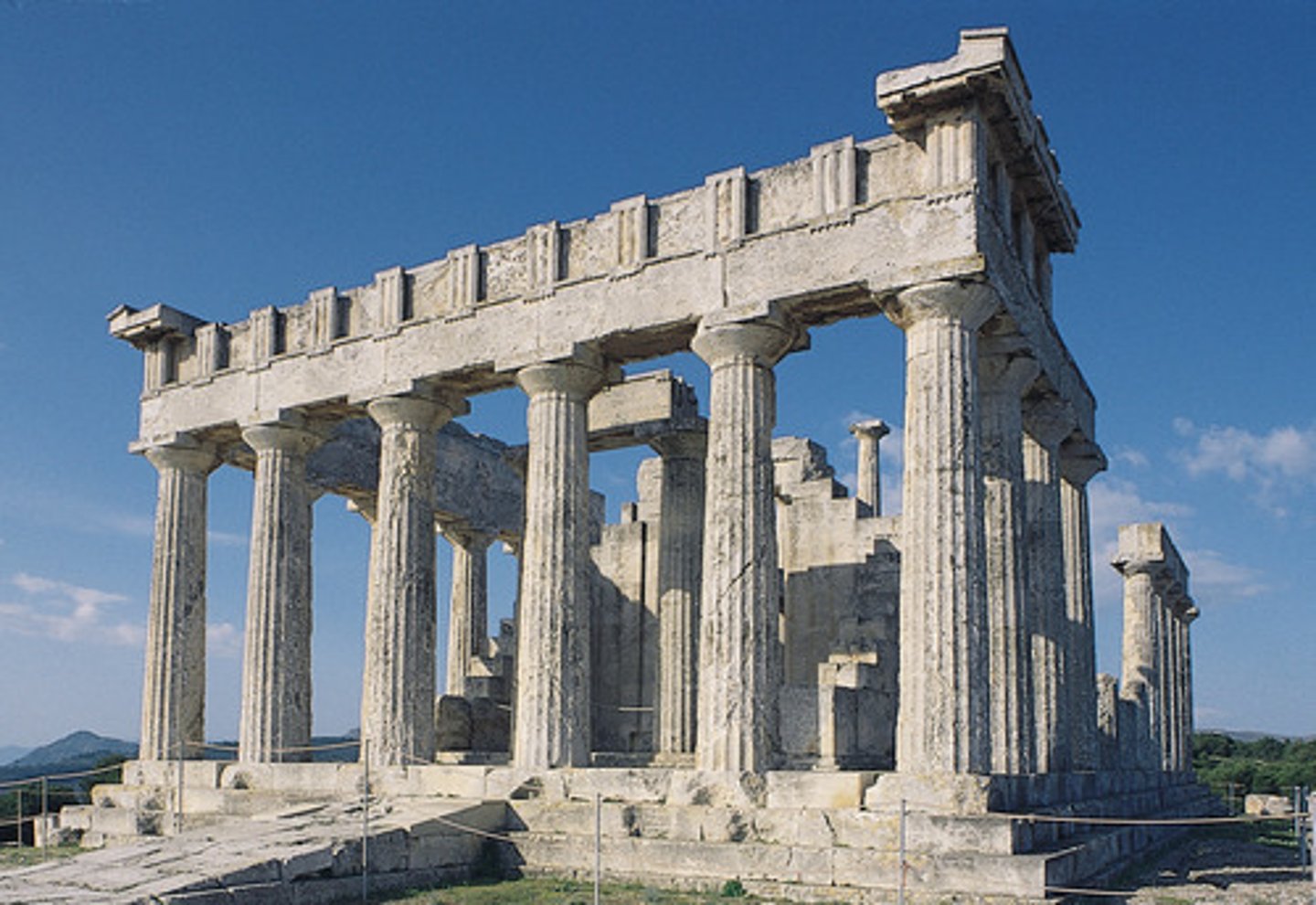
- Temple of Aphaia at Aegina
- 480-400 bce (severe/high-classical pd)
- exterior doric columns; columns are slimmer and lean inwards
- continued experiments in proportion and measurement
- aphaia is a version of aphrodite, depicted on pidements
- two pediments, likely made by two different workshops (west is stiff and angular, east is more naturalistic)

- East pediment from Temple of Aphaia
480 bce (severe style pd)
- at temple of aphaia at aegina
- more naturalistsic of the 2 pediments
- bodies are more twisted and posed in a realistic way

- West pediment from Temple of Aphaia
480 bce (severe style pd)
- at temple of aphaia at aegina
- more stiff and angular of the 2 pediments
- everything looks posed

- Temple of Zeus at Olympia
470-457/6 bce (severe style pd)
- founded by spoils of Elis' victory over Pisa
- architect was Libon of Elis
- built by blocks of local limestone covered with stucco
- doric style temple; biggest temple before the parthenon
- contained a large cult statue of zeus
- eventually collapsed
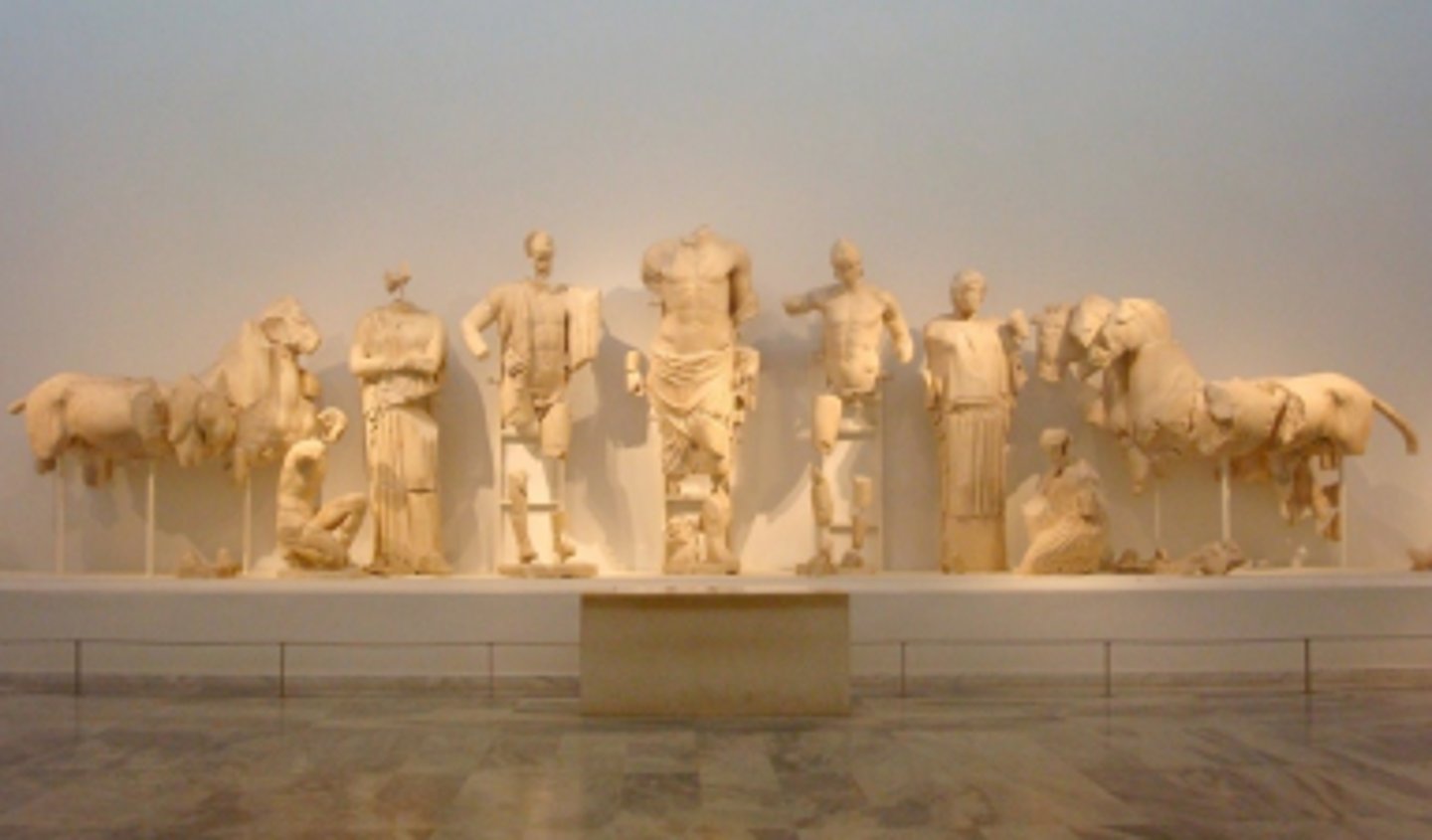
- East pediment from Temple of Zeus at Olympia
470-457/6 bce (severe style pd)
- scene of preparation for the charioteer race between pelops and king of pisa (oinomaos)
- 5 central figures (L-->R) are sterope, oinomaos, zeus, pelops, and hippodemeia
- king is looking for a husband for his daughter, makes them compete and always lose; pelops wins by cheating
- large zeus shows justice and that you're being watched by him when competing
- smaller figure in corners are cowering in fear from the central god
- figures laying down are personifications of rivers
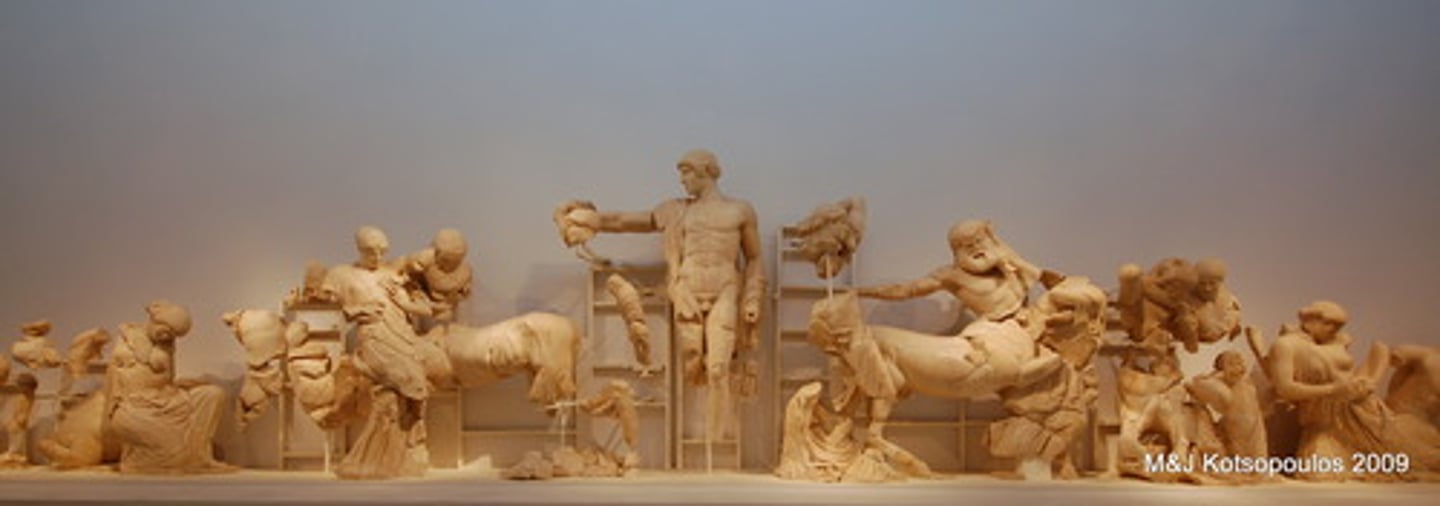
- West pediment from Temple of Zeus at Olympia
470-457/6 bce (severe style pd)
- scene of lapiths and centaurs fighting at wedding of peirithoos
- very chaotic; drunk centaurs attacking people
- central figure of apollo but unknown why (not linked to sanctuary or story)
- apollo shows loss of archaic smile and more severe facial expression
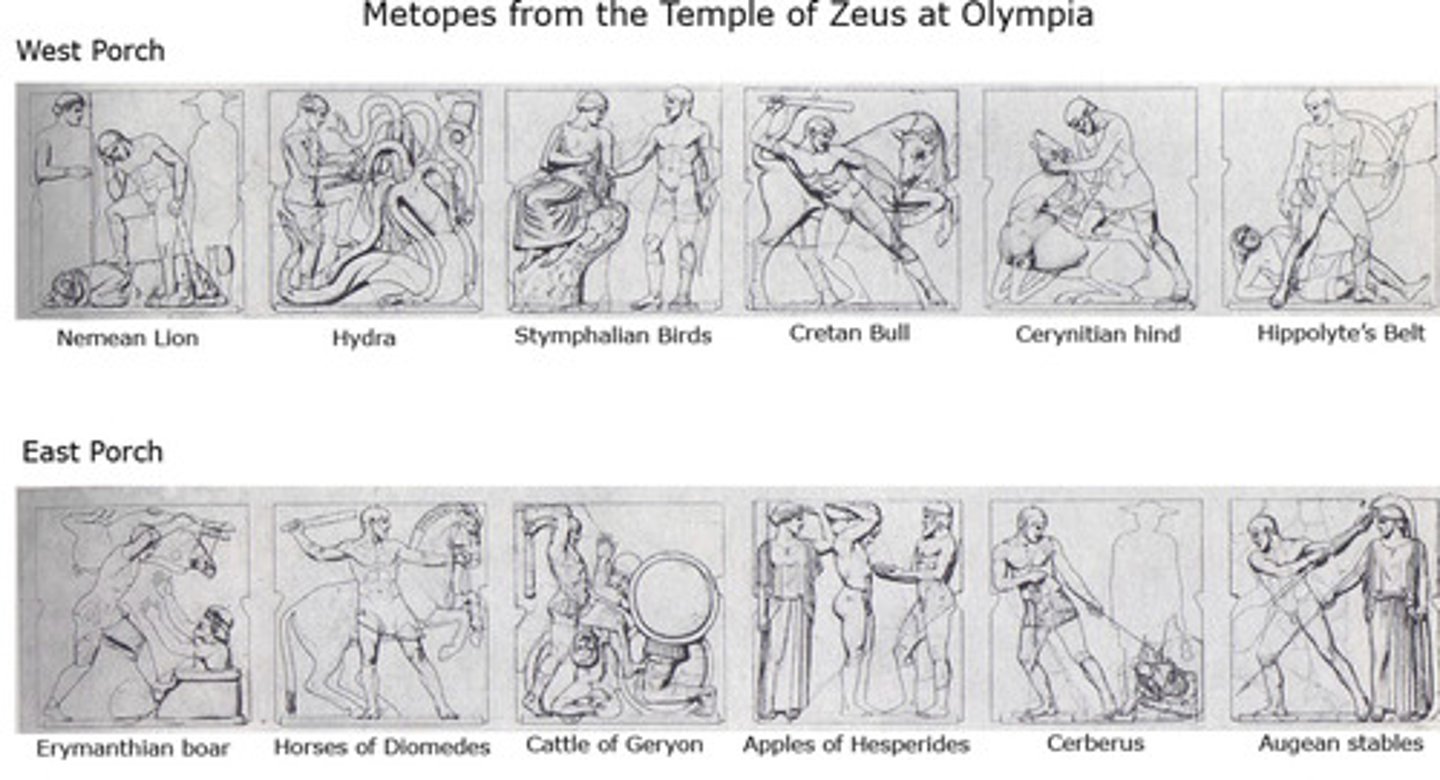
- Metopes from Temple of Zeus at Olympia
470-457/6 (severe style pd)
- 12 sculpted marble metopes placed above front and back porches
- depicted labors of hercules

- Temple E at Selinus
460-450 bce (severe style pd)
- at selinus (italy)
- more elongated than temple of zeus at olympia
- diverse metopes
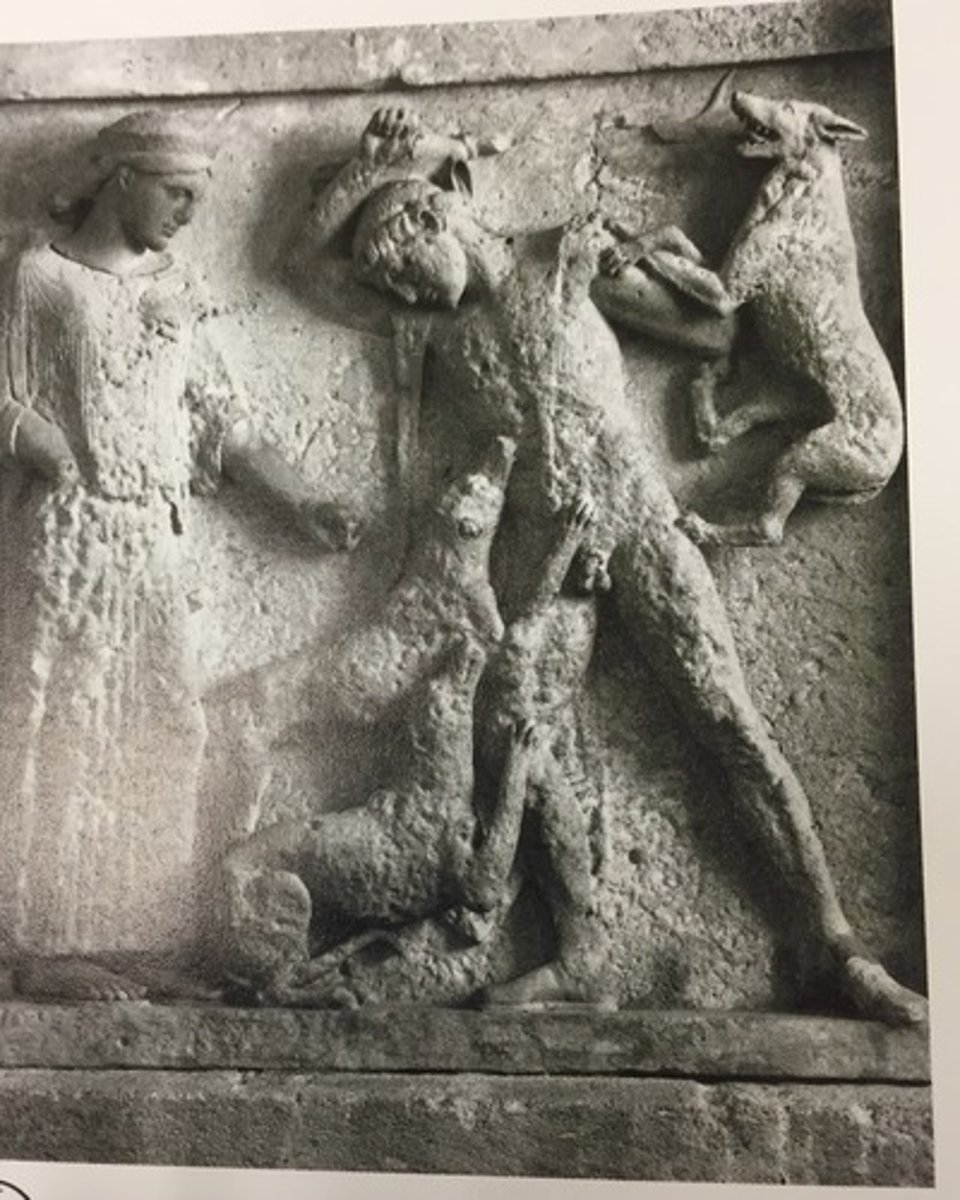
Metopes from Temple E
- 460-450 bce (severe style pd)
- at selinus (italy)
- ex. herakles fighting amazon, zeus and hera, & death of aktaion
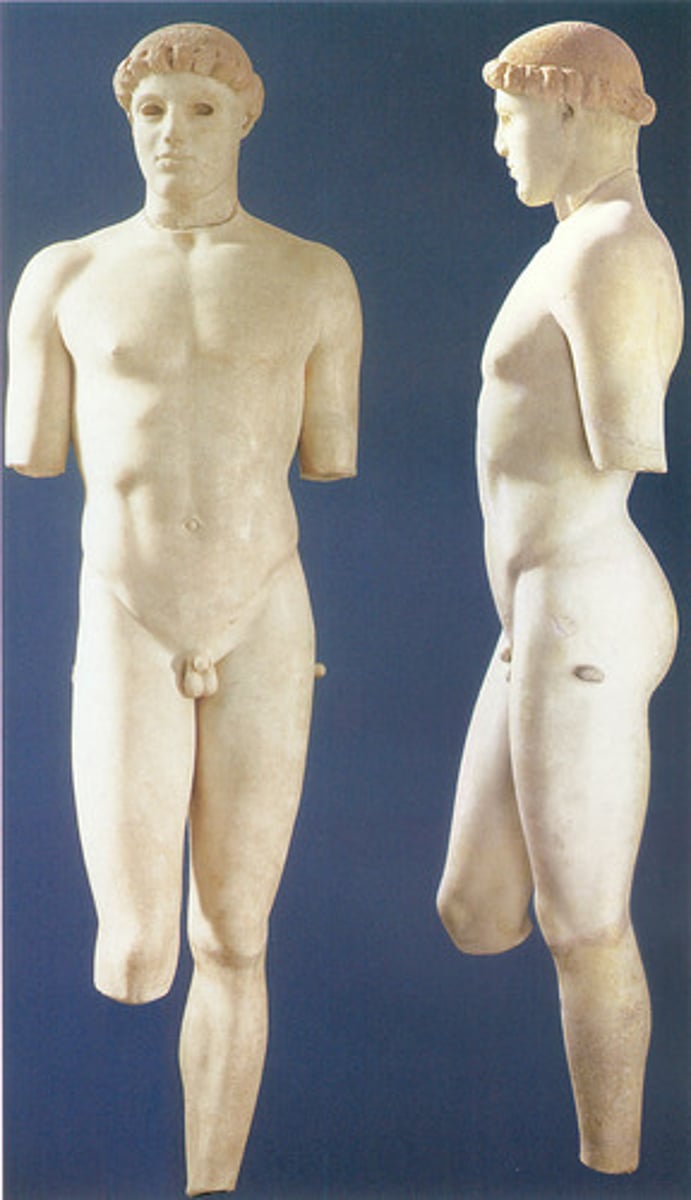
Kritios Boy
- 480 bce (severe style pd)
- from acropolis in athens
- created by kritios
- original marble, smaller than lifesize
- last of archaic kouroi, among the first of new figures in which movement of the body is organically explored
- early depiction of contrapposto
- face has big chin, flat cheeks, thick eyelids, and a composed expression, rolled hair (traits of severe style)
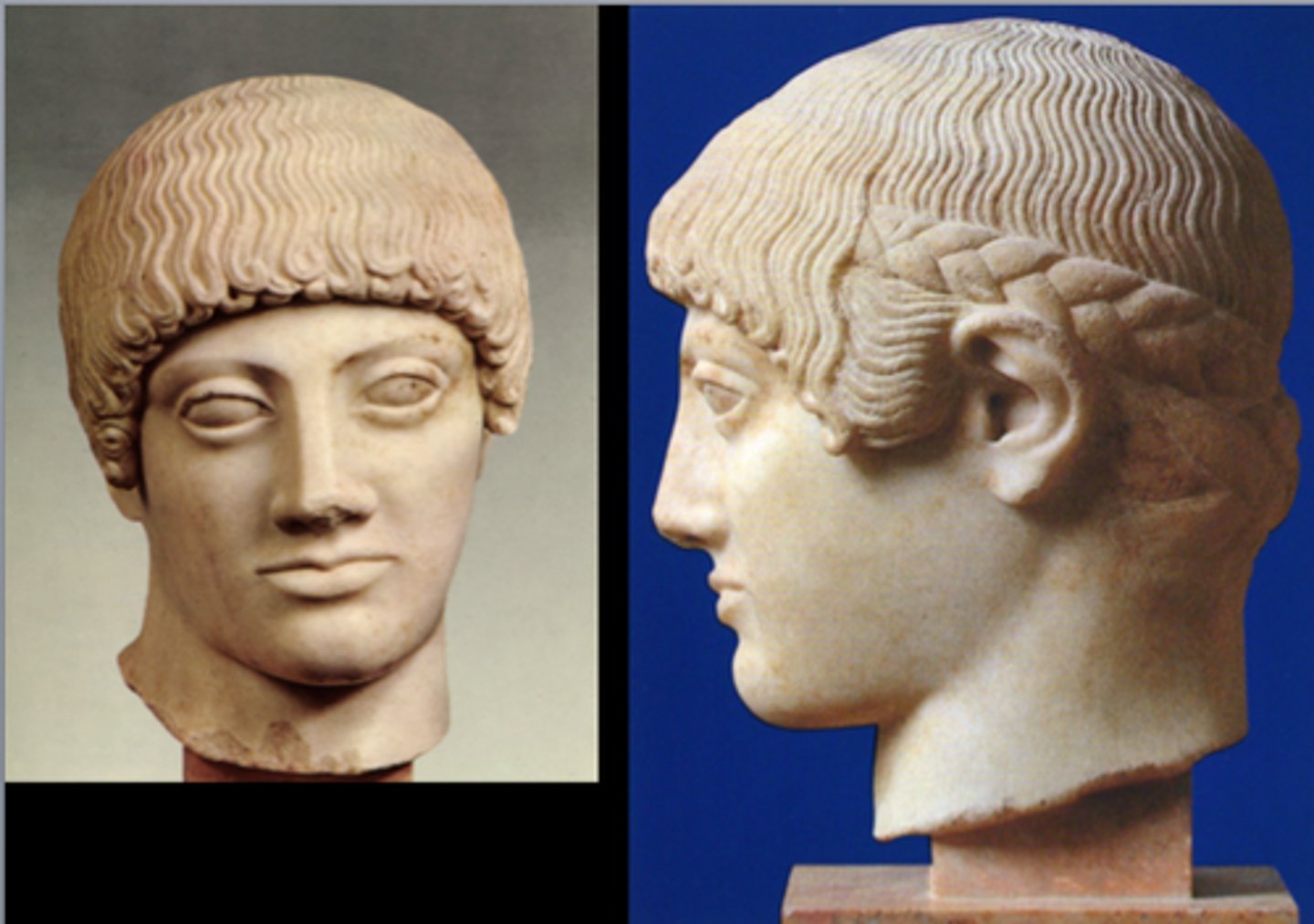
The Blonde Ephebe
- 485 bce (severe style pd)
- from acropolis in athens
- only head was found
- buried after war with the persians
- great example of severe style
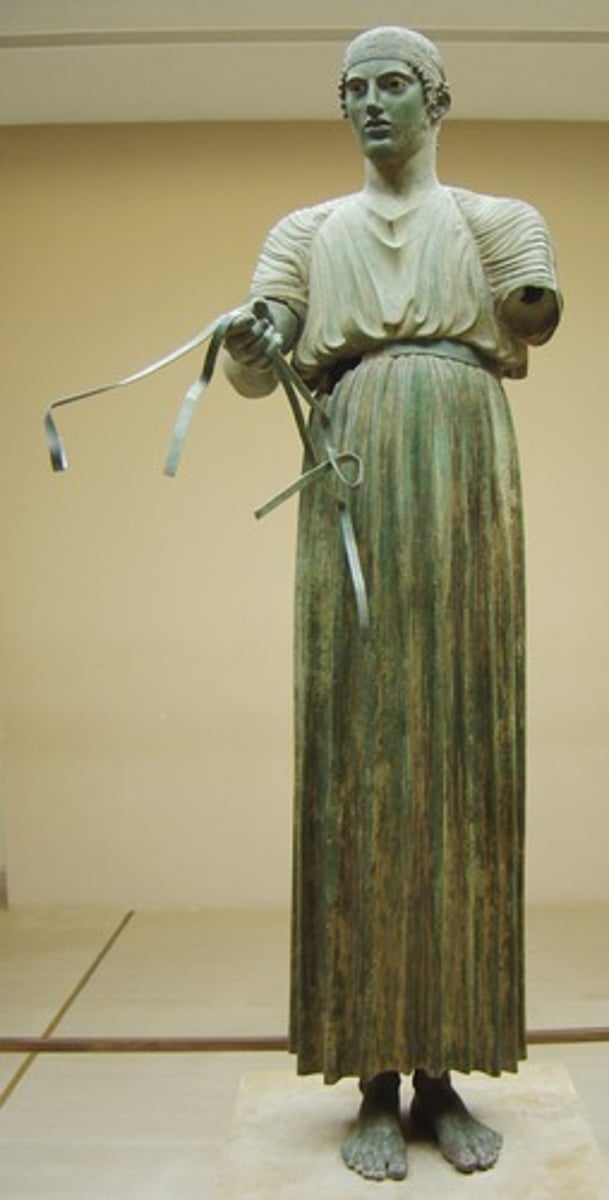
Charioteer of Delphi
- 478-474 bce (severe style pd)
- from sanctuary of apollo at delphi
- casted bronze; 8 separate pieces
- likely dedicated after a victory; likely a "thank you" for apollo
- originally part of larger group consisting of more horses and chariots
- severe style face, not able to see see anatomy underneath clothing
- eyes inlaid with glass; copper used on lips; silver used on teeth
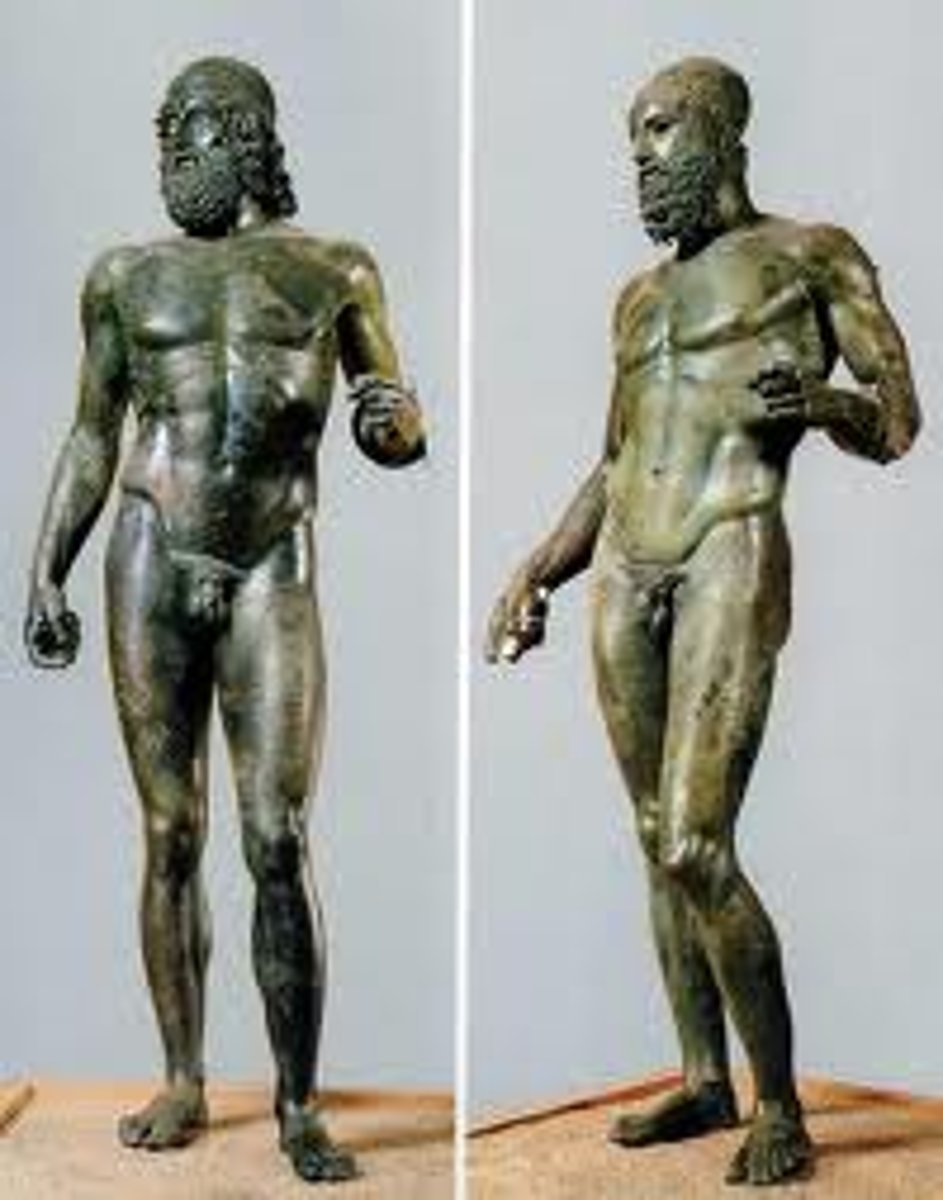
Riace Warriors
- 460-450 bce (severe style pd)
- original bronze from sea near Riace in south italy
- identity of figures is unknown
- shows advances in understanding of anatomy that goes beyond anything at olympia
- tells us how much we are missing (best pieces were likely in bronze, which were later melted down)
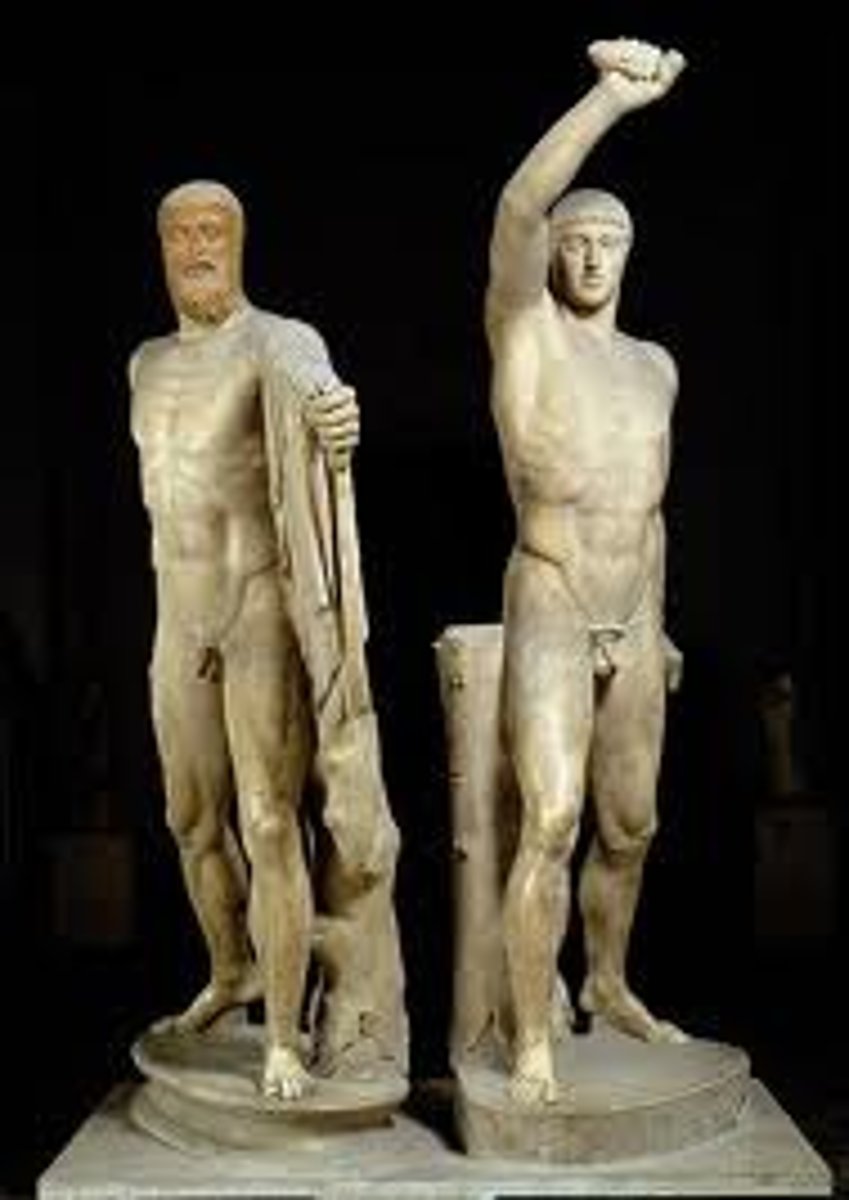
The Tyrannicides
- 477/76 bce (severe style pd)
- roman copy of originals by Kritios and Nesiotes
- dedicated in the agora in athens
- both figures have severe style face
- harmodios (right) and aristogeiton (left)
- older man (aristogeiton) lunges forward with one arm outstretched holding cloak & one arm back holding a weapon
- depicted lovers (common in greece for older men to have relations with younger boys
- decided to kill Hipparchus, brother of the tyrant (absolute ruler)
- one figure was replaced after original was stolen by persians

God from Artemision
- 460 bce (severe style pd)
- mostly bronze, survived because it was stolen
- unknown if its zeus of poseidon (holding a thunderbolt or trident?)
- figure is still fairly rigid and heavy, shows movement but not as well; limbs are very long
- commanding presence
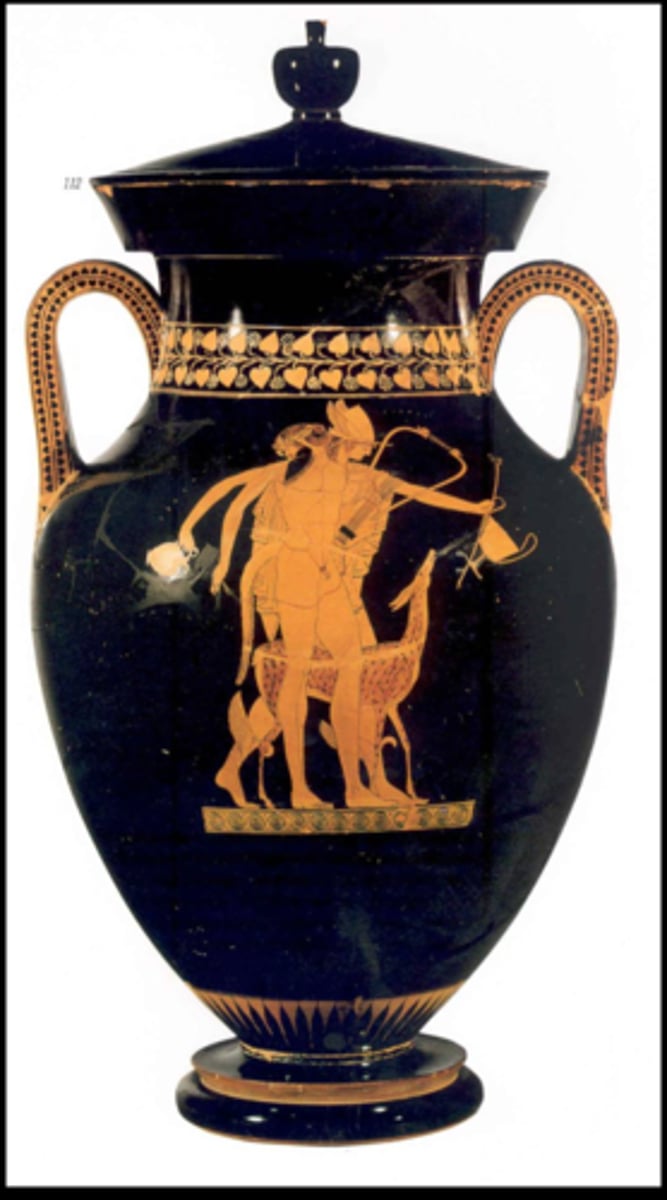
Berlin Painter
- 500-480/60 bce (severe style pd)
- attic greek vase painter who is widely regarded among one of the most talented of the 5th century
- common depiction of isolated characters
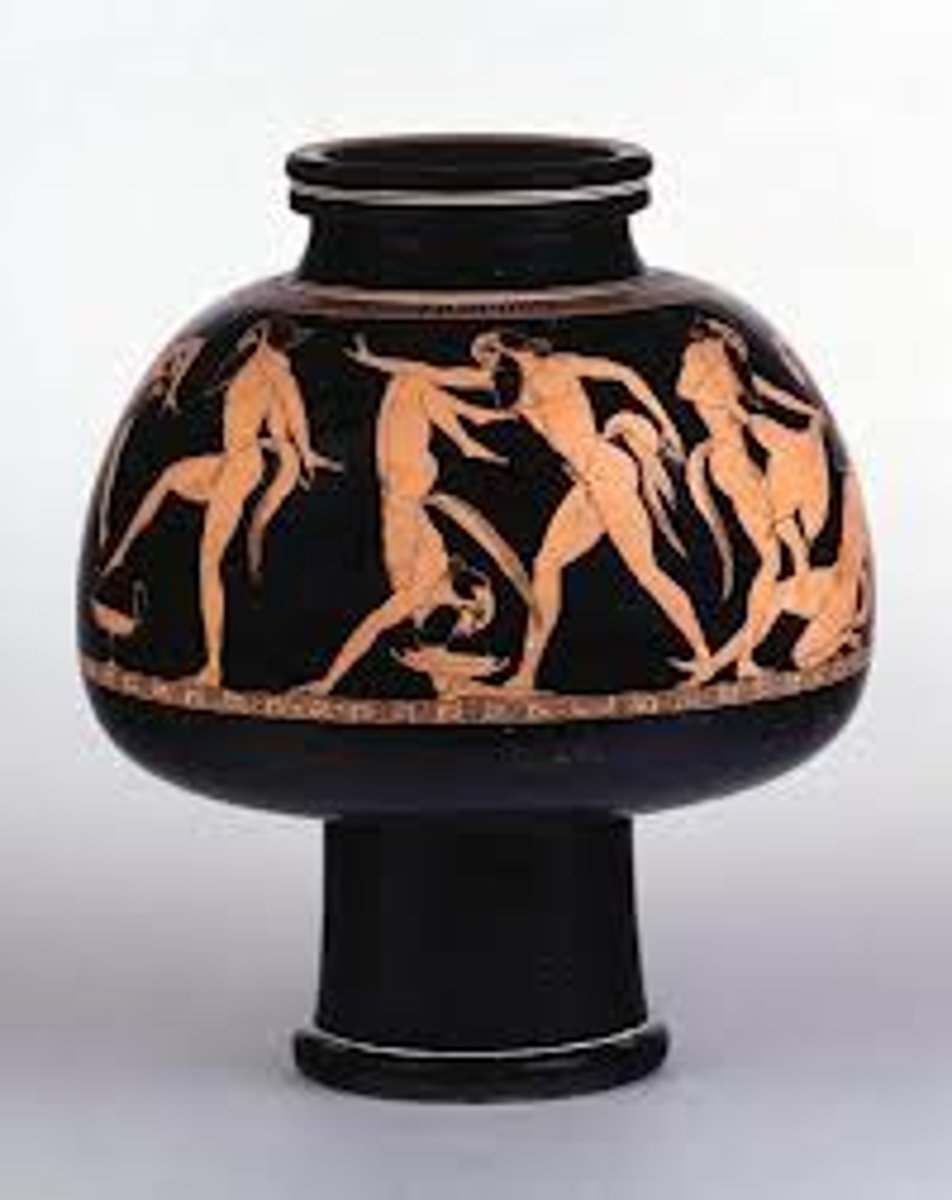
Psykter
- 500-460 bce (severe style pd)
- psykter by Douris
- used to cool wine
- depicts symposium of satyrs (followed dionysos, god of wine)
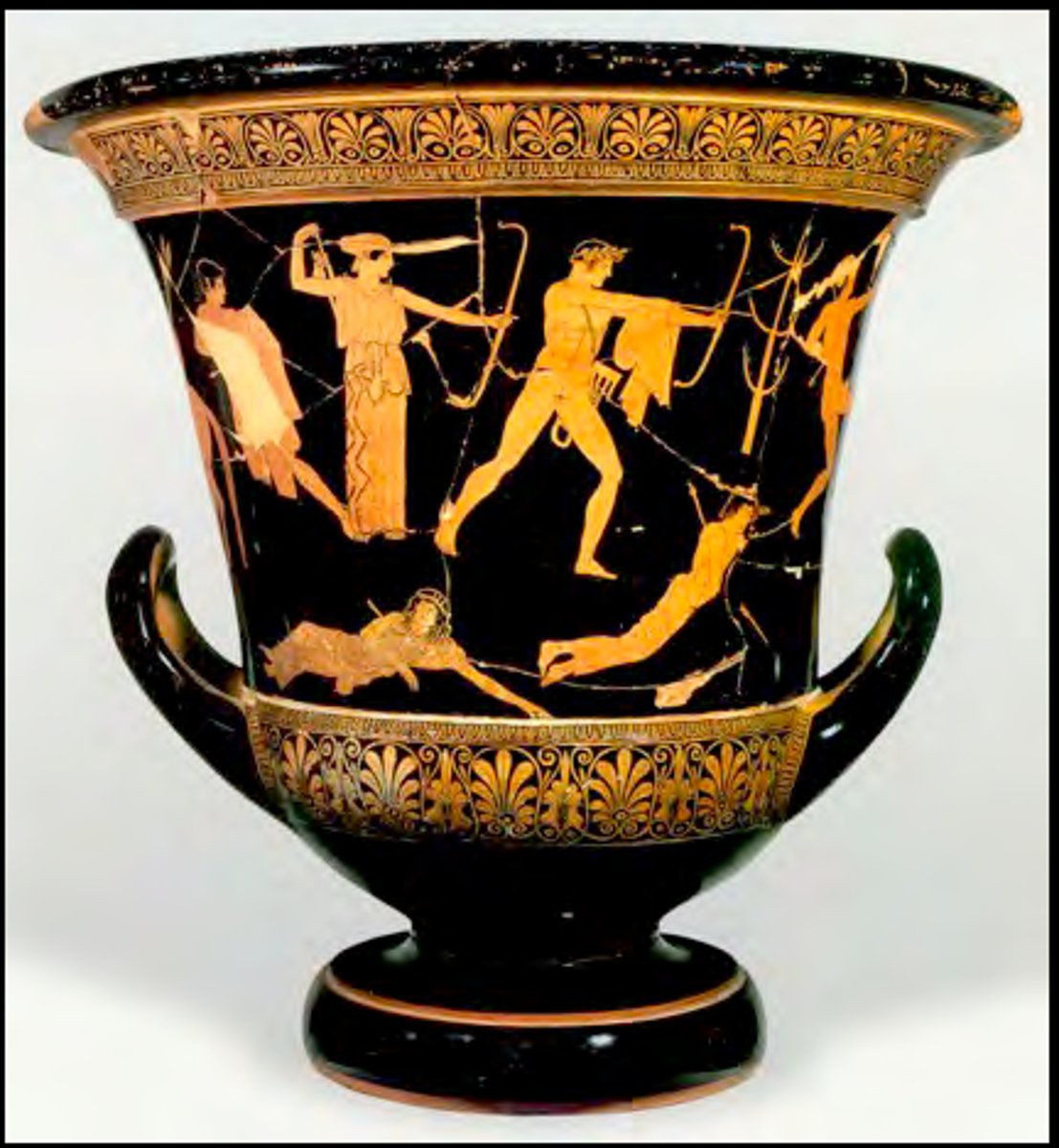
Attic red figure calyx krater
- 460-450 bce (severe style pd)
- by noibid painter
- depicts apollo and artemis slaughtering the children of niobe, who boasted the number of her children to the goddess Leto (who only had 2)
- reverse of krater shows herakles, athena, and other heroes
- figures distributed in various postures and multiple groundlines
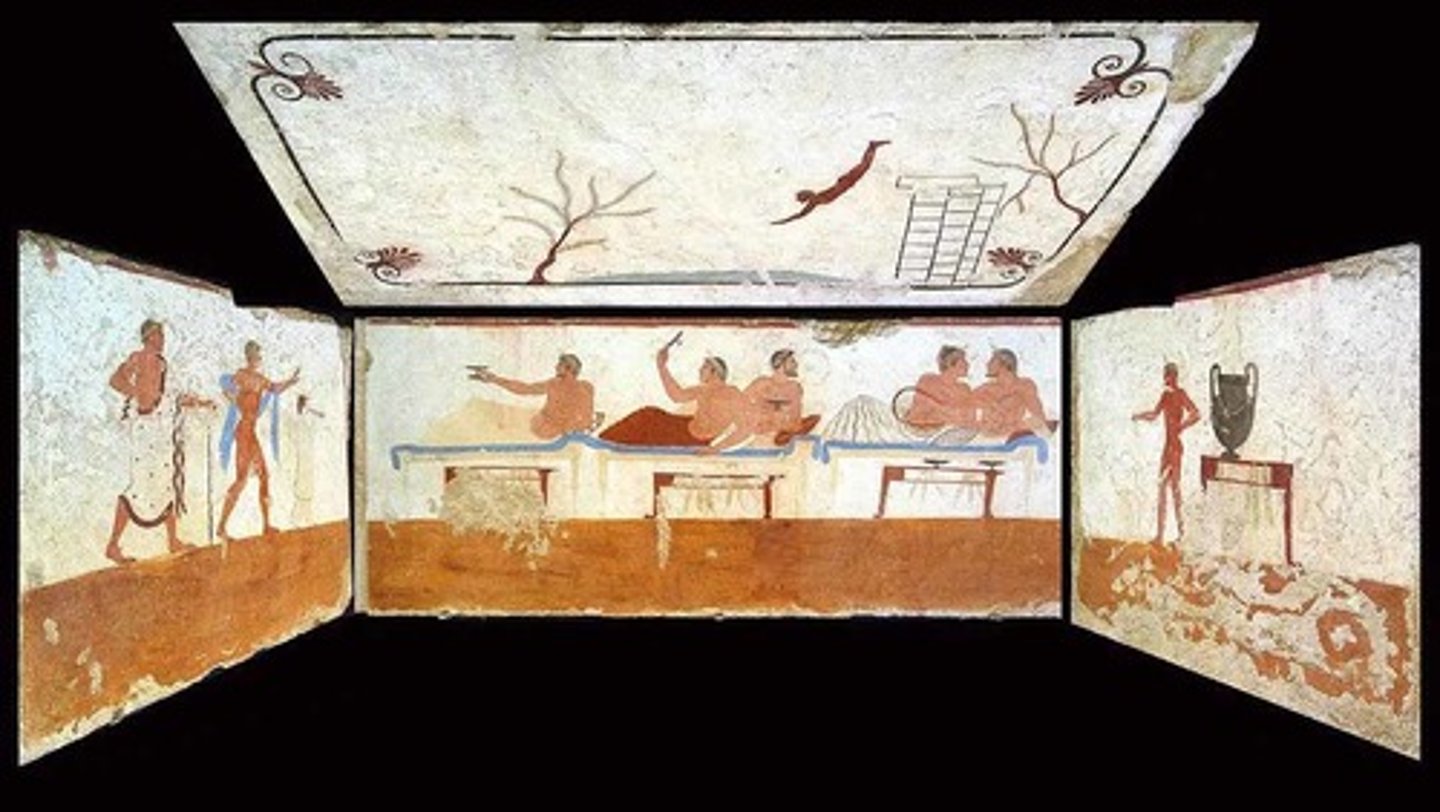
Tomb of the Diver
- 480 bce (severe style pd)
- from poseidonia
- painted stucco on travertine slabs
- depicts scene of typical symposium on its 4 sides; scene of diver on underside of the ceiling
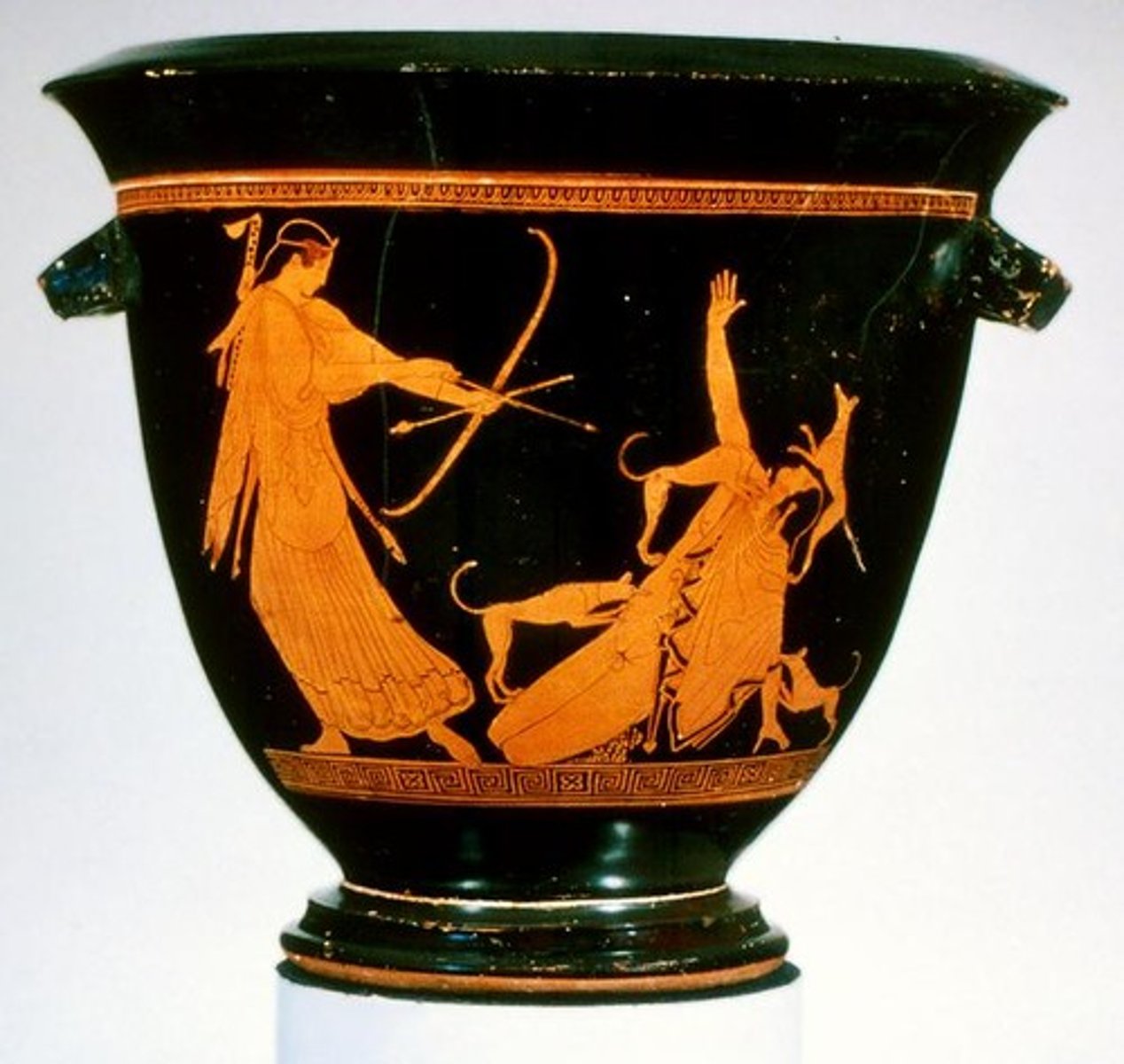
Attic red figure bell krater
- 470-460 bce (severe style pd)
- by Pan Painter
- depicts death of aktaion; artemis is drawing her bow to deliver grace to aktaion, whose dogs attack him
- little exploration of space
- pouty lips, small ear, eye rendered as a dot
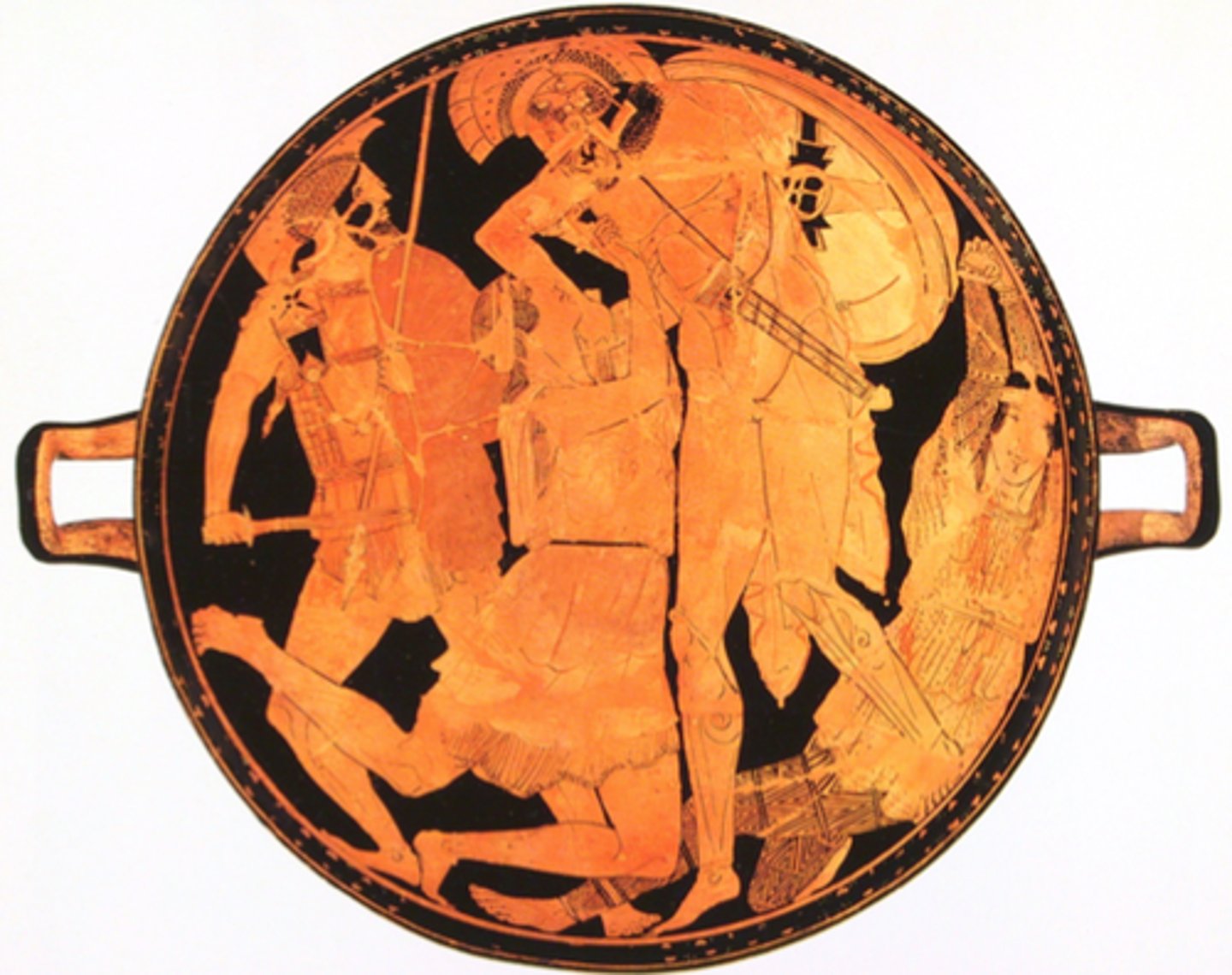
Penthesilea Painter
- 470-460 bce (severe style pd)
- bowl from italy
- depicts slaying of penthesilea by achilles
- work is charcterized by large, space filling figures with bent postures to fit within on the vessel
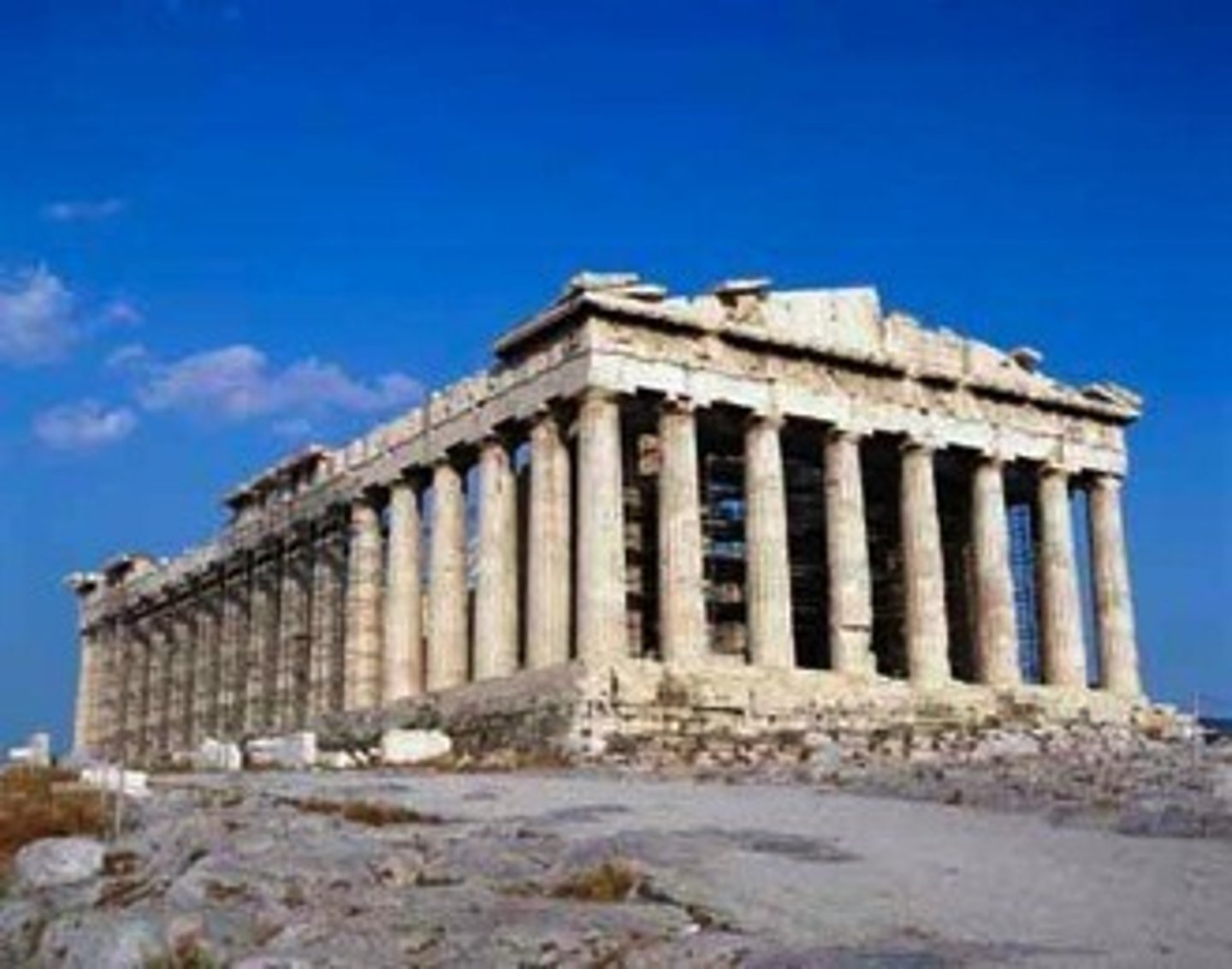
the parthenon
- 447-432 bce (high classical period)
- doric temple (with ionic features) built in athens
- built by iktinos & kallikrates
- exterior columns were doric, interoir columns were ionic
- contained statue of athena
- curved taper of columns (entasis)
- 92 total metopes, 2 pediments, & one large frieze going across entire building
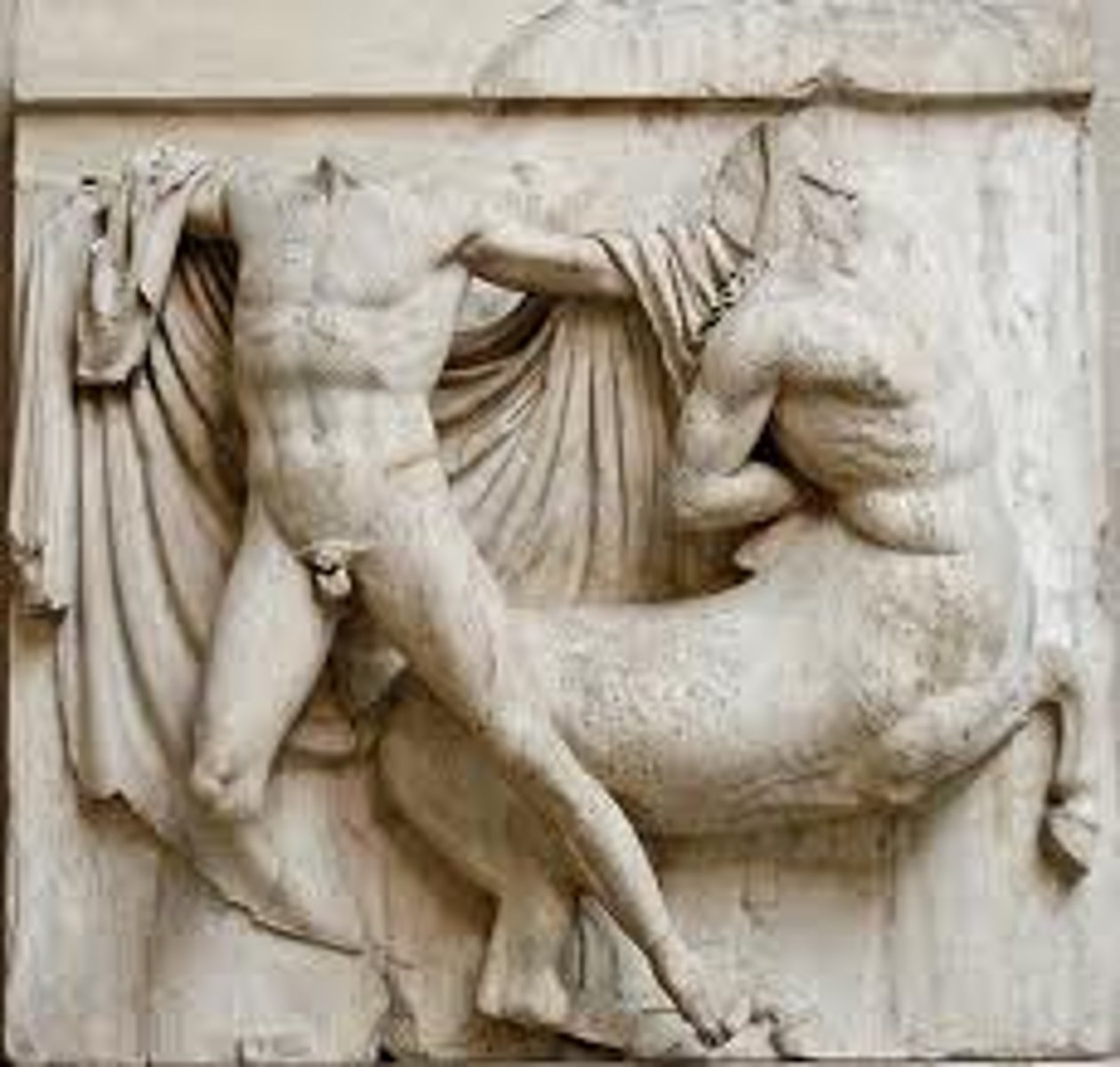
parthenon metope
- 447-440 bce (high classical period)
- from parthenon in athens
- depicts struggle between lapith and centaur

parthenon frieze
- 442-438 bce (high classical period)
- from parthenon in athens
- position made it impossible to see, so maybe an afterthought?
- scenes of horsemen preparing, deities sitting, peplos scene, and various other human & animal figures
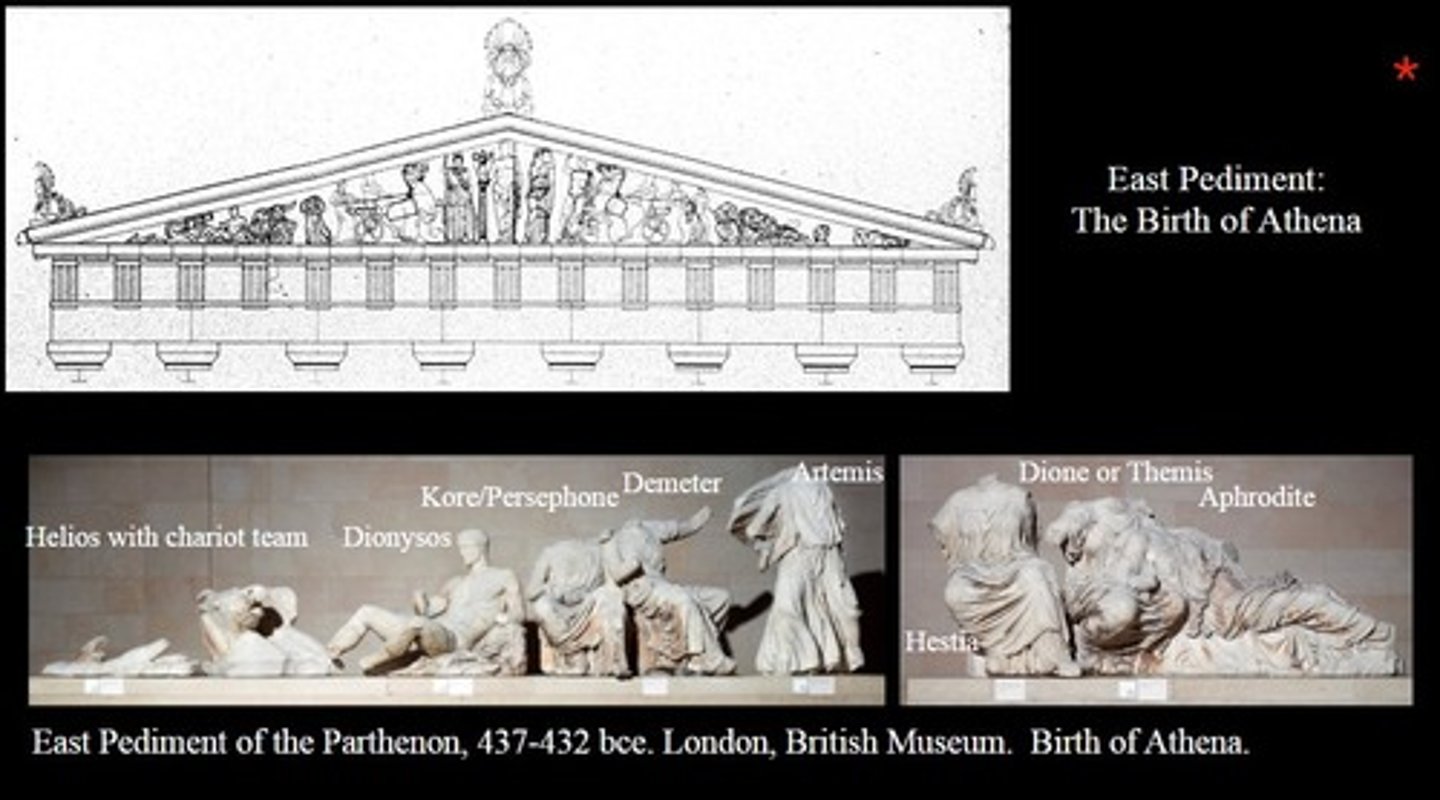
east pediment of parthenon
- 437-432 bce (high classical period)
- from parthenon in athens
- depicts birth of athena from her father's head, zeus
- joined by hephaistos and hera
- shown at dawn due to emerging horse heads
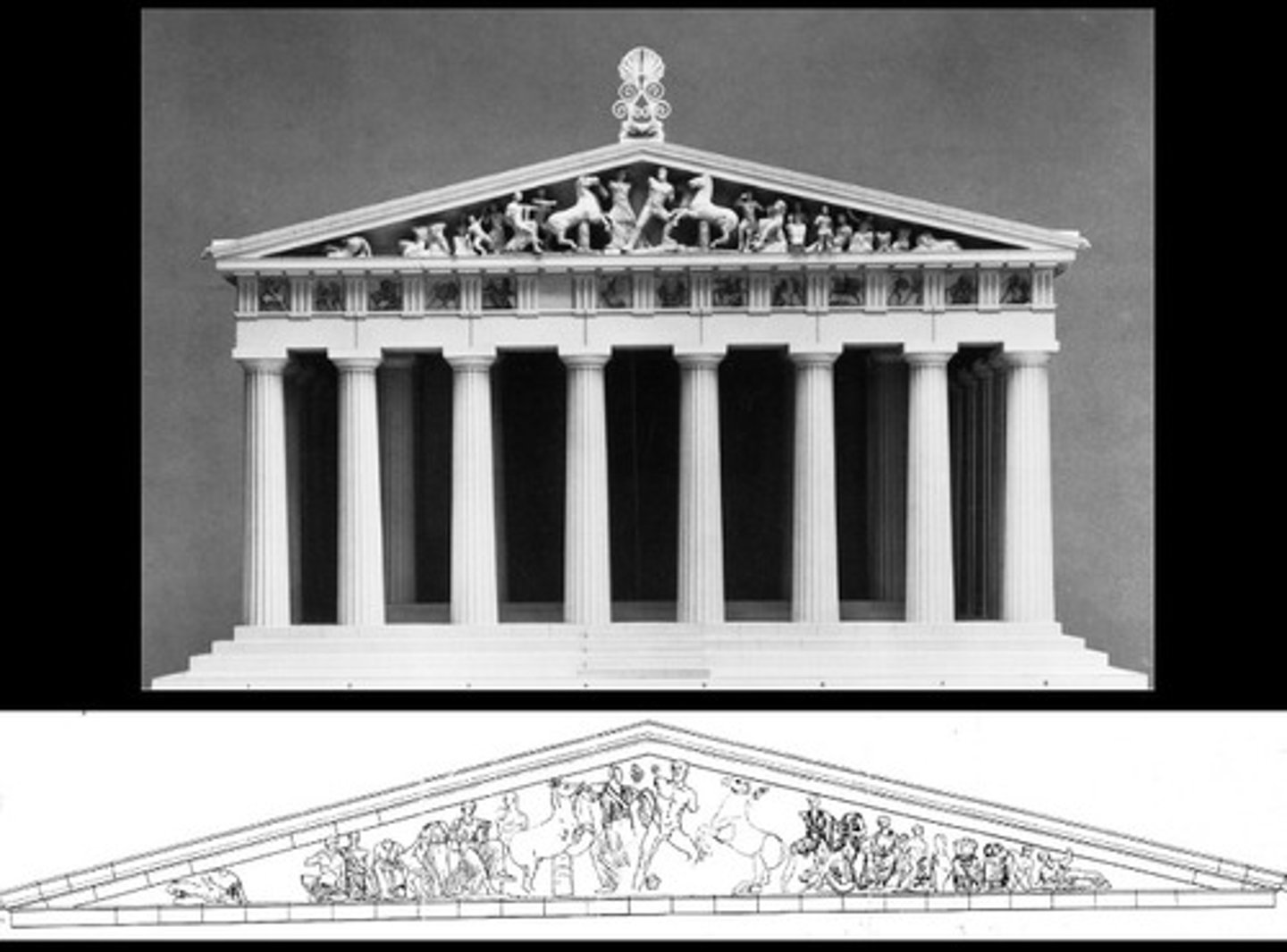
west pediment of parthenon
- 437-432 bce (high classical period)
- from parthenon in athens
- depicts contrast between athena & poseidon as to who will be patron deity of athens; chariot groups on either side
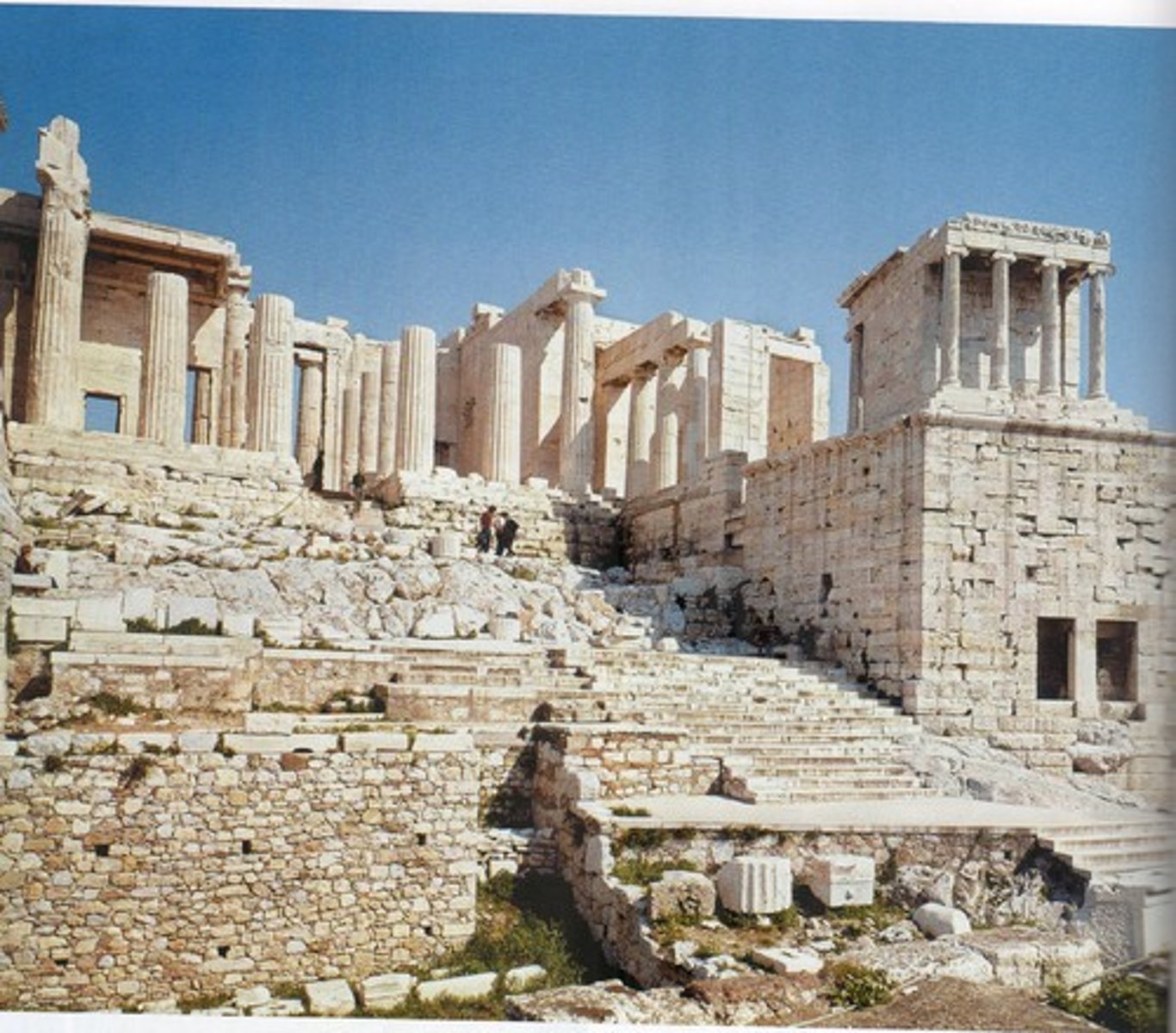
the propylaea
- 437-432 bce (high classical period)
- enterance to acropolis in athens
- built by mnesikles
- doric columns on exterior & ionic columns on either side of main passage on interior
- large staircases & ramp for animals
- two rooms on either side, thought to be for displaying paintings (debated)
- entrance leads directly to altar
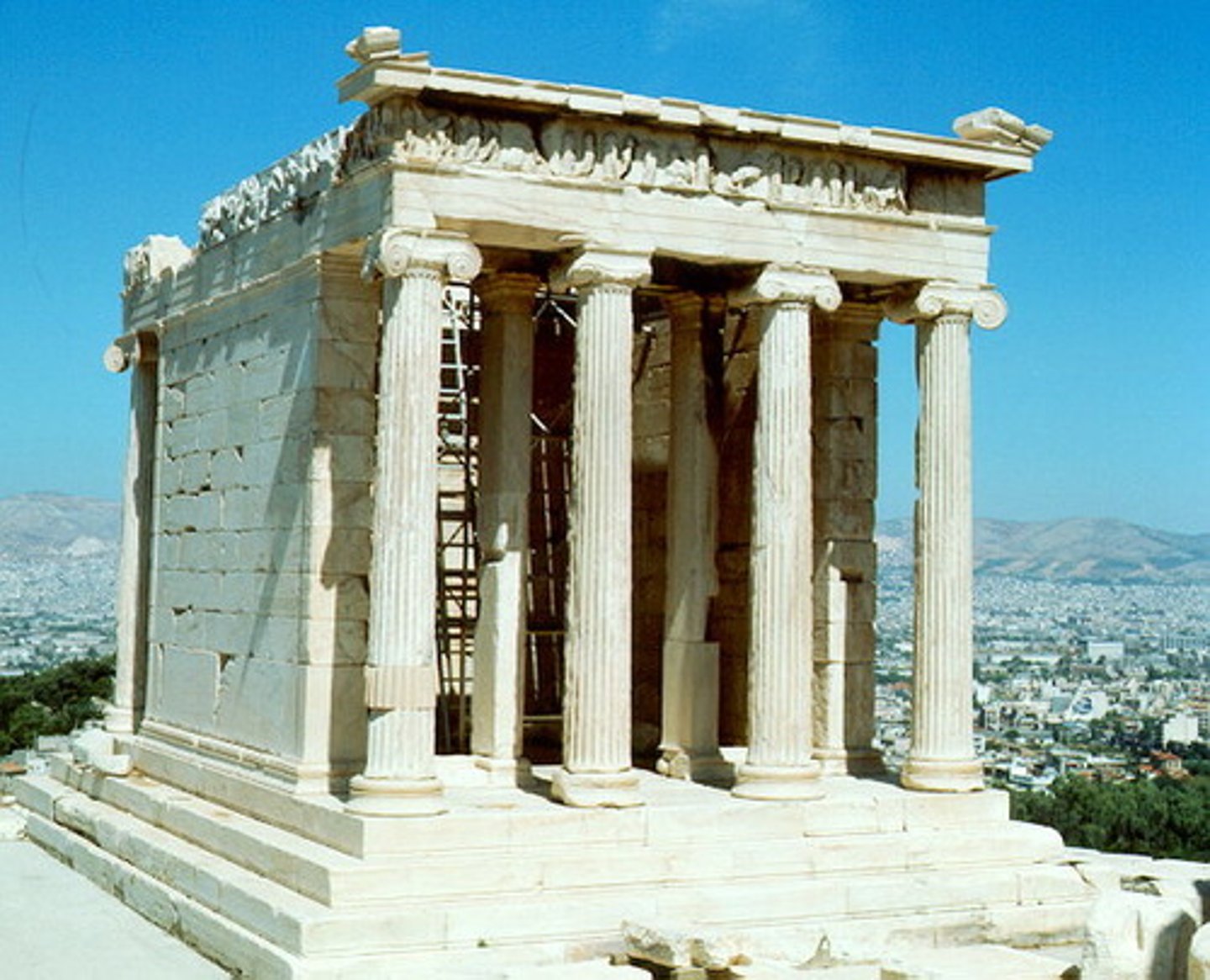
temple of athena nike
- built between 426-421 bce (high classical period)
- at acropolis in athens
- designed by kallikrates (same architect from parthenon)
- uses ionic columns to contrast with the rest of the gateway
- east frieze has congregation of divinities; south frieze has greeks fighting persians; west frieze had greeks fighting greeks (all are fights/wars, fitting as "nike" means victory)
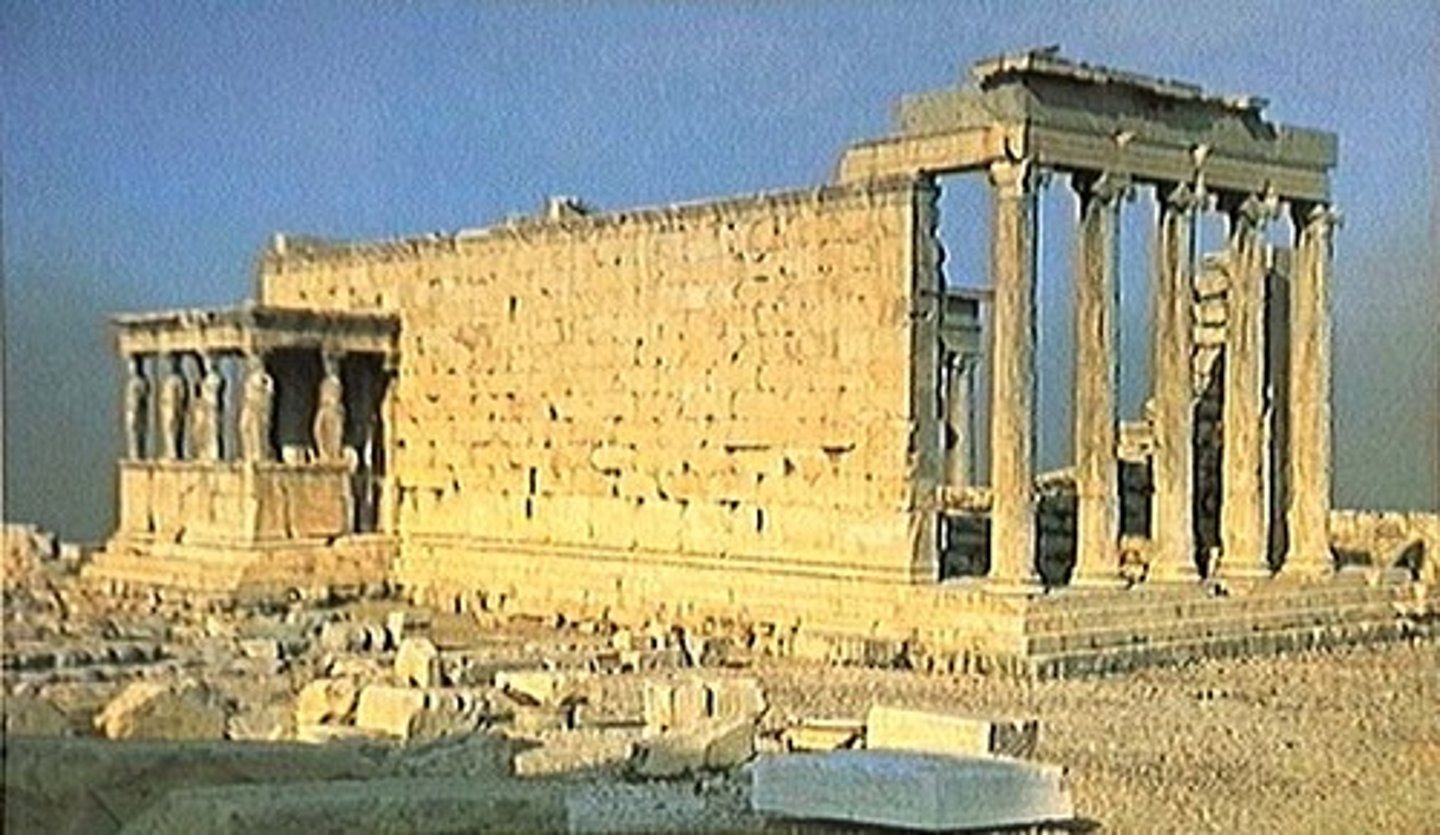
the erechtheion
- built 430-405 bce (high classical period)
- at acropolis in athens
- designed by mnesikles
- ionic temple with some doric elements
- peculiarly shaped temple
- large front enterance & smaller side enterance
- has walls with windows (rarely seen)
- features 6 columns in the shape of women (caryatid); votive statues that paid homage to the king of athens
- had wooden statue of athena made from an olive tree
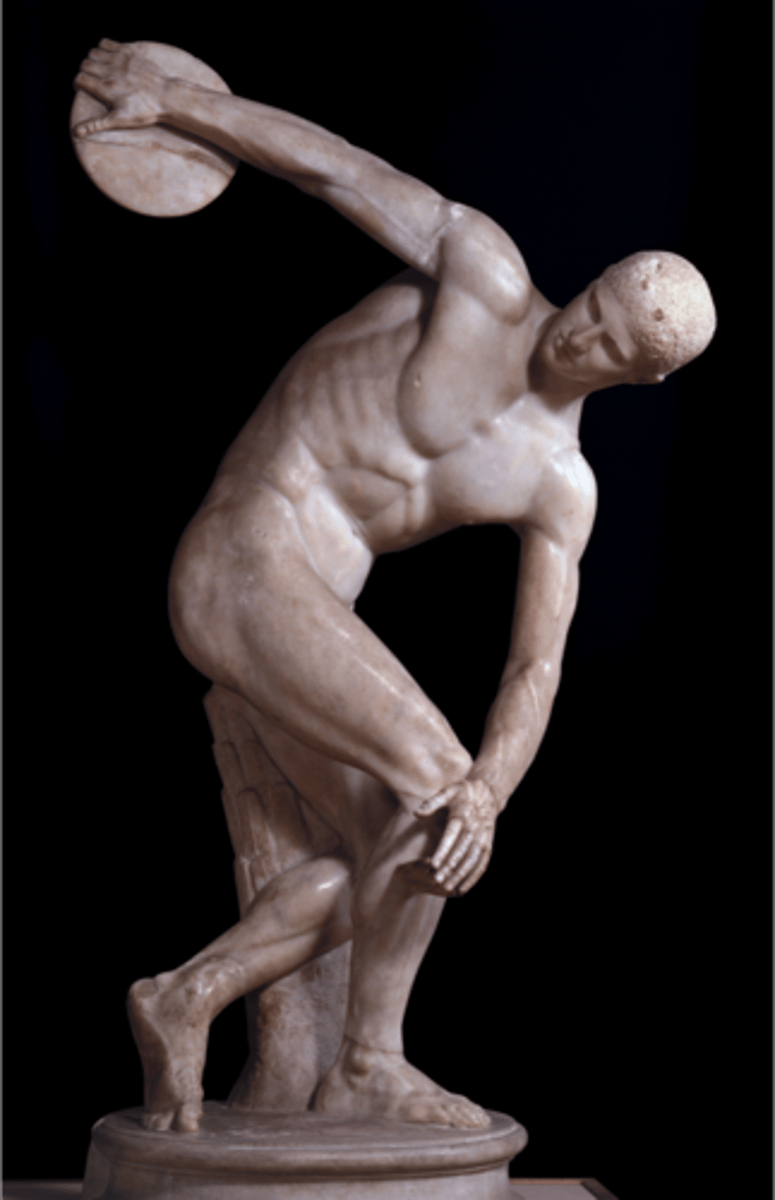
diskobolos by myron
- 450 bce (high classical period)
- from athens
- famous sculptor Myron
- new and unexpected pose
- hairstyle seems old-fashioned and reminiscent of heads from olympia
- pictured is a marble roman copy of the greek bronze original
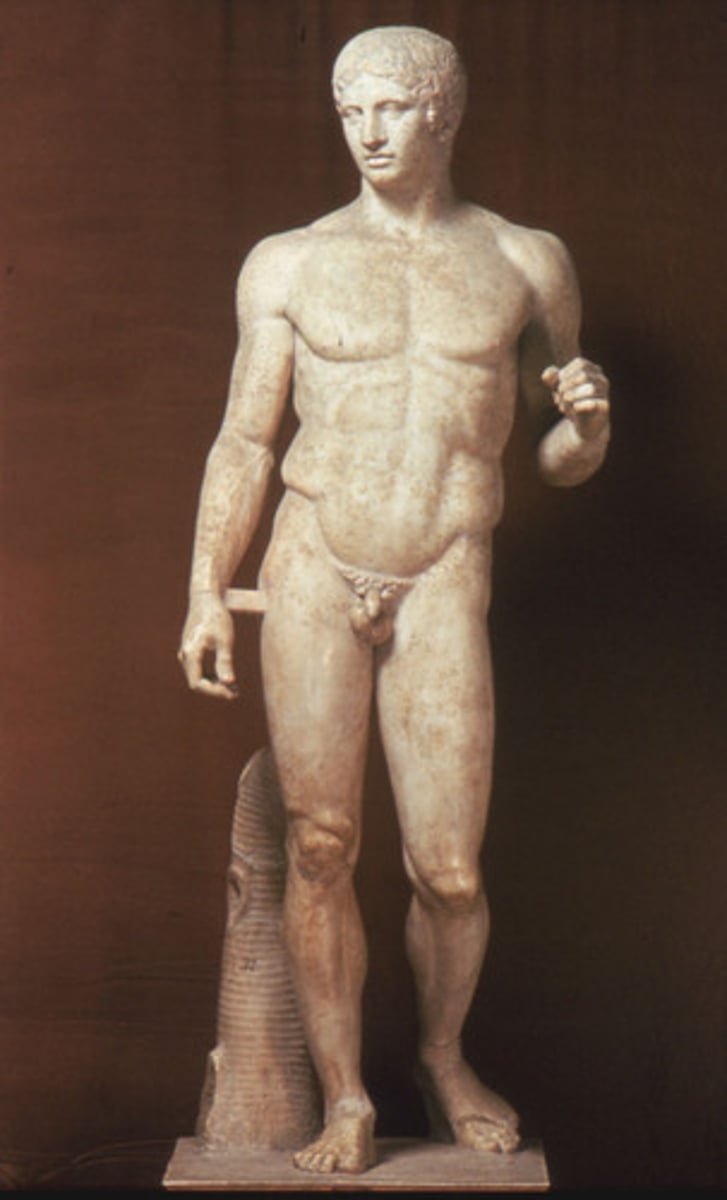
doryphoros of polykleitos
- 450-440 bce (high classical period)
- from pompeii (italy)
- famous sculptor Polykleitos
- statue exemplifies Polykleitos' book The Kanon
- role of statue is unknown (votive? funerary? unknown)
- figure is unknown, though likely achilles
- in a "walking stance" since back foot is almost completely off the ground
- holding spear but not attacking, depicts debate between attention vs relaxation
- pictured is a marble roman copy of the greek bronze original
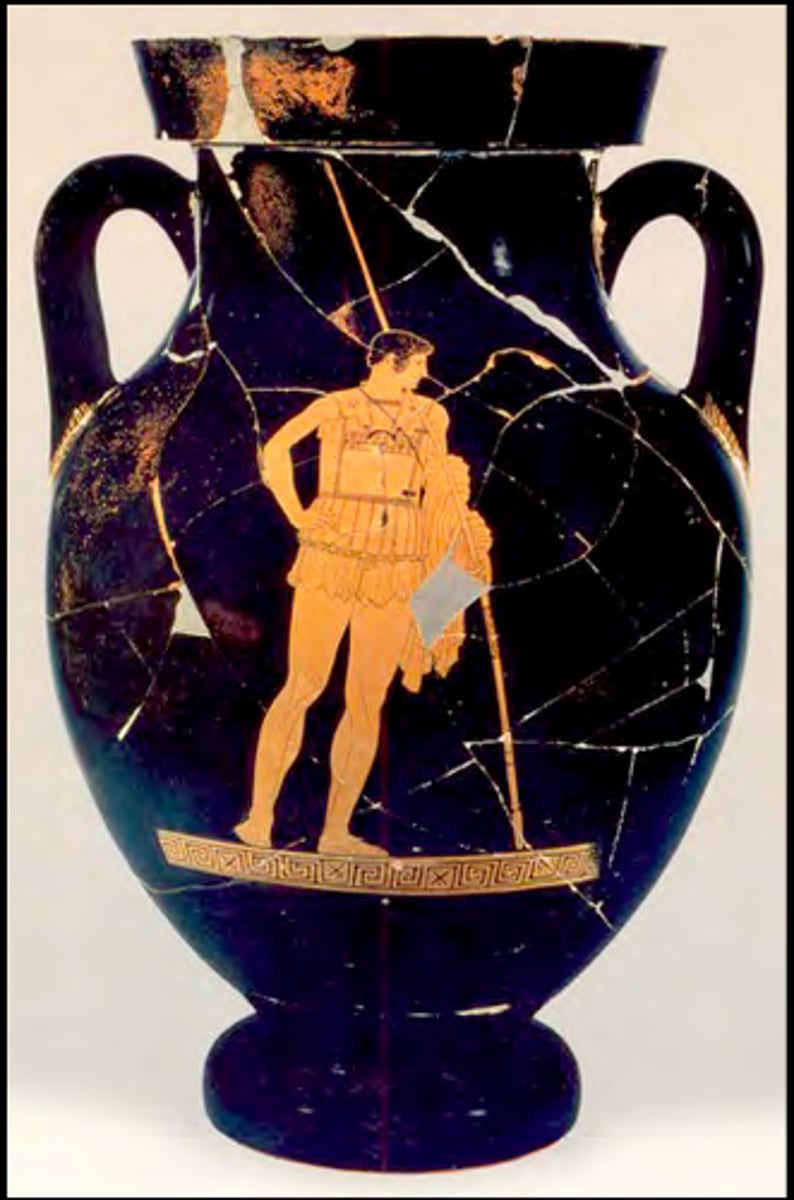
amphora by achilles painter
- 460-420 bce (high classical period)
- from athens
- made by achilles painter
- red-figure amphora
- figure is very similar to Doryphoros by Polykleitos, achilles maybe?
- fully clothed by genitals are still visible (idea of showing the body, "heroic nudity")
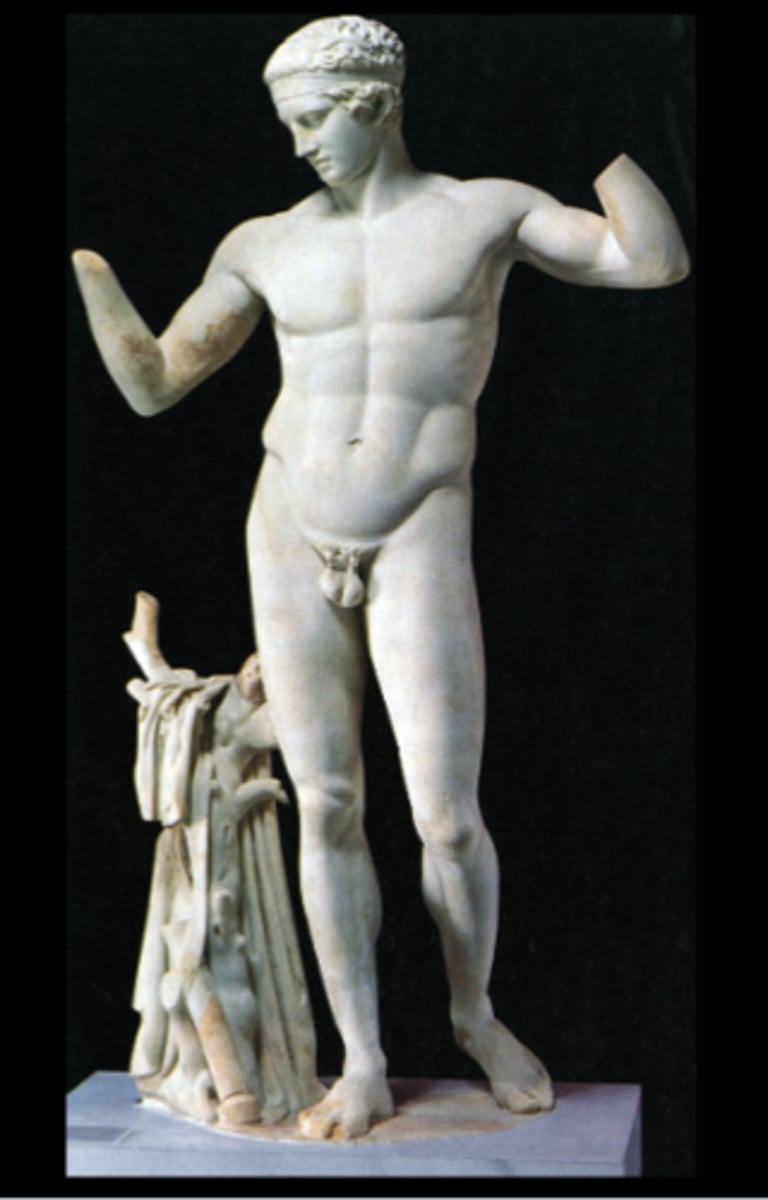
diadoumenos by polykleitos
- 430 bce (high classical period)
- from delos (cyclades)
- famous sculptor Polykleitos
- arms held high to tie ribbon around his head
- thought to be apollo or just an athlete
- very casual, shows relaxation after victory
- pictured is a marble roman copy of the greek bronze original
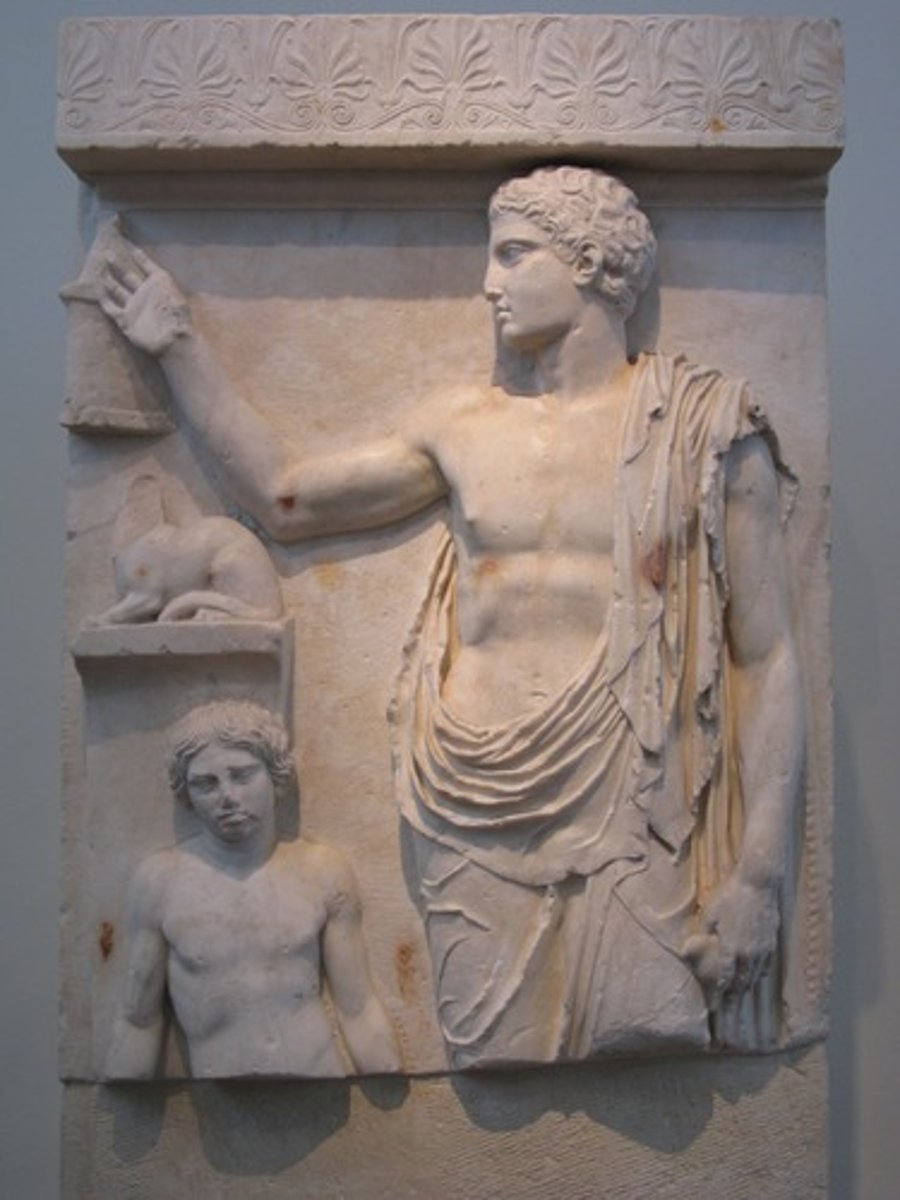
Cat Stele
- 430 bce (high classical period)
- from aegina
- used as a grave marker
- depicts dead youth accompanied by a mourning boy attendant and a cat sitting on top of a stele
- above cat is a birdcage, where the boy reaches while holding a bird in his other hand
- evokes style of parthenon figures by youth's rounded skull, small mouth, large eye, unruly hair, and faraway expression (not severe style)
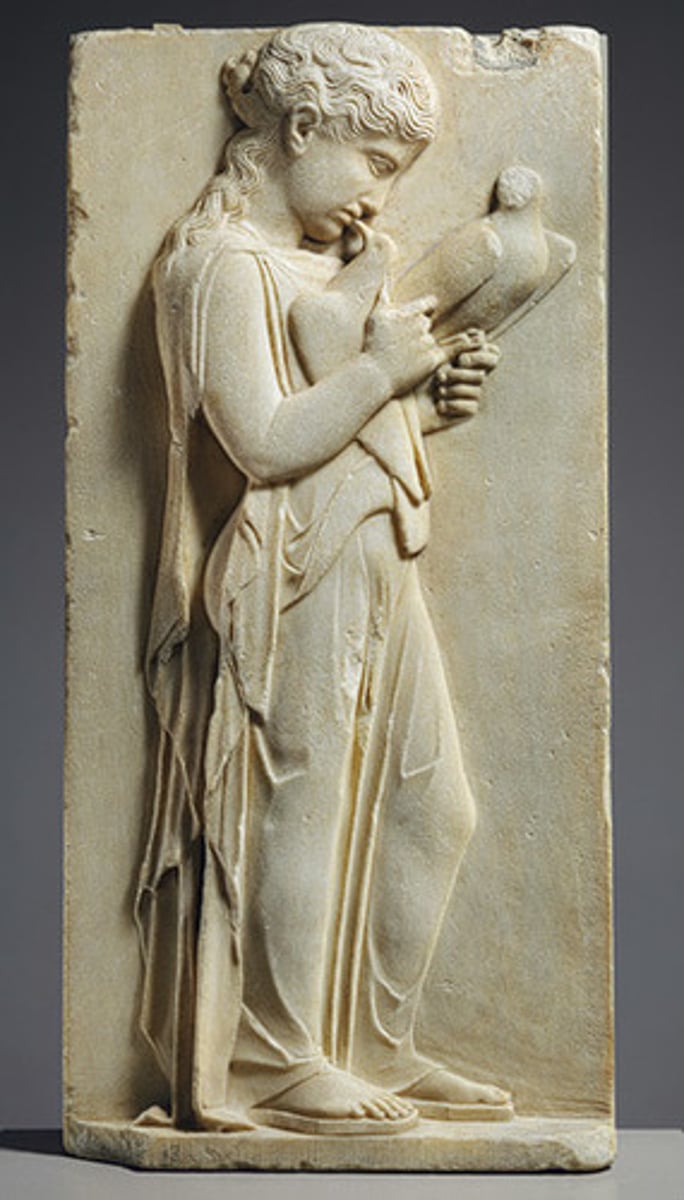
grave stele from paros
- 450-440 bce (high classical period)
- from paros (cyclades)
- used as a grave marker
- depicts young girl holding birds, almost kissing one
- children were often depicted with their pets on steles

grave stele for hegeso
- 410-400 bce (high classical period)
- from kerameikos cemetery in athens
- used as a grave marker
- figure of hegeso is picking jewelry our of a box with assistance from a servant
- garments exemplify transparency of 5th century
- faces are emotionally inexpressive
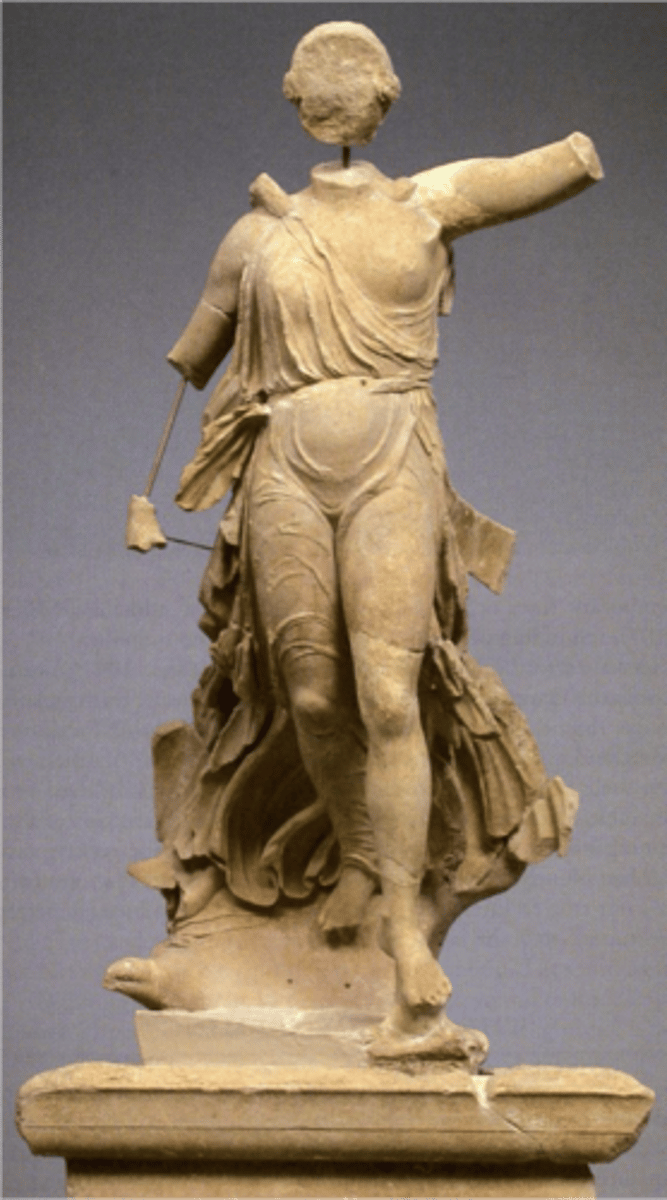
nike by paionios
- 420 bce (high classical period)
- from olympia
- sculptor Paionios
- placed as akroteria on top of tall monument/column
- depicts moment of touching down, still hovering in flight with wings
- dedicated to celebrate the military victory of messenians and naupaktians, flying in to crown the winning city

meidias painter hydria
- 420-390 bce (high classical period)
- from athens
- made by Meidias painter
- very large hydria, likely monumental and not for practical use (likely wedding gift)
- main register depicts Dioskouroi and their chariots arriving to carry off the stolen daughters of Leucippos; approved by gods as zeus and hera are sitting nearby
- lower register depicts herakles in the garden of Hesperides (daughters of the evening) with golden apple tree
- setting is sanctuary of aphrodite

Temple of Apollo Epikourios
- 429-427 bce (late classical period)
- from archaeological site at Bassae of Phigaleia
- made by Ictinus
- Earliest known example of a Corinthian Capital
- Doric exterior, Ionic interior
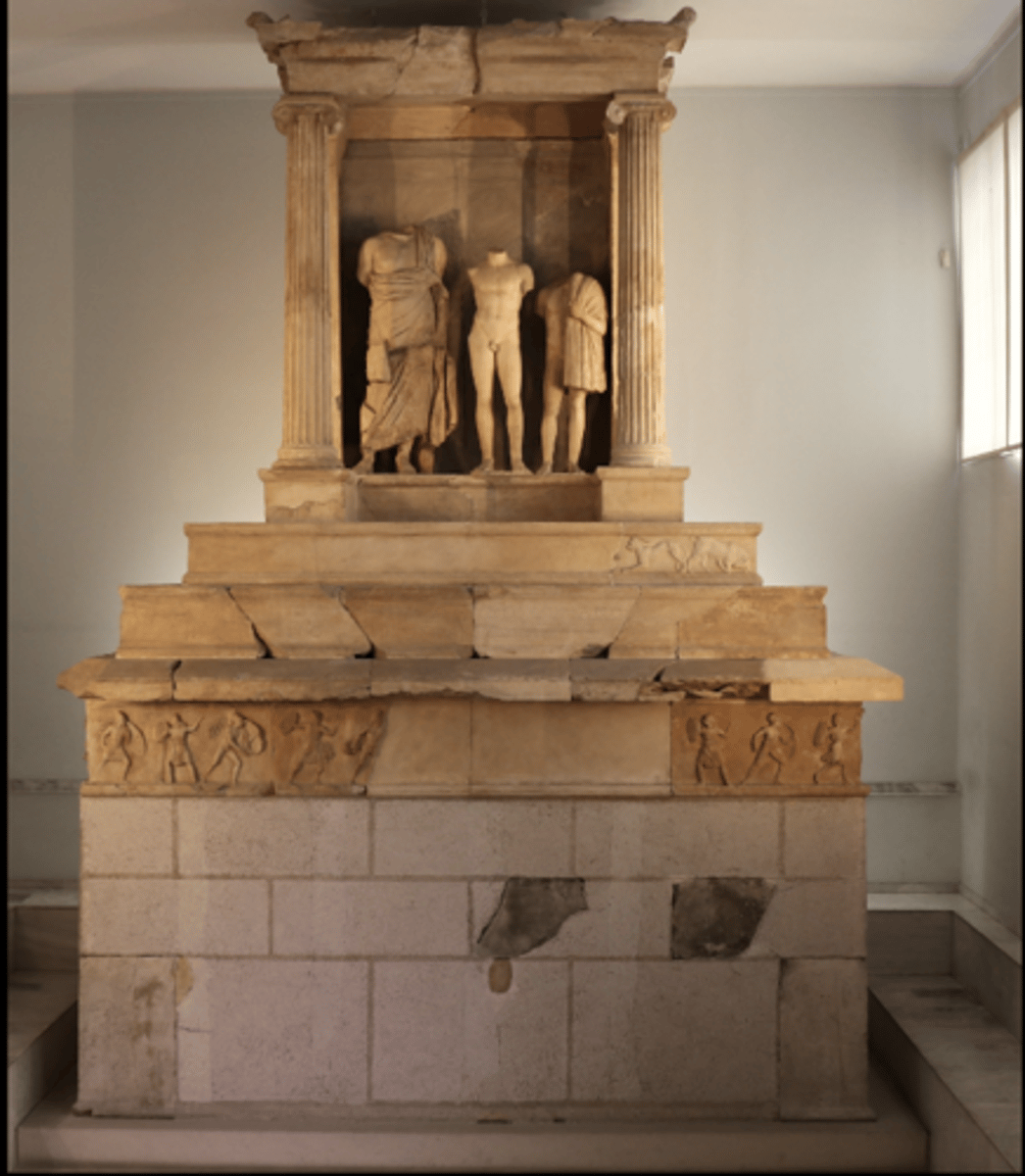
Grave Monument of Nikeratos and his son Polyxenos
- 320 bce (late classical period)
- From tomb in Kallithea (in athens)
- tomb of a family of metics (free non-citizens)
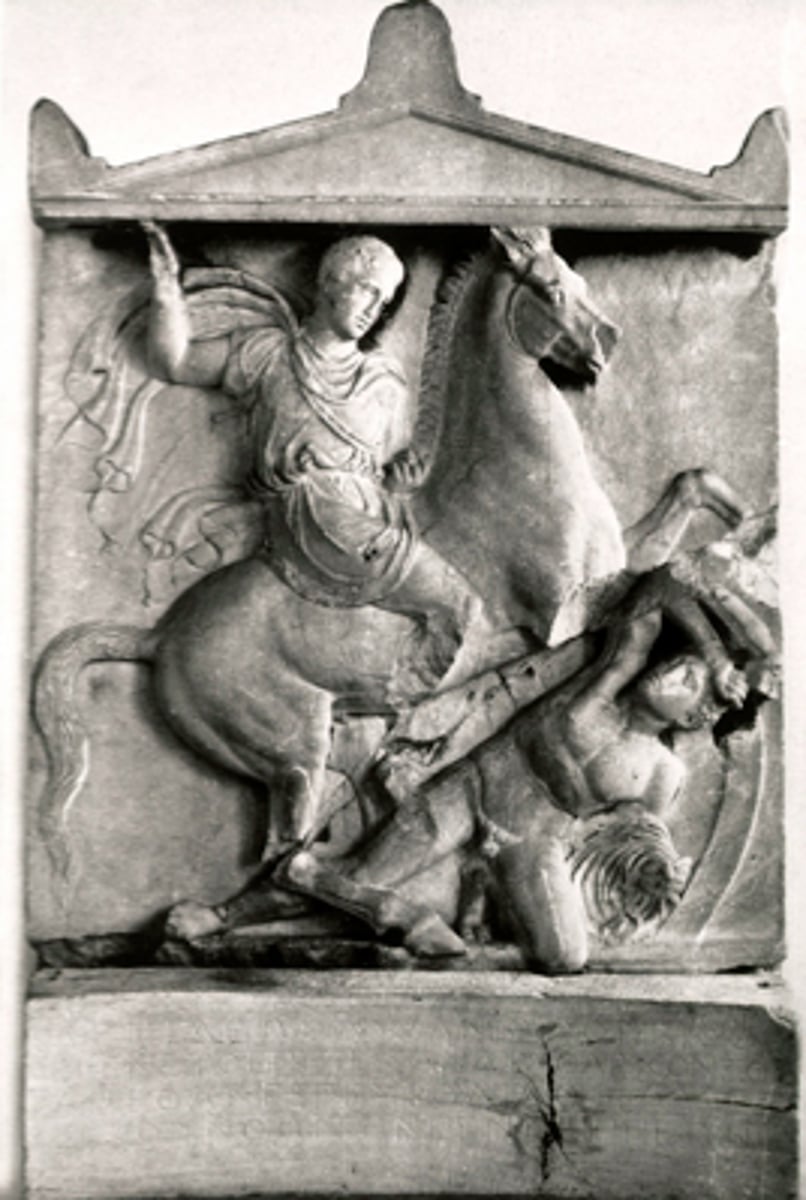
Grave Monument for Dexileos
- 394 bce (late classical period)
- from Diplyon cemetery in Athens
- made by Dexileos sculptor
- depicts athenian cavalryman named Dexileos who died in the Corinthian War against Sparta
Ilissos Stele
- 330 bce (late classical period)
- found near river Ilissos (athens)
- notable for number and variety of figures (old man, youth, boy, & dog)
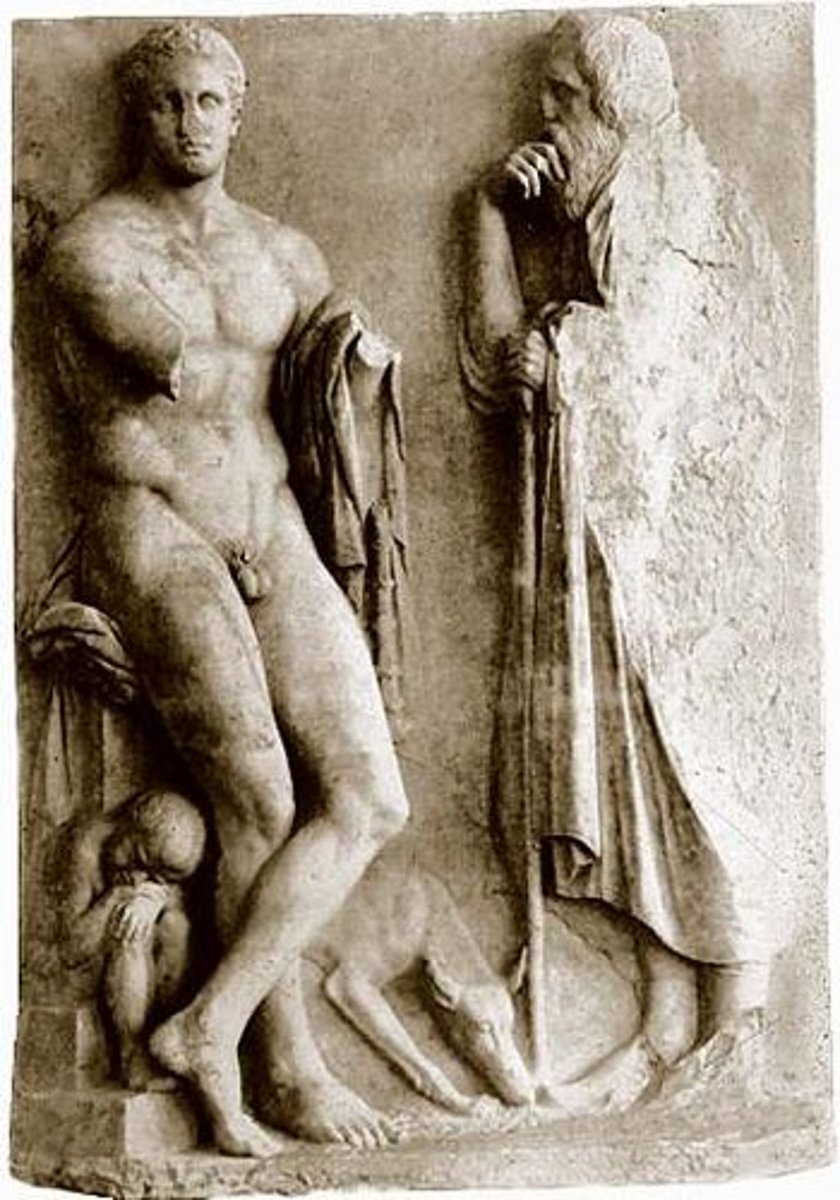
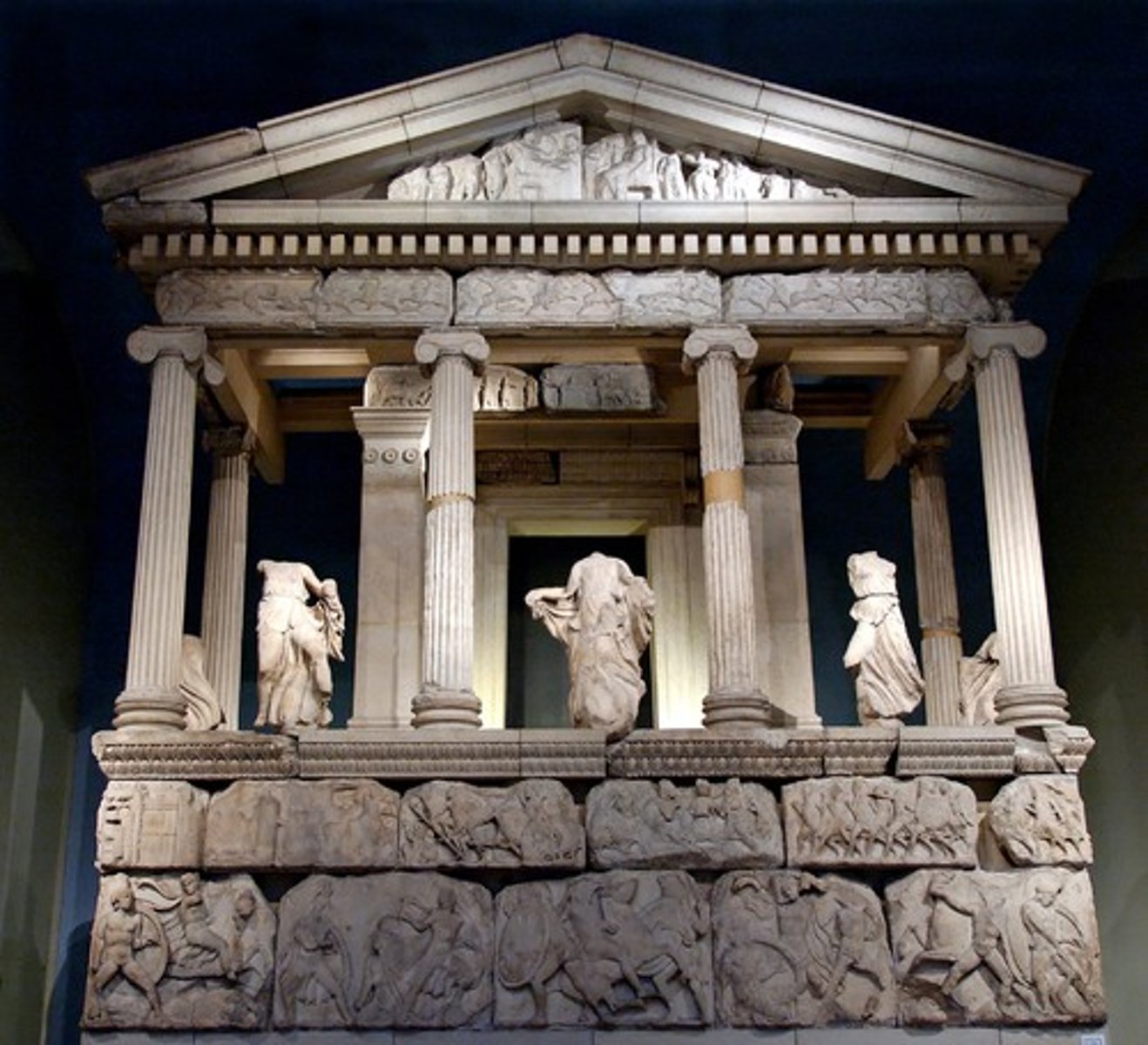
The Nereid Monument
- 390-350 bce (late classical period)
- from Lycia (asia minor)
- tomb that mimics an ionic temple; build for ruler of Lycia & his family
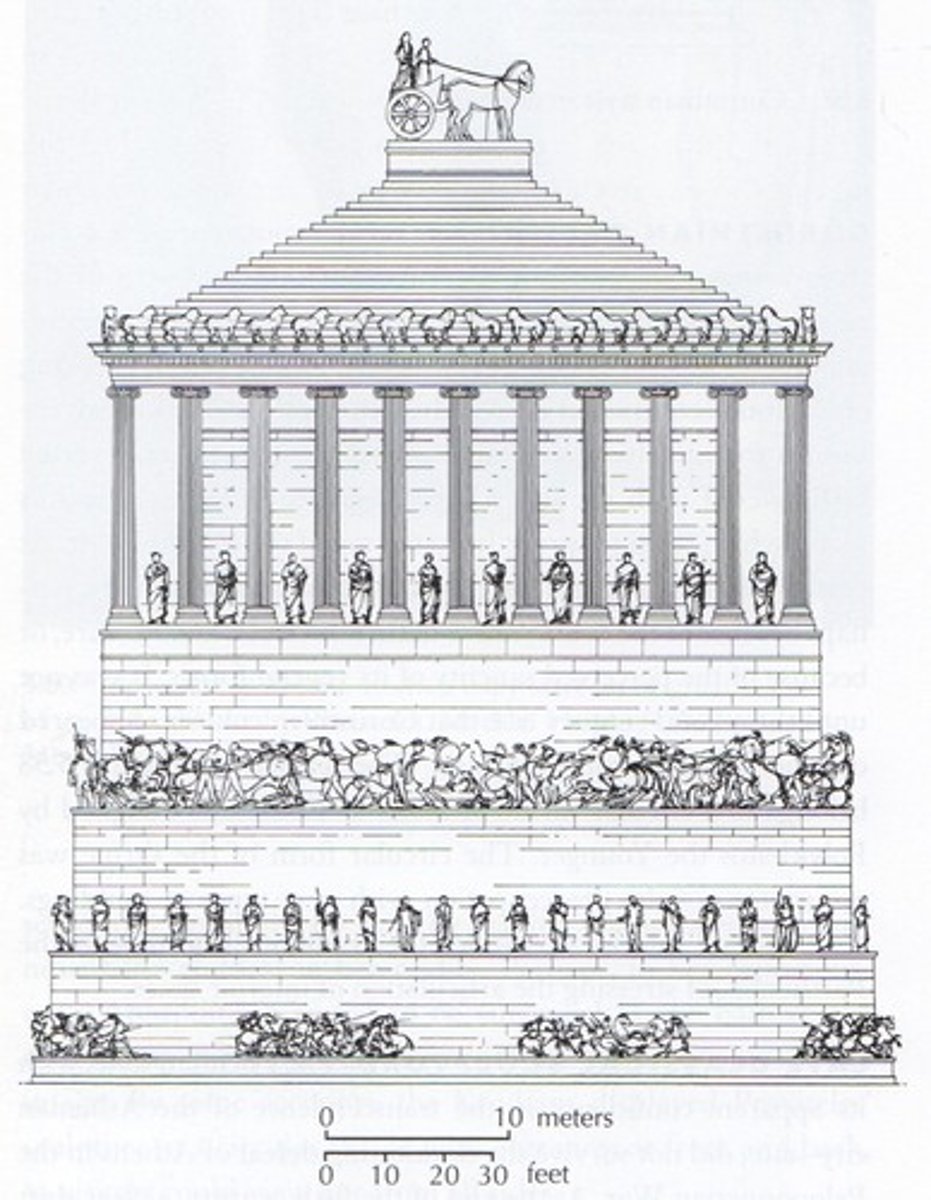
The Mausoleum at Halikarnassos
- 350 bce (late classical period)
- in asia minor
- pytheos may have been sculptor
- one of the seven wonders
- incorporated egyptian and persian style elements
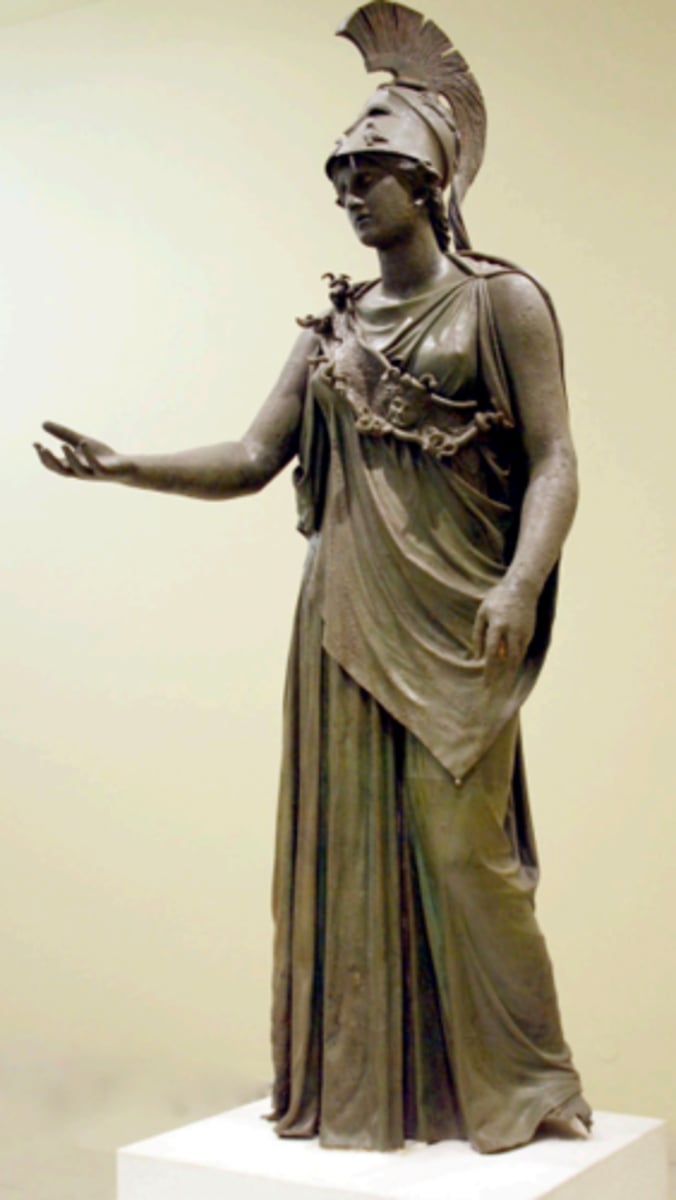
Athena
- 350 bce (late classical period)
- from warehouse in Piraeus (athens)
- possibly by Sulla
- bronze original
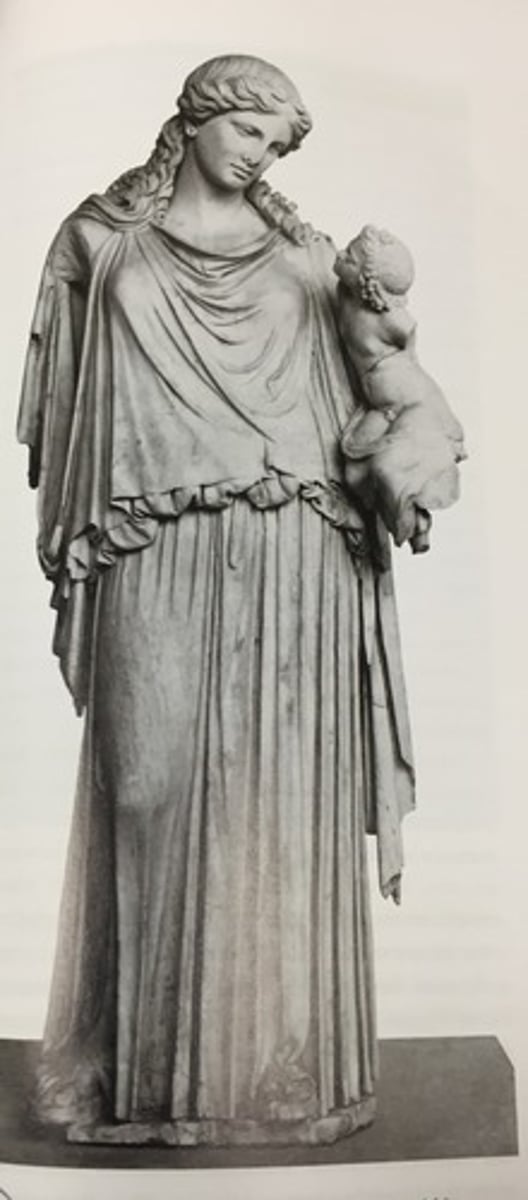
Eirene (peace) holding the child Ploutos (wealth)
- 370 bce (late classical period)
- from athens
- by Kephisodotos
- roman copy of original; new depiction of mother holding child, creating a personification of peace and wealth
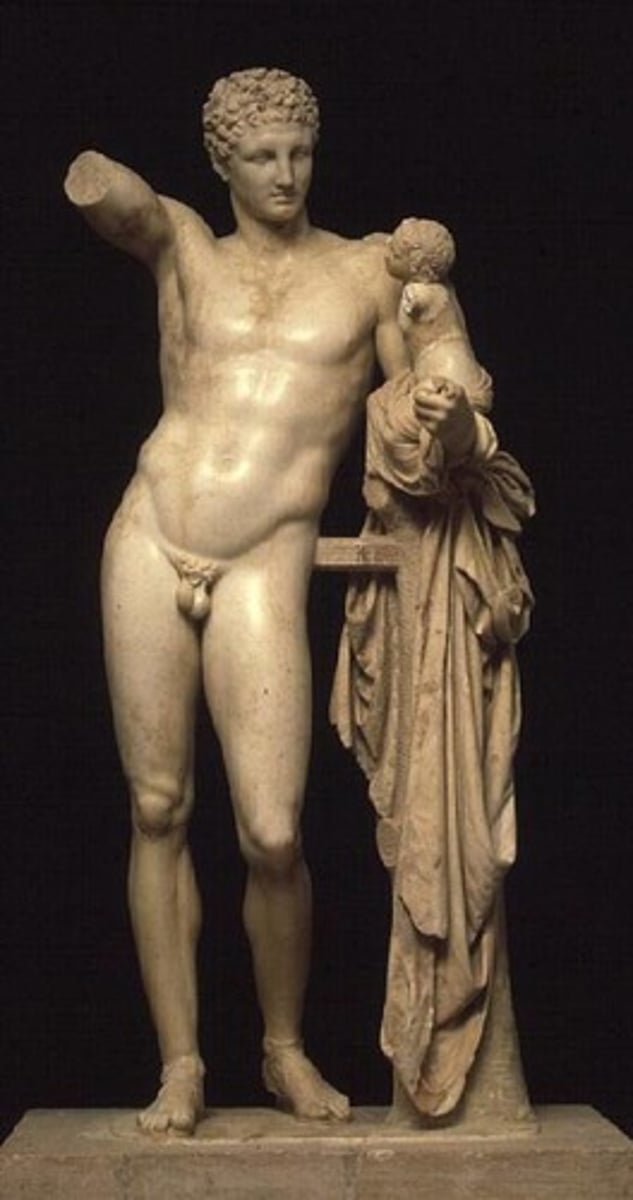
Hermes and Dionysos
- 340 bce (late classical period)
- from temple of hera at Olympia
- by Praxiteles
- depicts hermes holding his younger brother dionysos in his arms (mortal activity)
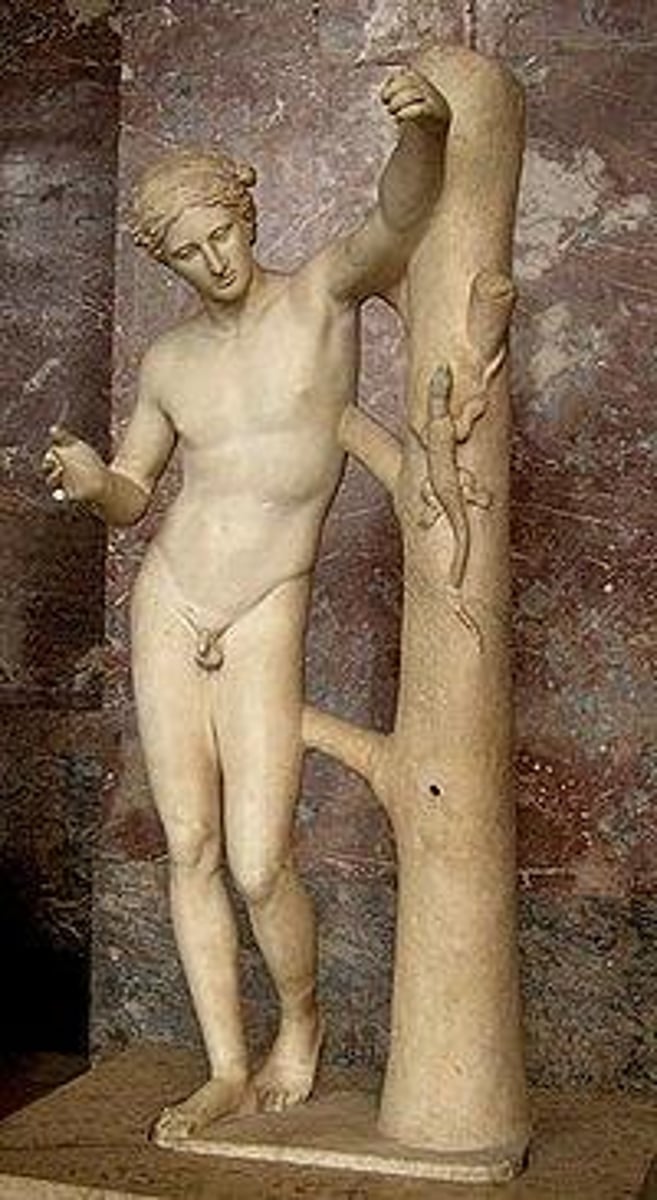
Apollo Sauroktonos
- 350 bce (late classical period)
- from athens ??
- by Praxiteles
- "lizard slayer"
- depicts a young apollo looking at a lizard on a stump (myth that he killed a dragon)

Praxiteles Satyr
- 370-360 bce (late classical period)
- from athens ??
- by Praxiteles
- depicts satyrs in a more humanistic view
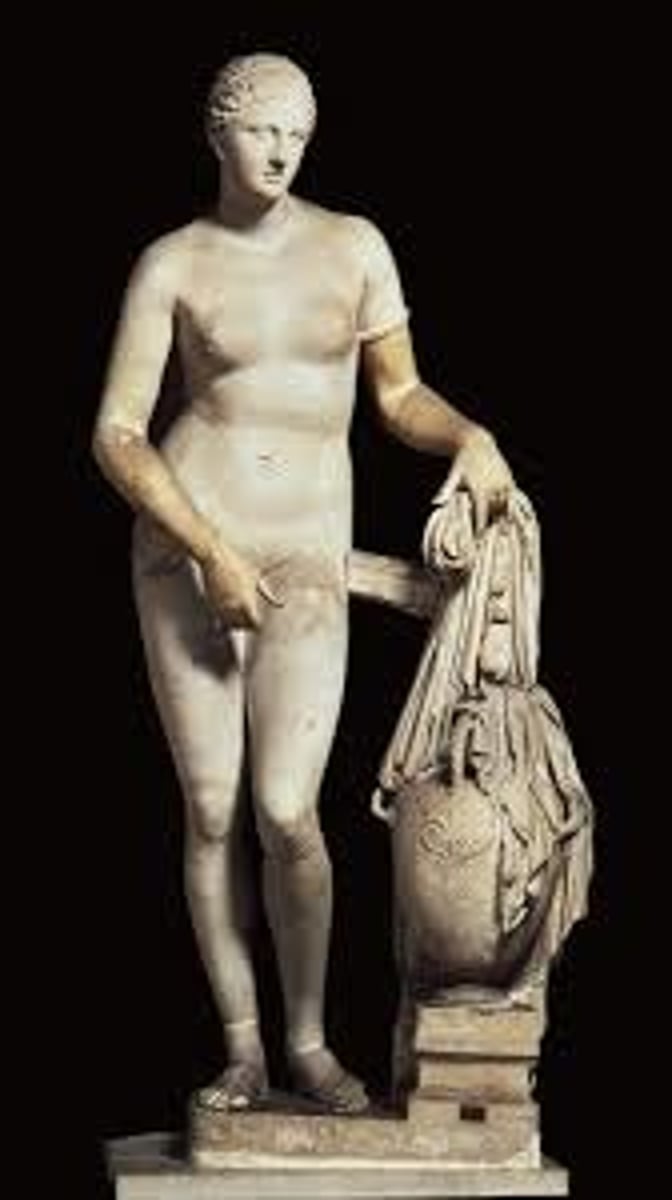
Aphrodite of Knidos
- 350 bce (late classical period)
- from Knidos (asia minor)
- by Praxiteles
- depicts aphrodite bathing herself, getting spotted by the viewer and covering herself up
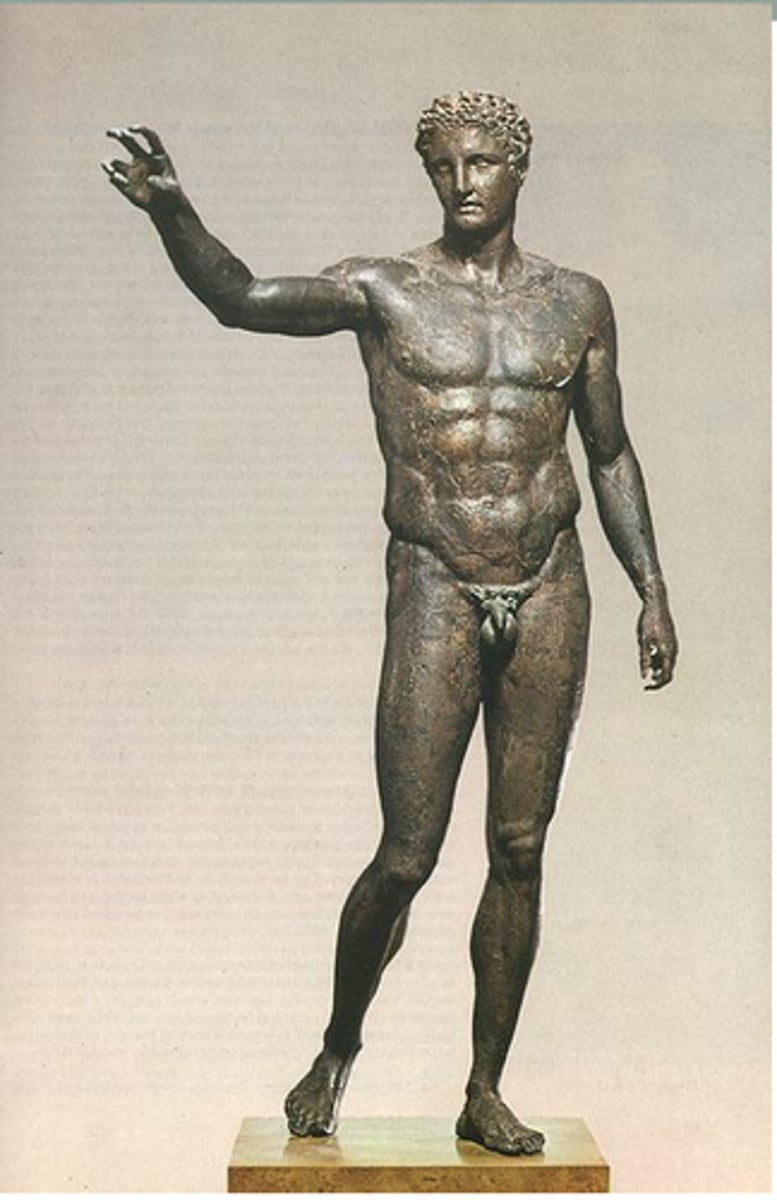
Antikythera
- 350 bce (late classical period)
- found in sea (probably heading to rome)
- depicts perseus holding the head of medusa
- bronze
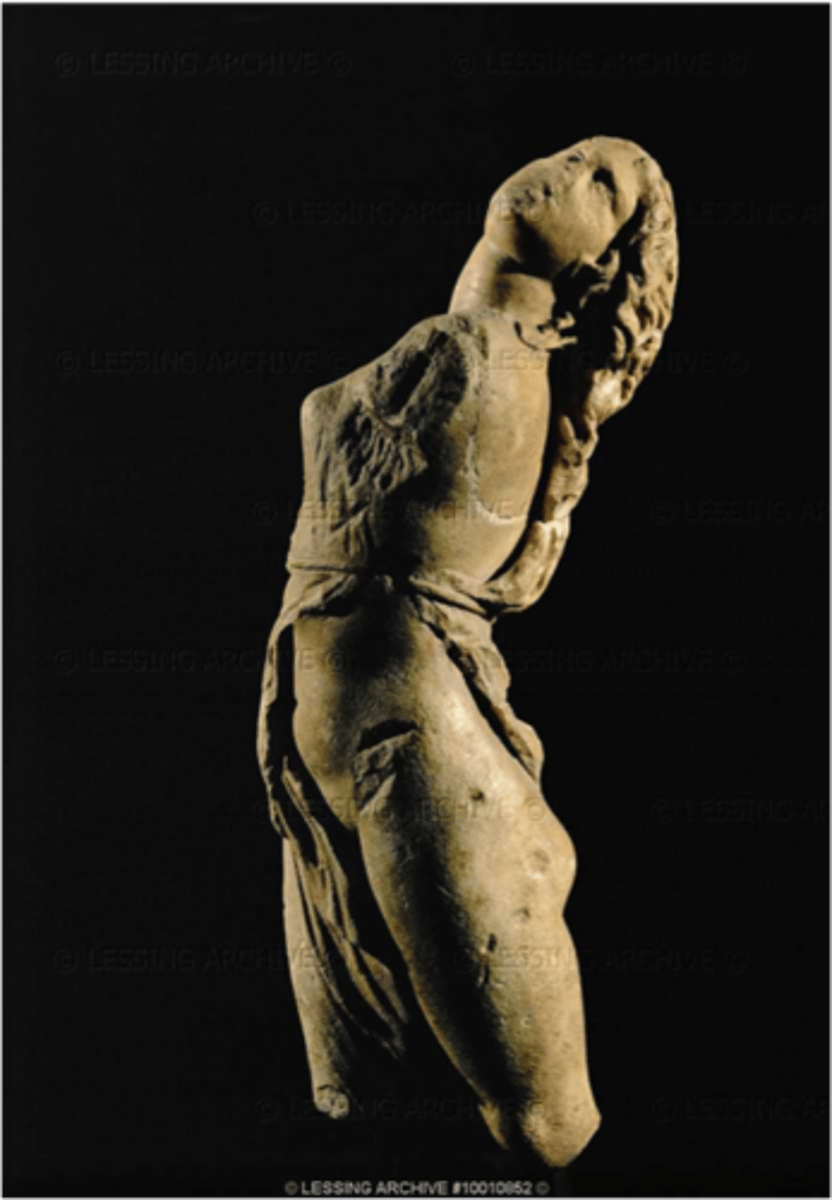
Dancing Maenad
- 395-350 bce (late classical period)
- from athens
- by Skopas
- depicts maenad (female satyr) dancing
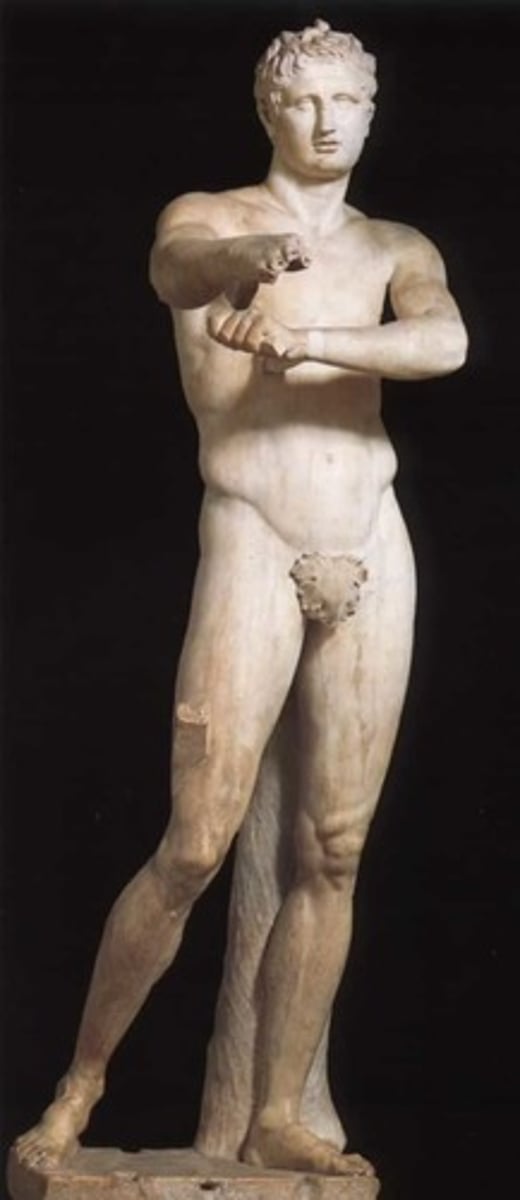
Apoxyomenos
- 330-320 bce (late classical period)
- from athens ??
- by Lysippos
- depicts athlete scraping the oil from his body
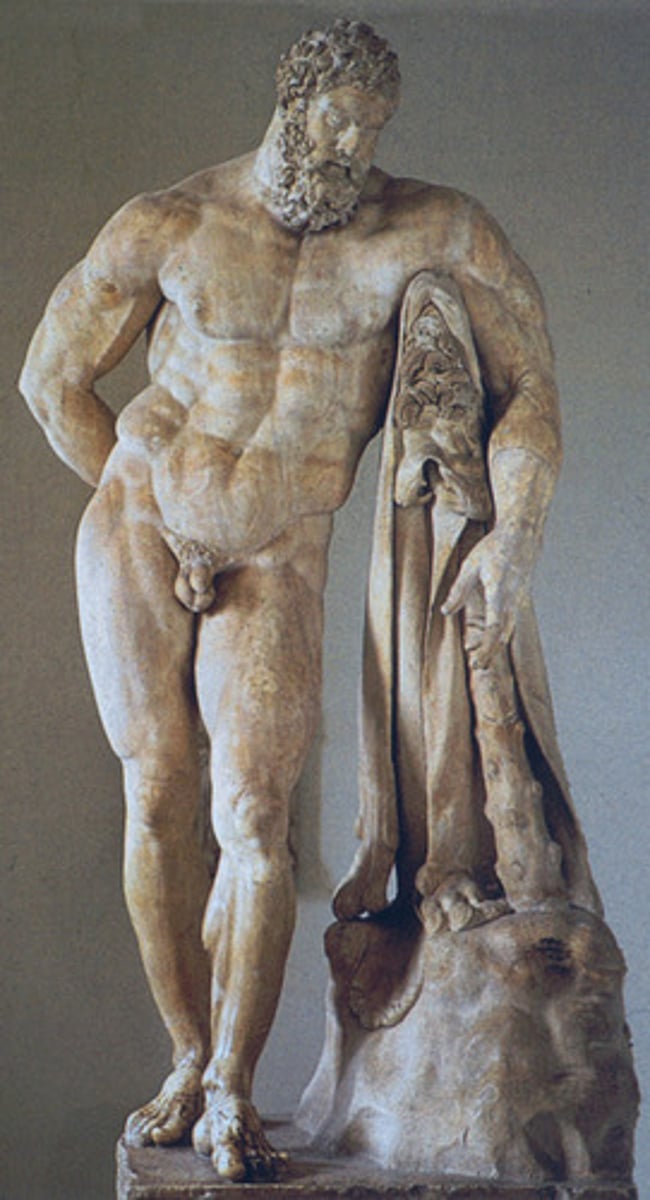
Herakles Farnese
- 330-320 bce (late classical period)
- from athens ??
- by Lysippos
- depicts Herakles holding apples behind his back (myth that he stole apples from the Garden of the Hesperides)
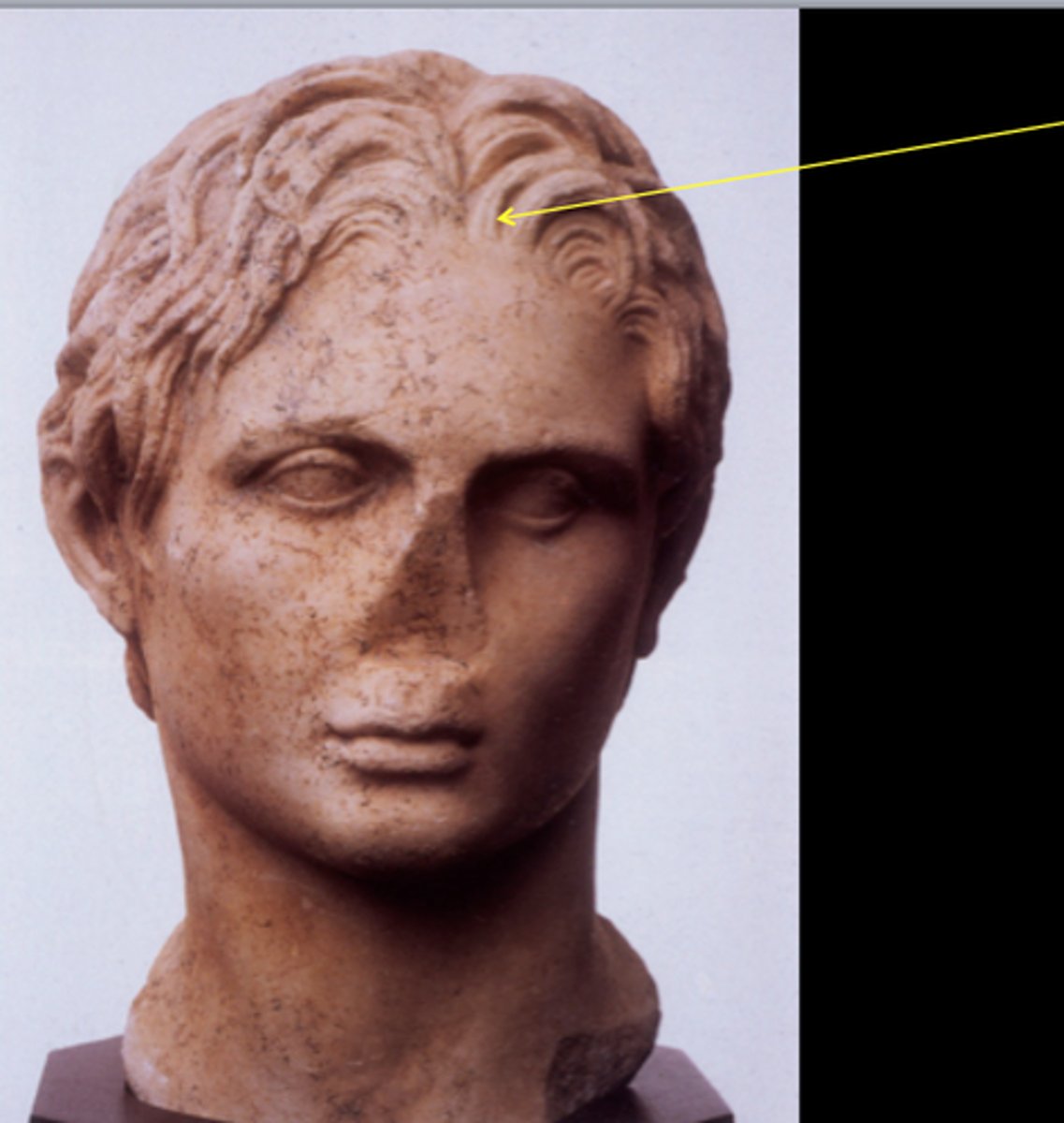
Alexander Schwarzenberg
- 335-320 bce (late classical period)
- from athens ??
- by Lysippos
- sculpture of alexander the great, king of macedonia (identifiable by hairstyle)
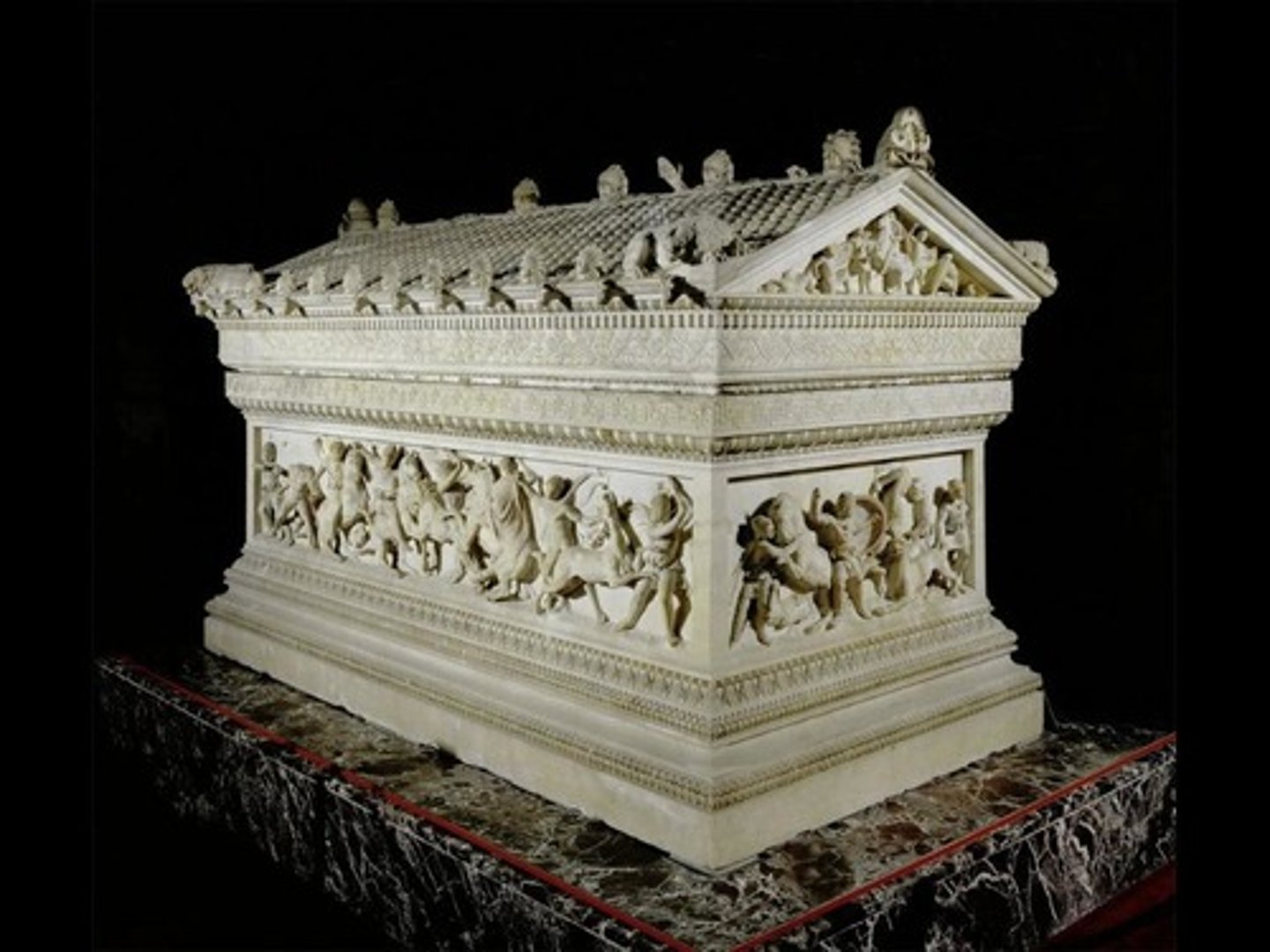
Alexander Sarcophagus
- 325-311 bce (late classical period)
- from Sidon royal necropolis
- was likely for king of Sidon, but called "alexander sarcophagus" due to sculptural depictions of alexander in battle
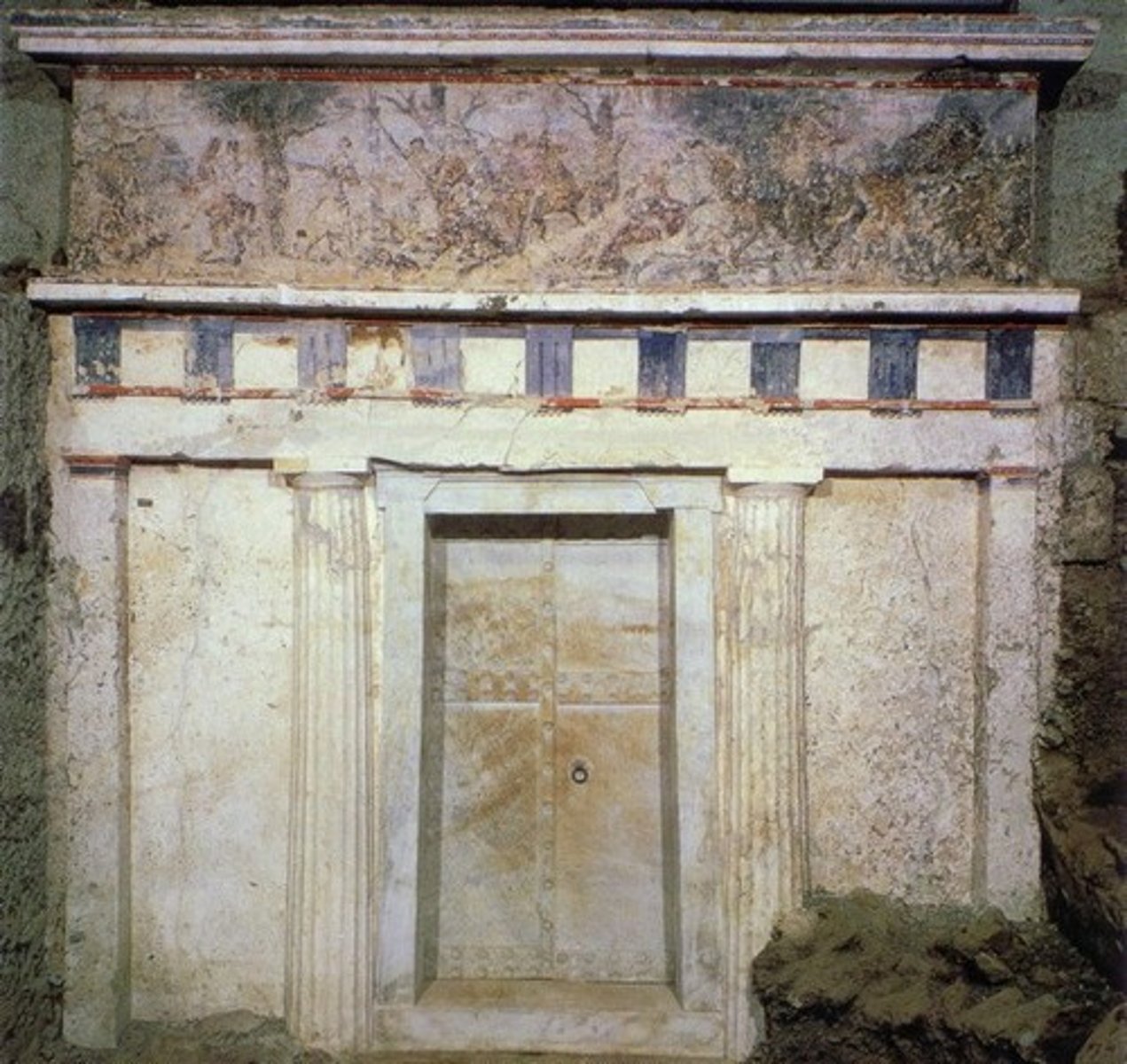
Facade and Fresco from Tomb of Philip II
- 335-315 bce (late classical period)
- from tomb at Vergina
- mixture of doric and ionic features
- has painted frieze depicting a hunting scene
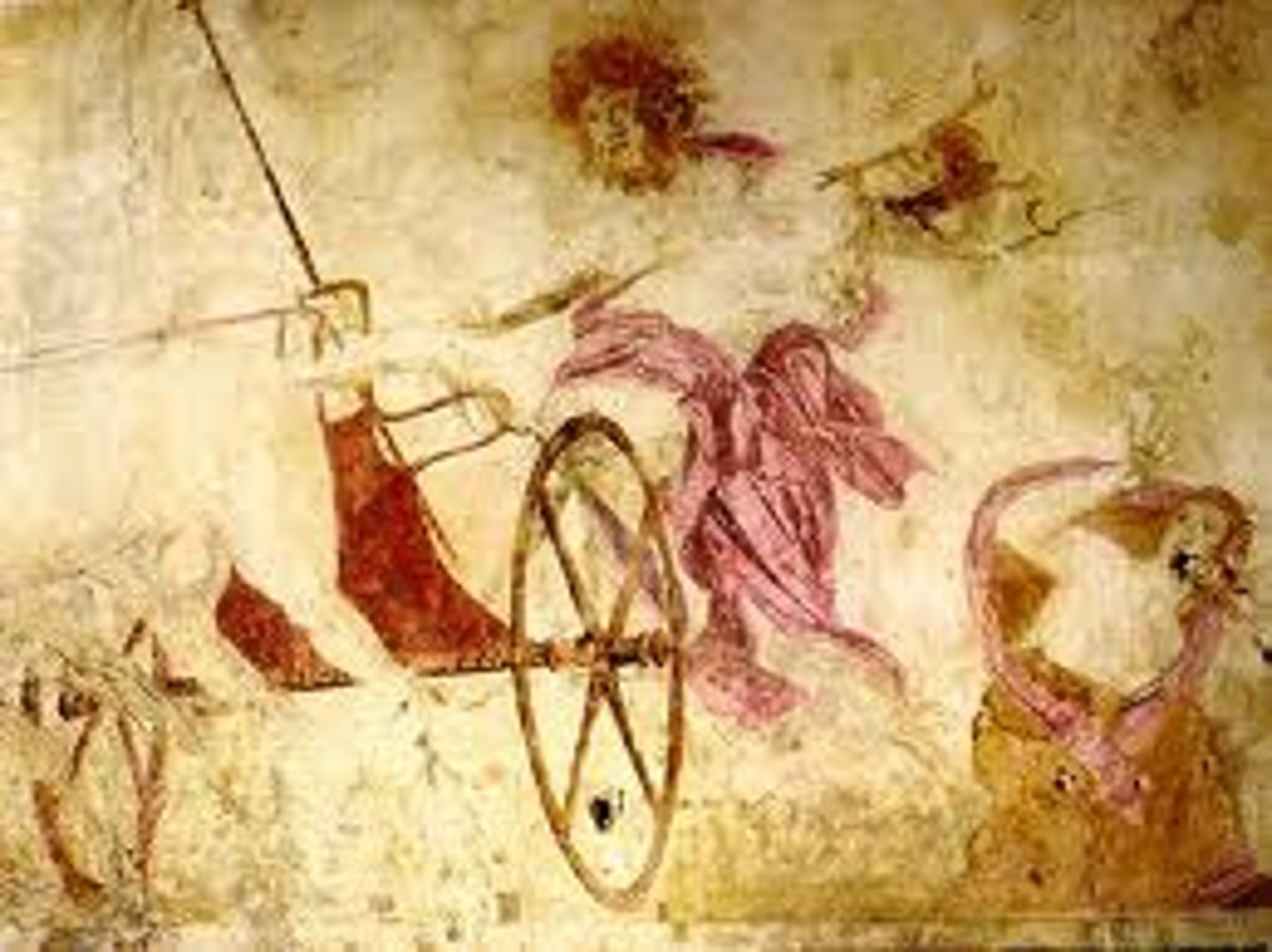
Tomb of Persephone
- 340 bce (late classical period)
- from Vergina
- wall painting depicting hades capturing persephone
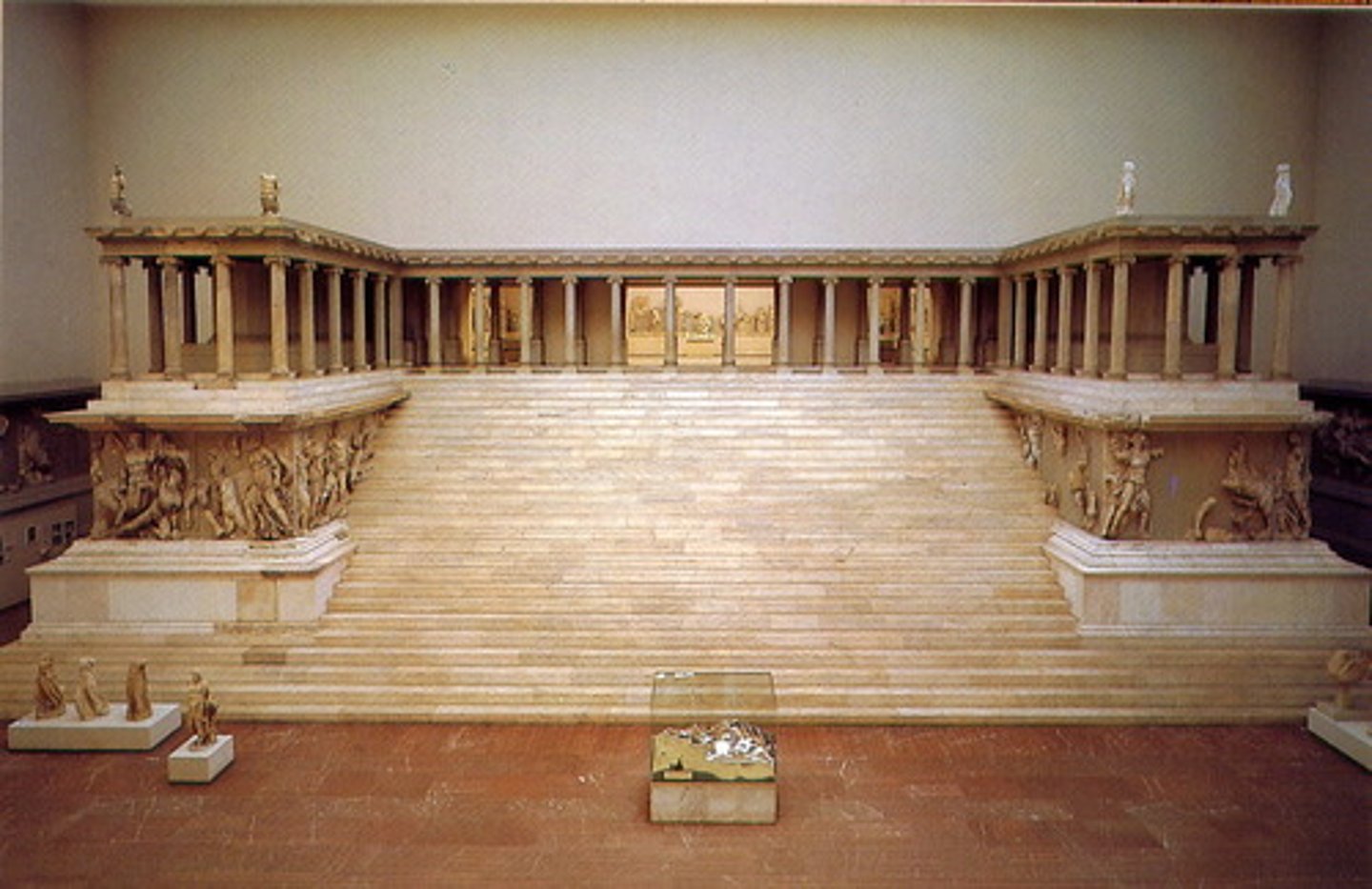
Great Altar of Zeus from Pergamon
- 180-150 bce (high hellenistic pd)
- from pergamon/pergamum (asia minor)
- built by King Emends II
- built to mark successful victory over Gaul revolt; made to thank Zeus for victory
- reminiscent of Athenian Acropolis
- Ionic colonnade surrounded by friezes
- center has sacrificial altar
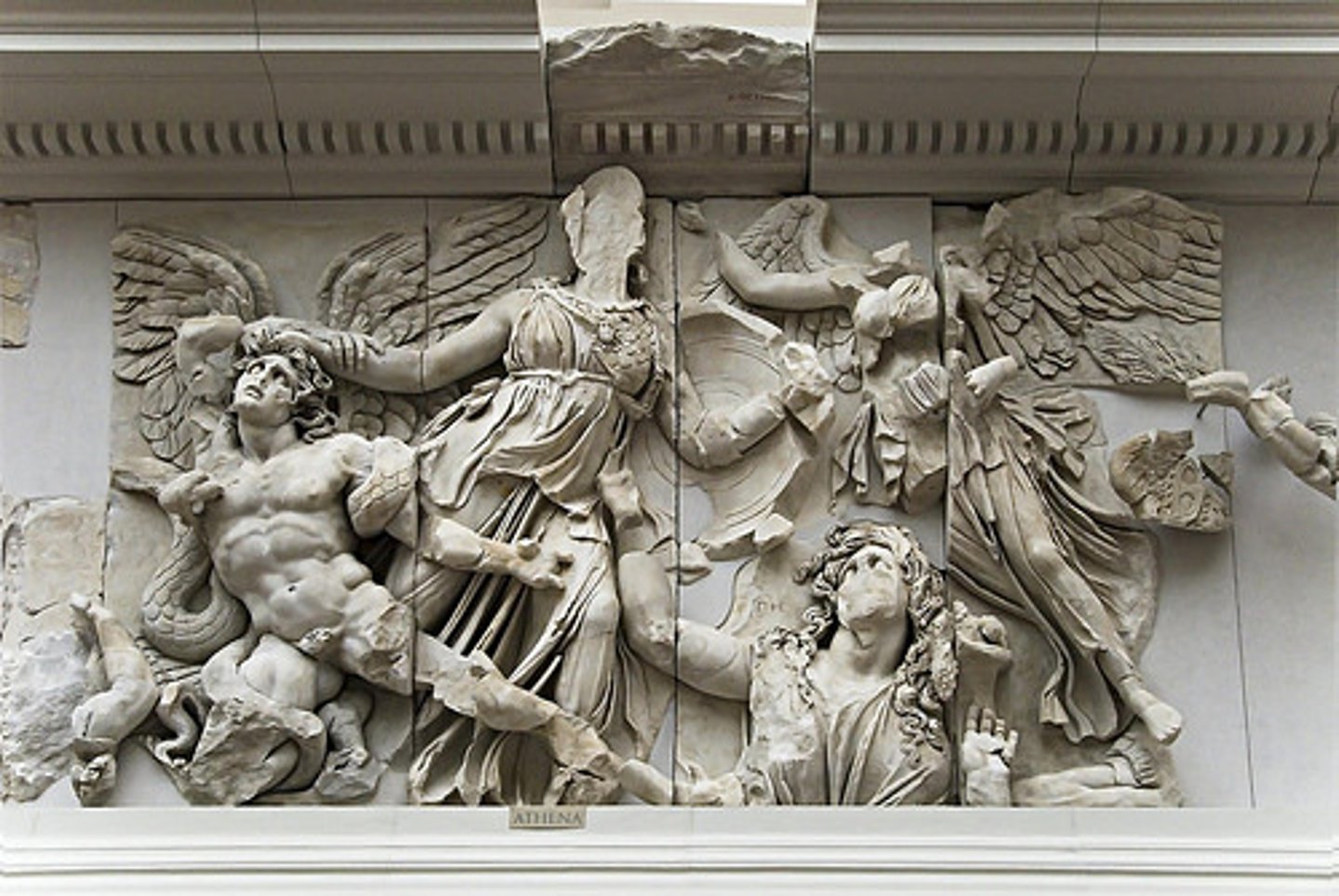
Gigantomachy Frieze
- 180-150 bce (high hellenistic pd)
- from great altar of zeus from pergamon (asia minor)
- nearly 200 figures
- depicts fights between gods (athena, zeus) and giants; figures with wings denote nikes (shows victory)
- faces show pathos/strong feelings of emotion (new feature)
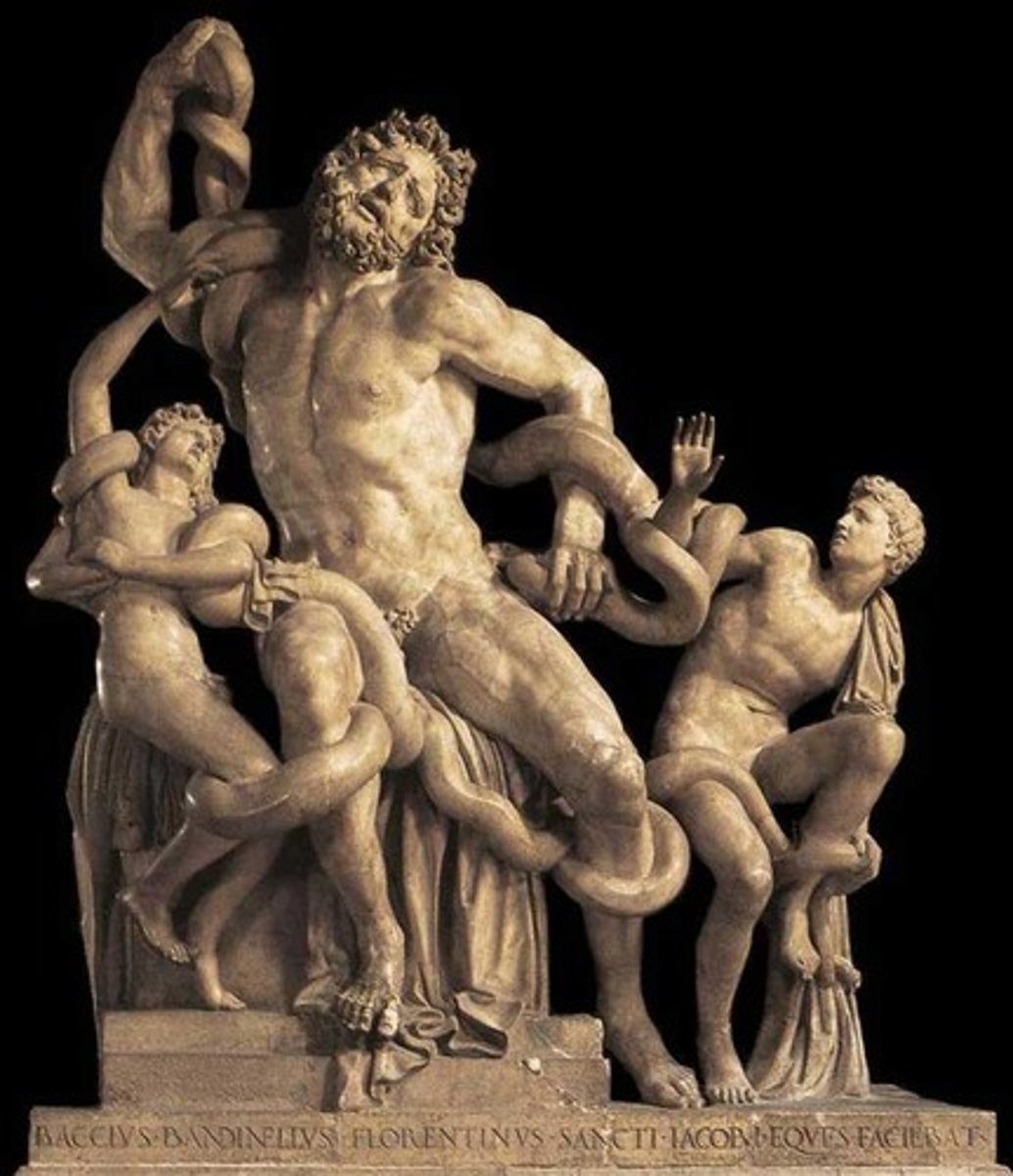
Laocoon
- 3rd-1st cent. bce (debated due to discovery of figures from a cave at Sperlonga, which confuses chronology)
- by hagesandros, athanadoros, and polydoros
- from rome (italy)
- depicts Laocoon and his two sons getting attacked by snakes (called on by poseidon since Laocoon was going to warn Troy about the Trojan Horse)
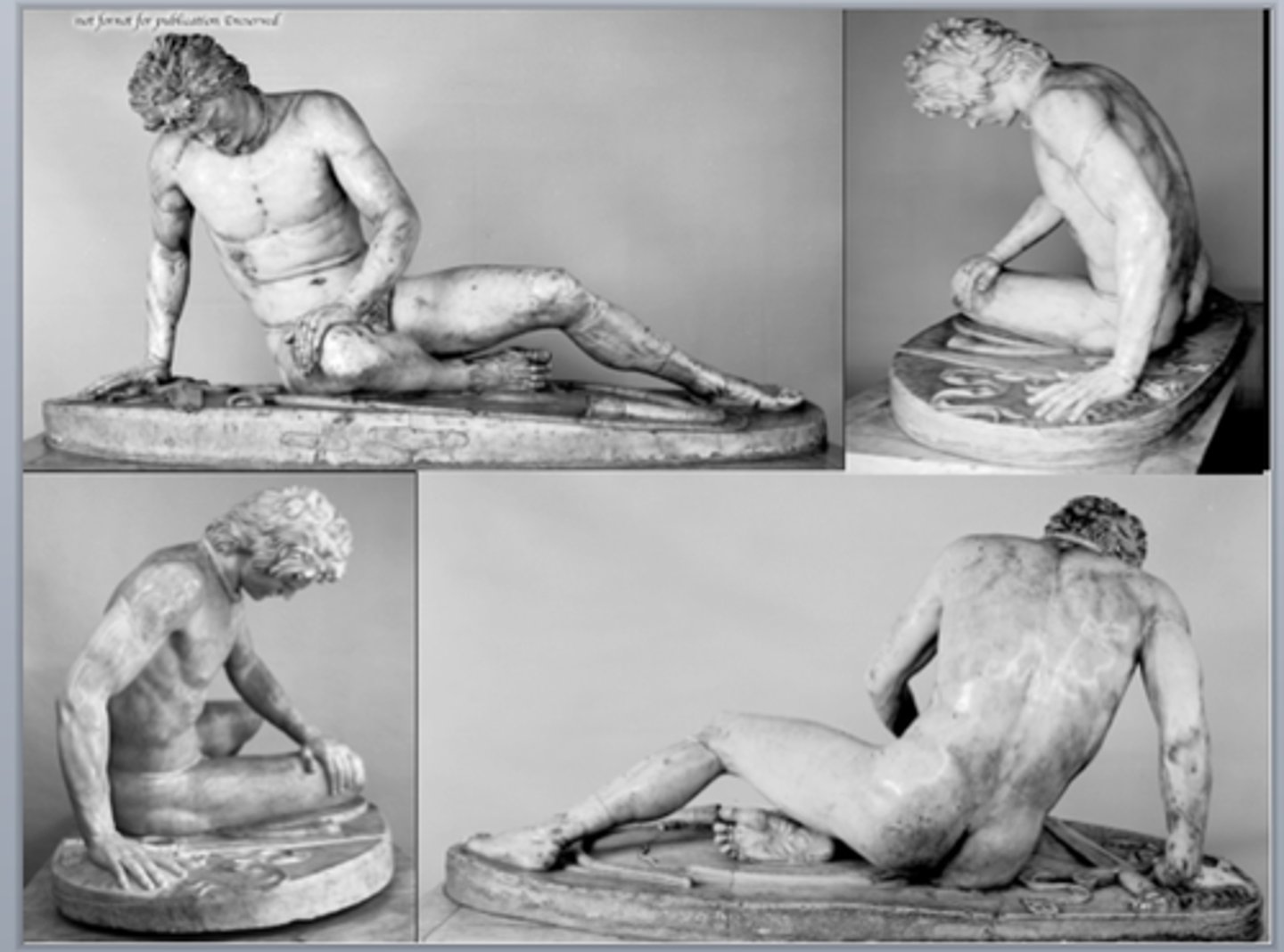
Gaul Ludovisi
- 220 bce (high hellenistic pd)
- from Pergamon (where victory was against Gauls)
- made by Epigonus
- "dying gaul" (Gaul denoted by mustache)
- roman copy; part of bigger group of dedications known as the Large Gauls (included Gaul and his wife)
- man is trumpeter (broken trumpet on ground)

Gaul and his Wife
- 220 bce (high hellenistic pd)
- from Pergamon (where victory was against Gauls)
- made by Epigonus
- depicts Gaul man (mustache) killing himself after killing his wife to prevent her from becoming a slave
- roman copy
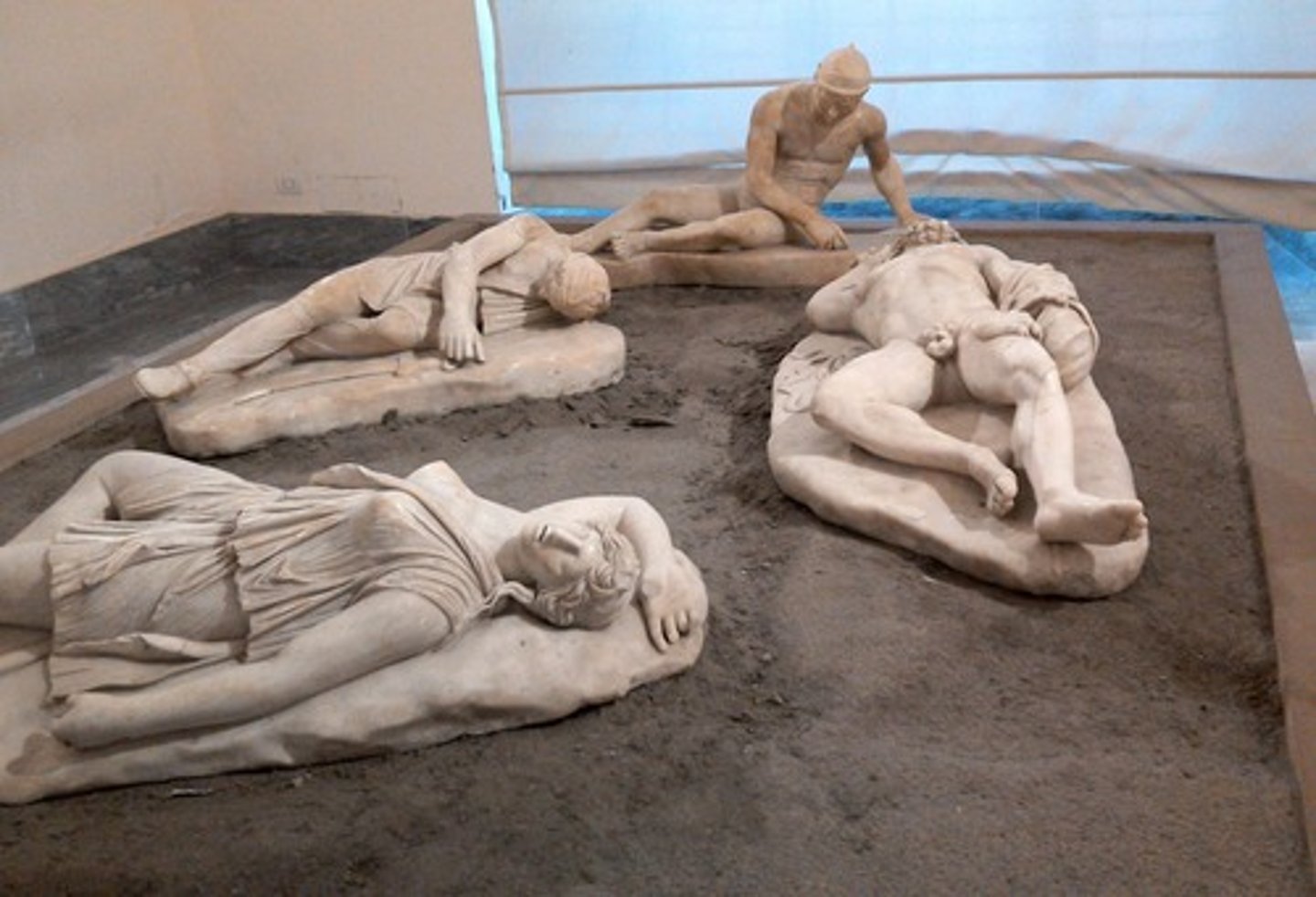
Votive offering for Victory over the Gauls
- 150 bce (high/late hellenistic pd)
- from acropolis (athens)
- pergamene king attalos II dedicated votive offering at acropolis celebrating the victory over the Gauls
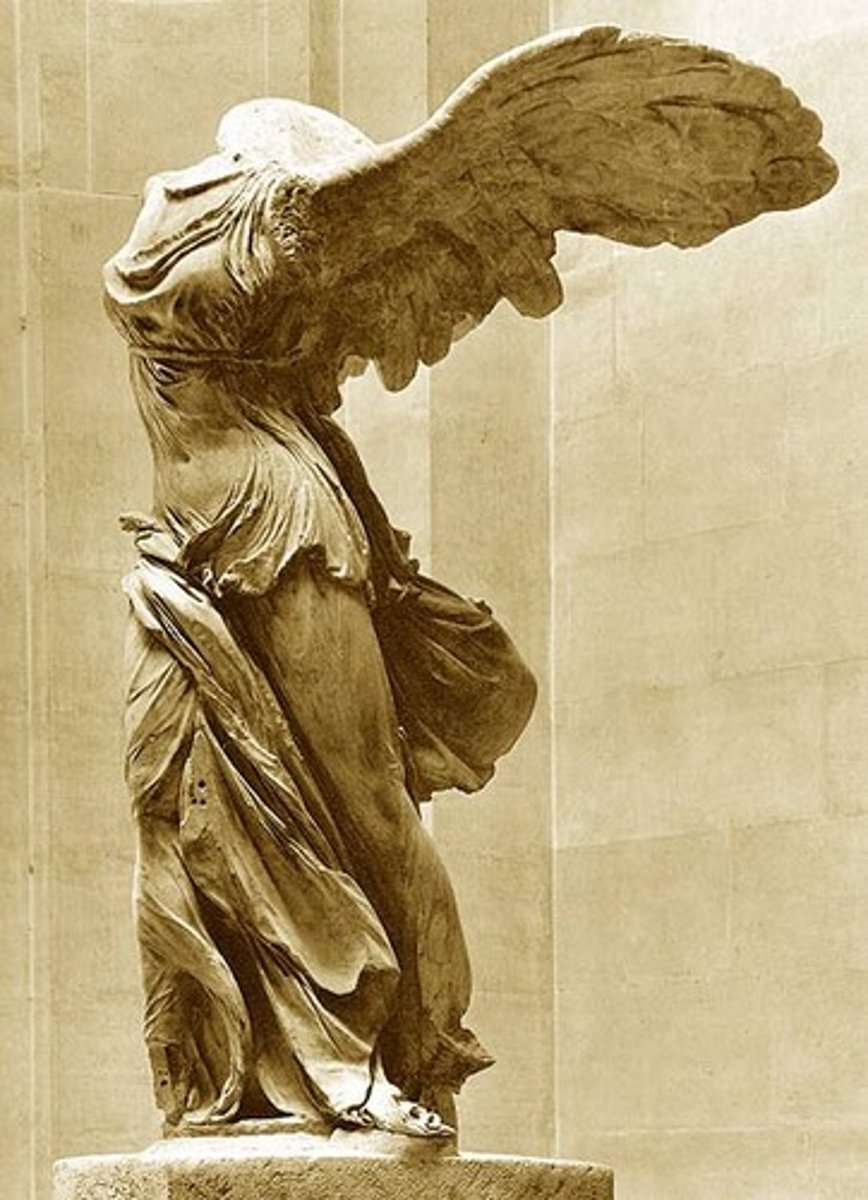
Nike of Samothrace
- late 3rd-early 2nd cent bce (high hellenistic pd)
- from samothrace
- by Pythokritos
- depicts nike landing from flight, wings still outstretched
- likely a ship battle due to her landing on a ship
- back is poor quality, not meant to be seen from all angles
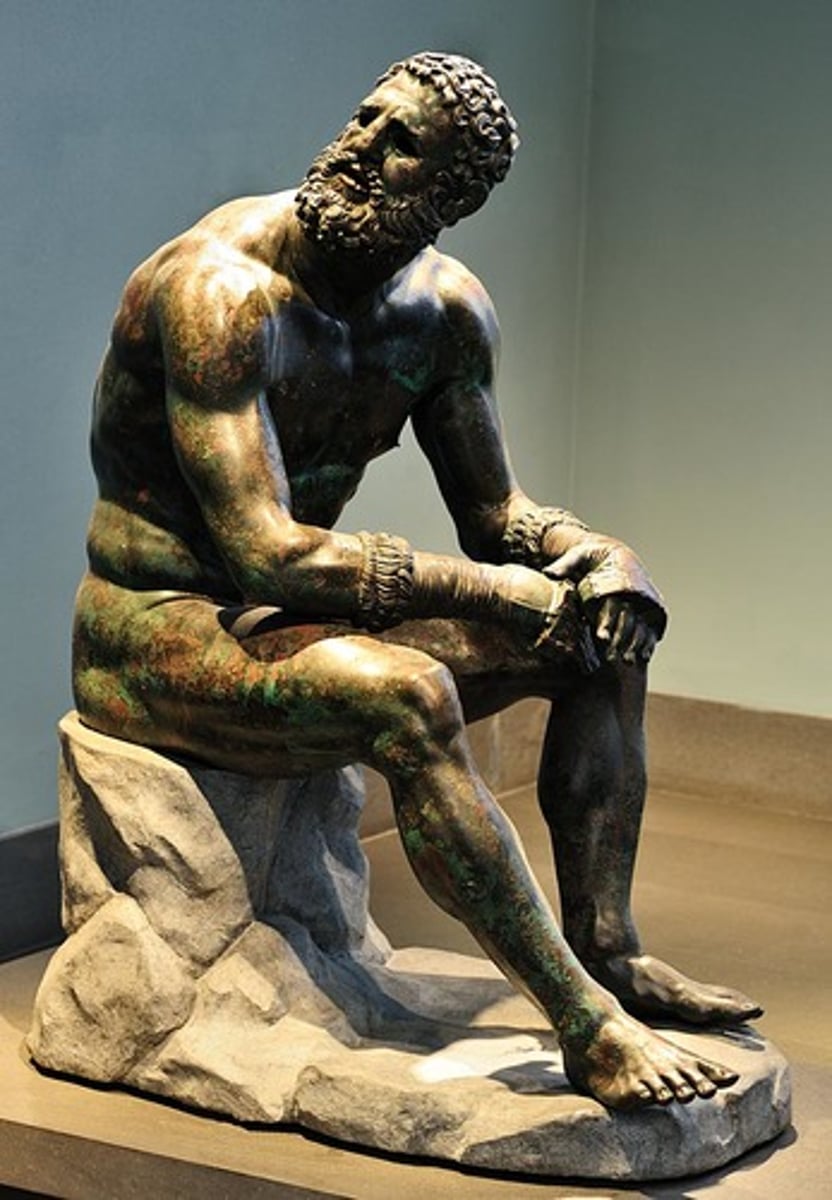
Terme Boxer
- 100-50 bce (late hellenistic pd)
- from rome (Italy)
- found with hellenistic ruler statue
- bronze original
- broken nose, swollen ears, bleeding wounds (debated whether or not he won or lost the fight)
- pose and hair is reminiscent of classical style

Marsyas's Punishment
- late 2nd cent. bce (high/late hellenistic pd)
- from rome (Italy)
- made of red/purple stone
- depicts Marsyas, a satyr, being hung and skinned because he said he was a better flute player than Apollo
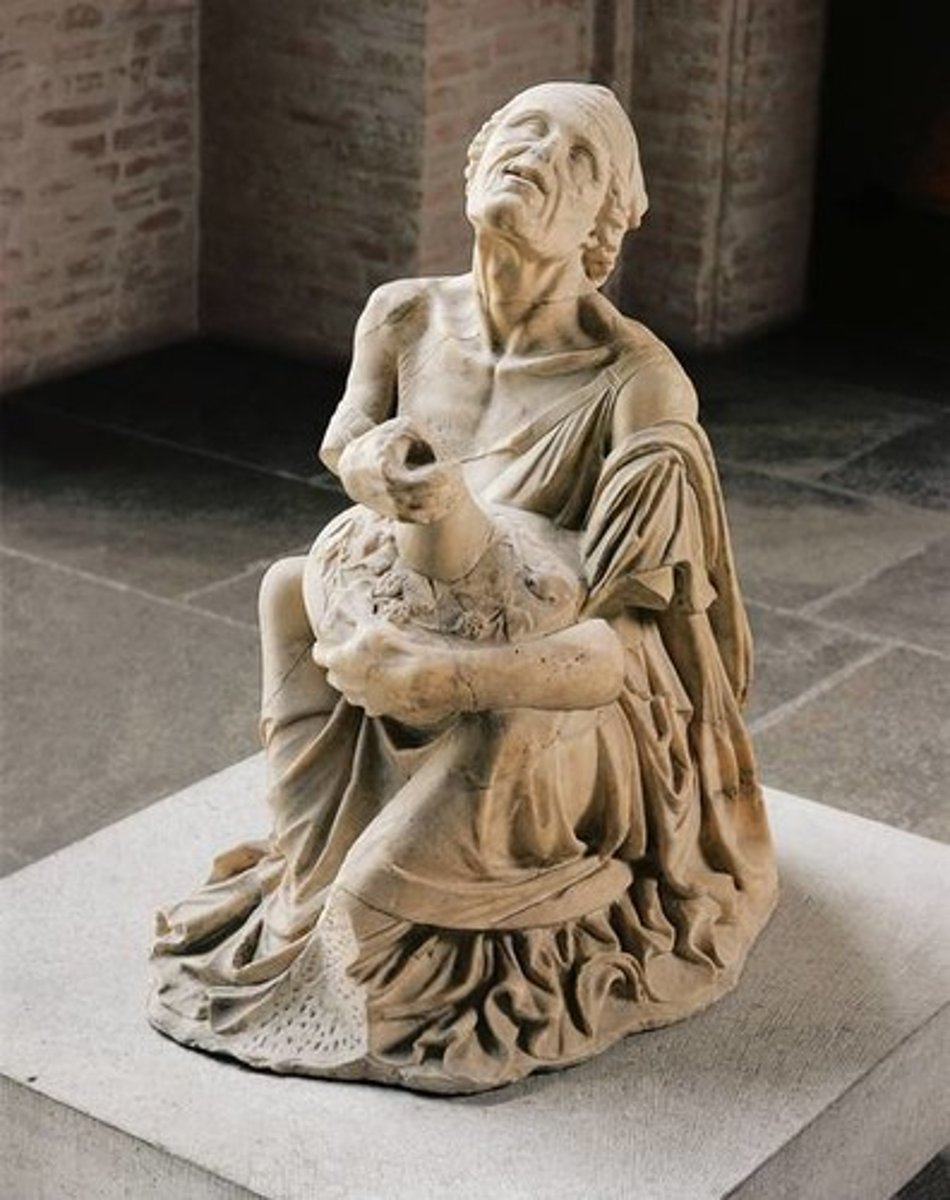
Drunken Old Woman
- 3rd cent bce (early/high hellenistic pd)
- from Smyrna (asia minor)
- made by Myron
- roman copy
- old woman is seated holding a vessel of wine (maybe prostitute??)
- comparison can be made to Dancing Maenad --> maenads are related to Dionysos, god of wine, and woman is drunk
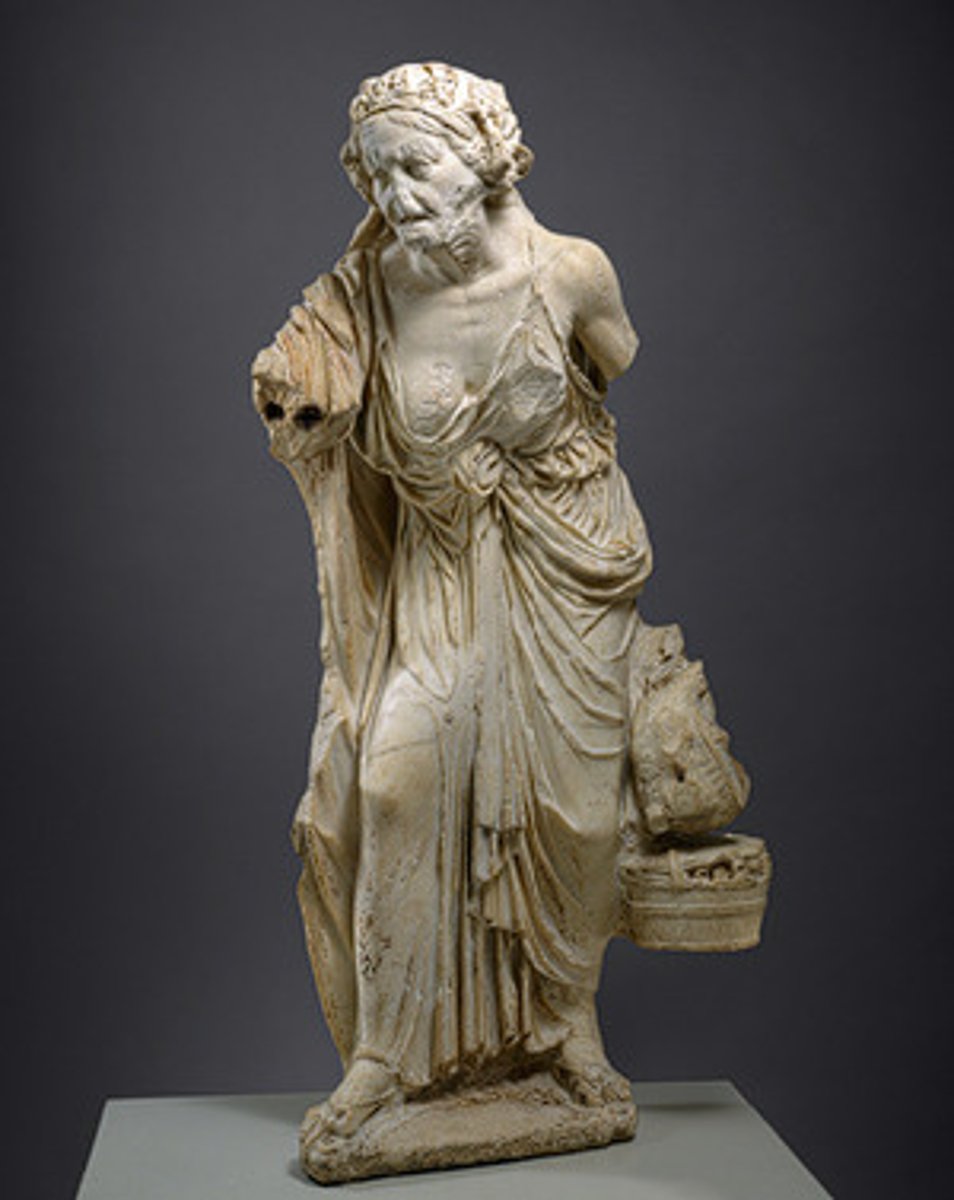
Old Woman
- 2nd cent bce (high/late hellenistic pd)
- from Smyrna (asia minor)
- made by Myron
- woman is likely a merchant; shoulder exposed alludes to sexual undertones, maybe an old prostitute?
- purpose is unknown, votive?? humorous??
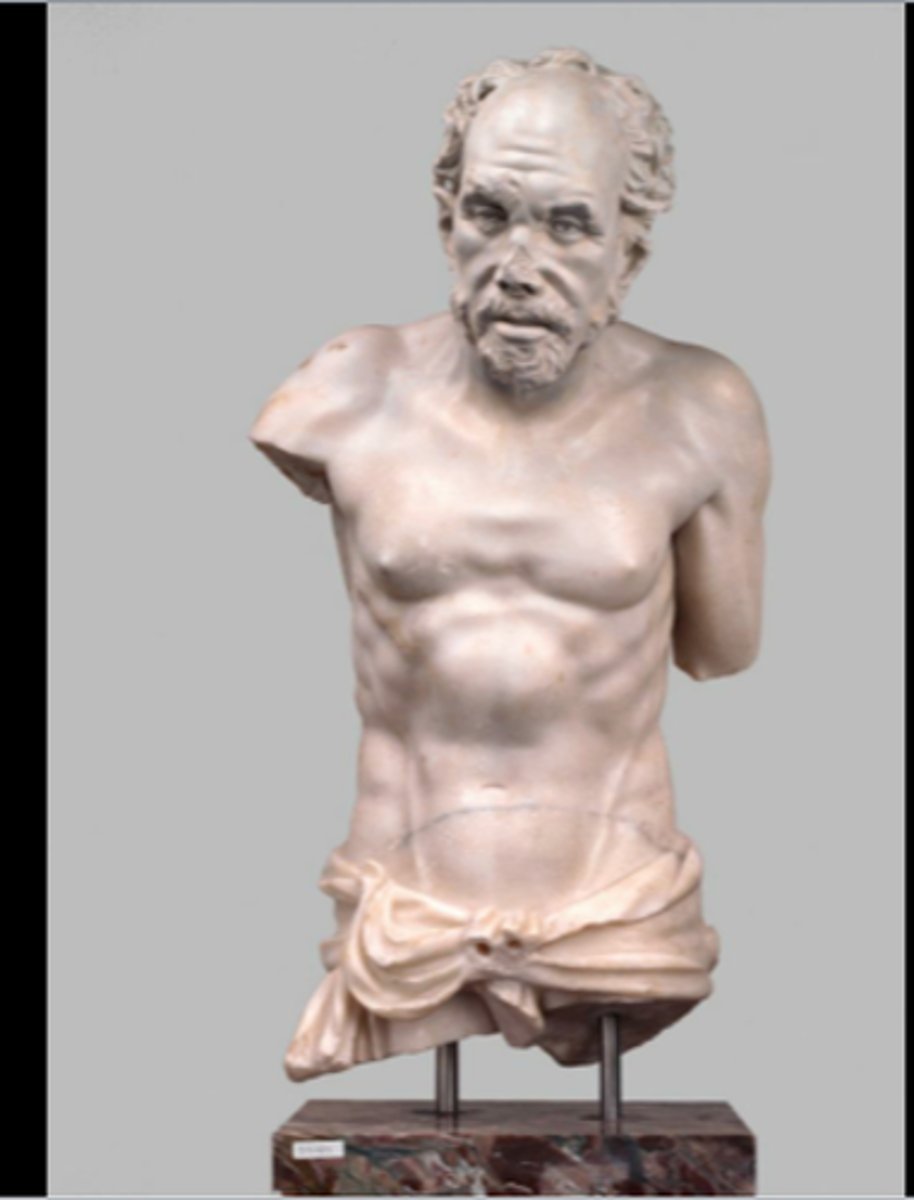
Old Fisherman
- 200 bce (high hellenistic pd)
- from Aphrodisias (Asia Minor)
- depicts an elderly fisherman
- depicting elderly common people became popularized during the hellenistic period
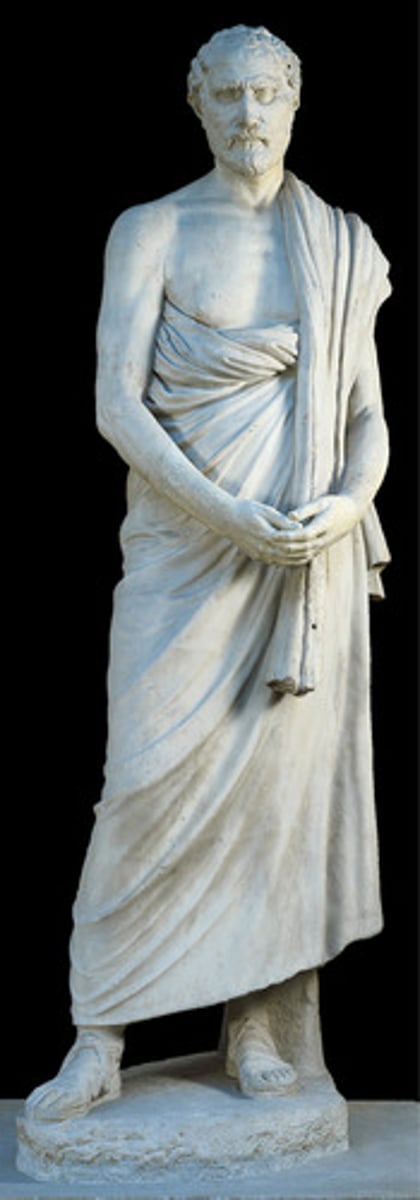
Demosthenes
- 280 bce (early hellenistic pd)
- from Agora in Athens
- by Polyeuktos
- depicts Demosthenes, greek statesman who played lead role in uprising against Alexander the Great
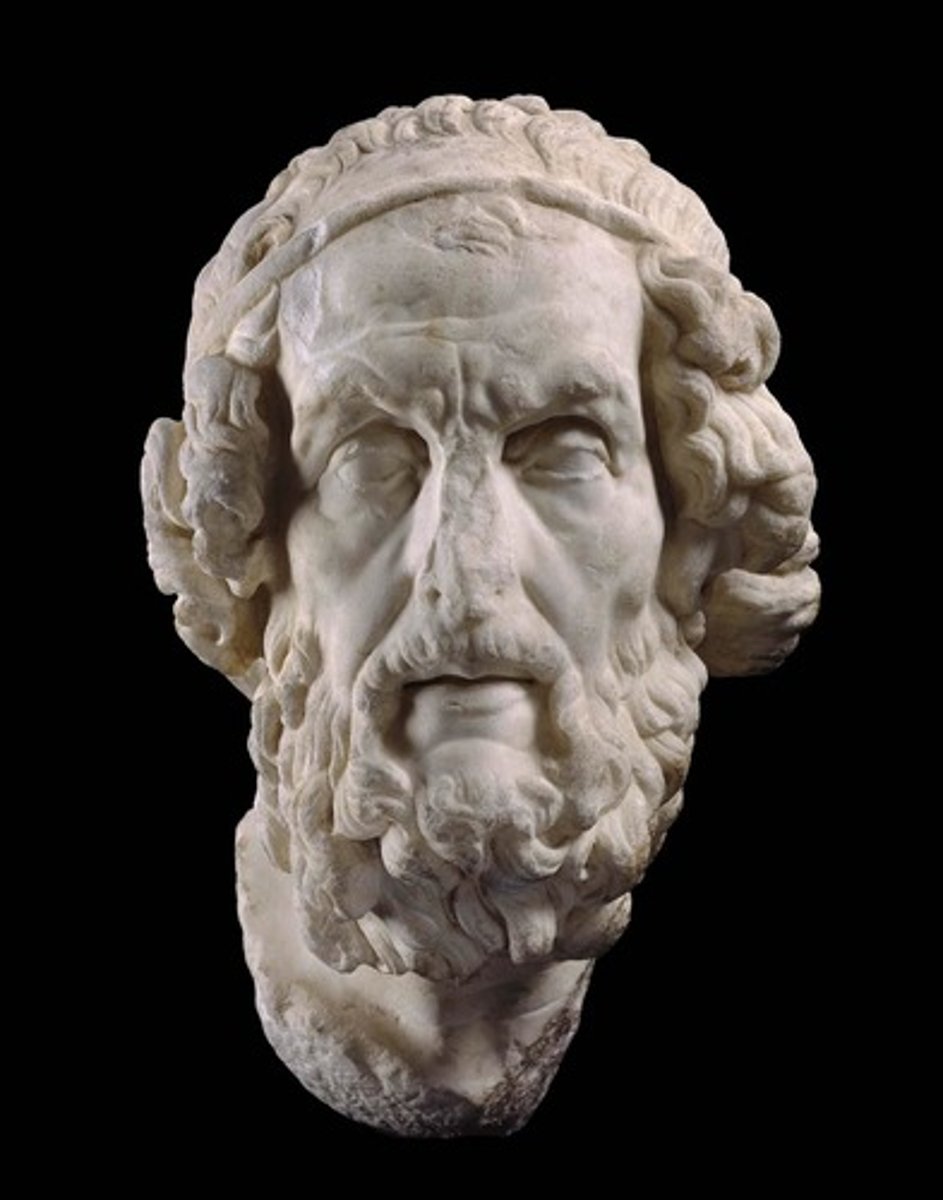
Homer
- 2nd cent bce (high/late hellenistic pd)
- from rome (Italy)
- depicts Homer, blind poet who created the Iliad and the Odyssey
- statue is blind, lack of pupils
- headband and full beard = important figure
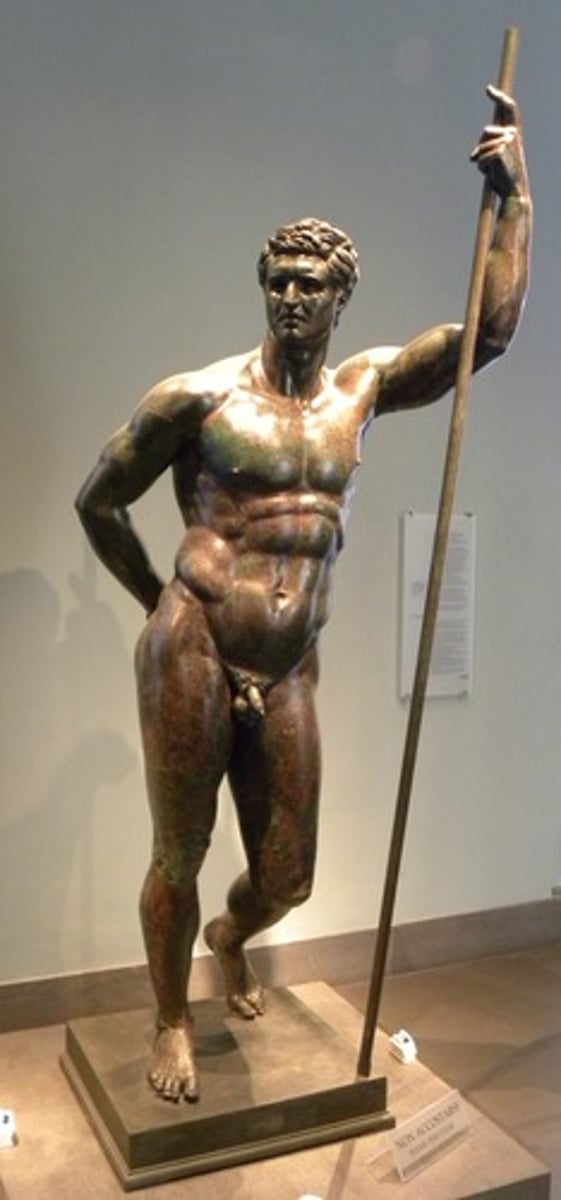
Hellenistic Ruler
- 150 bce (high/late hellenistic pd)
- found in Roman house on the Esquiline (italy)
- bronze original
- depicts young hellenistic ruler with heavy and over-muscular body
- has thin/short beard depicted by carvings in the face
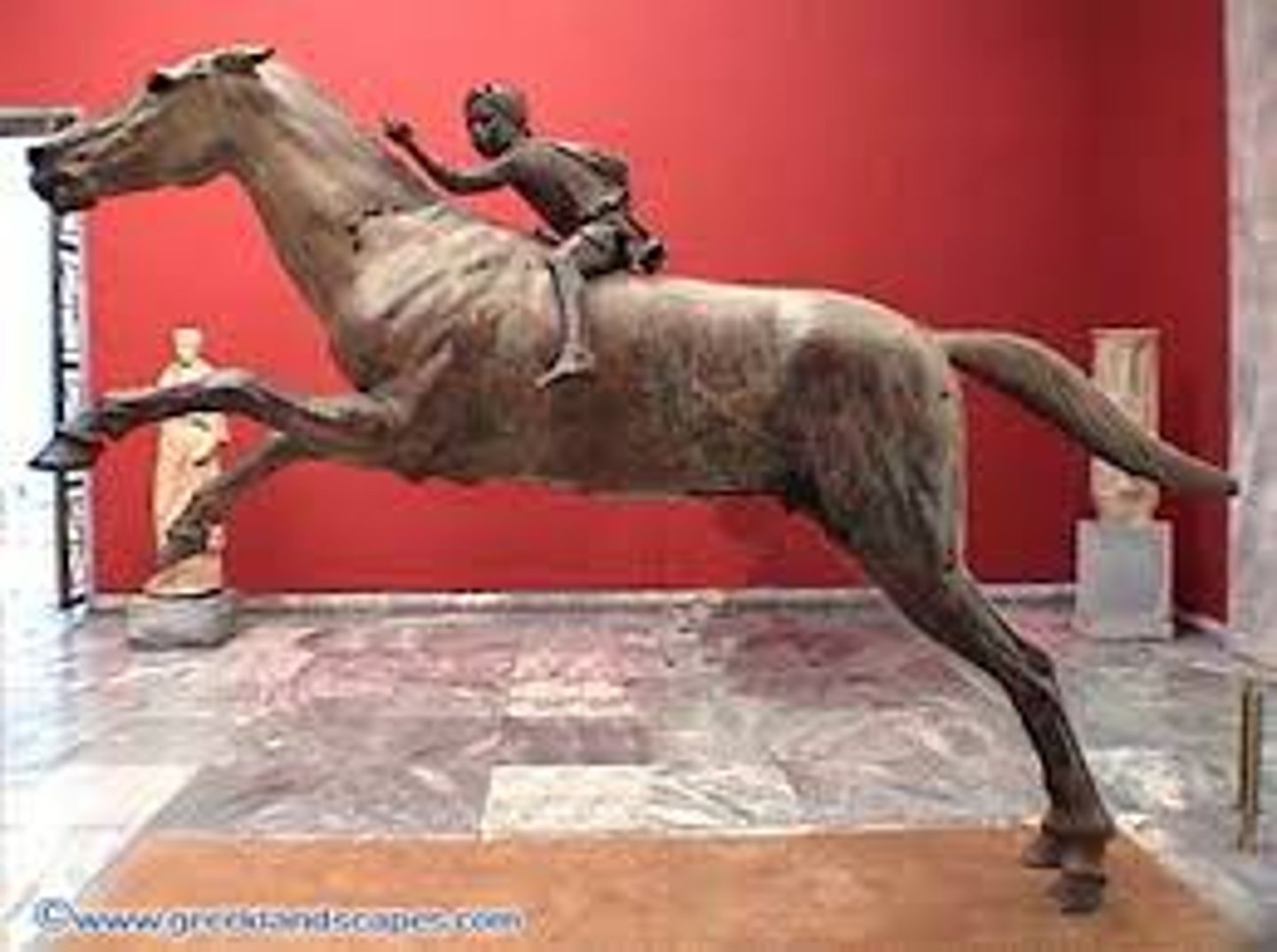
Bronze Boy Jockey
- 200-150 bce (high hellenistic pd)
- recovered from shipwreck off of Cape Artemision, likely headed to Rome
- Boy is depicted as foreigner, therefore small in size compared to the Roman horse
- horse is branded with inscription of Nike crowning victory
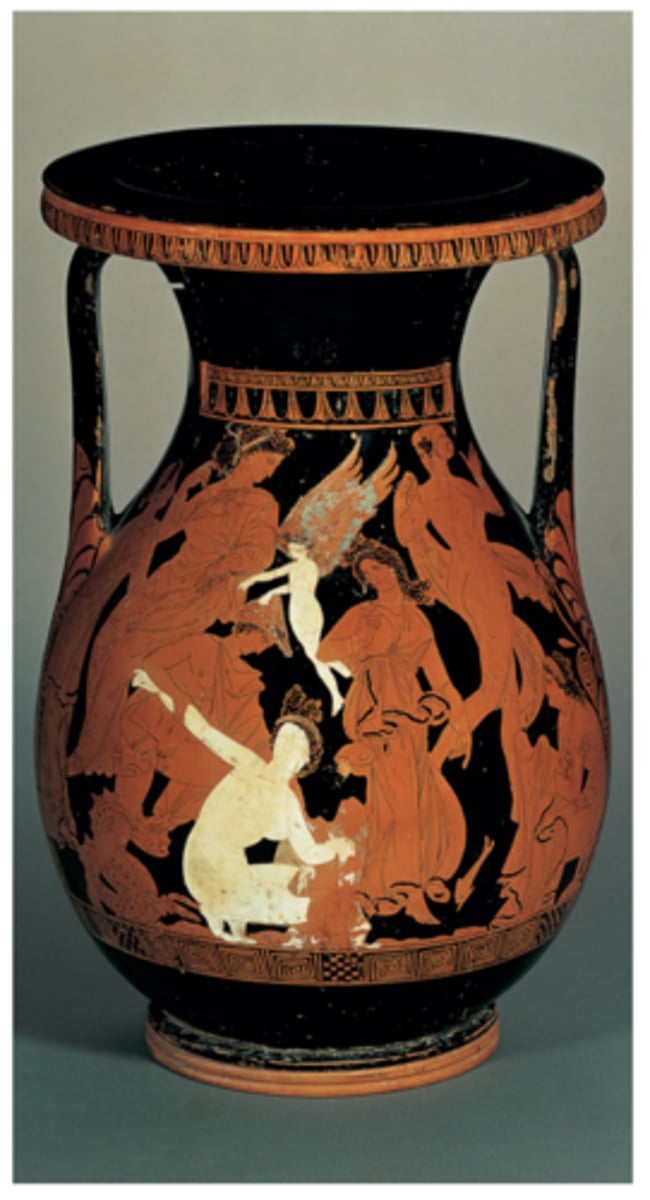
Attic red figure pelike
- 360-350 bce (late classical pd)
- by Marsyas Painter
- from athens???
- depicts peleus, thetis, eros, and nymphs
- interest in fully nude female figures (new)
- white is used to signify nudity (clothed women are depicted in red figure)
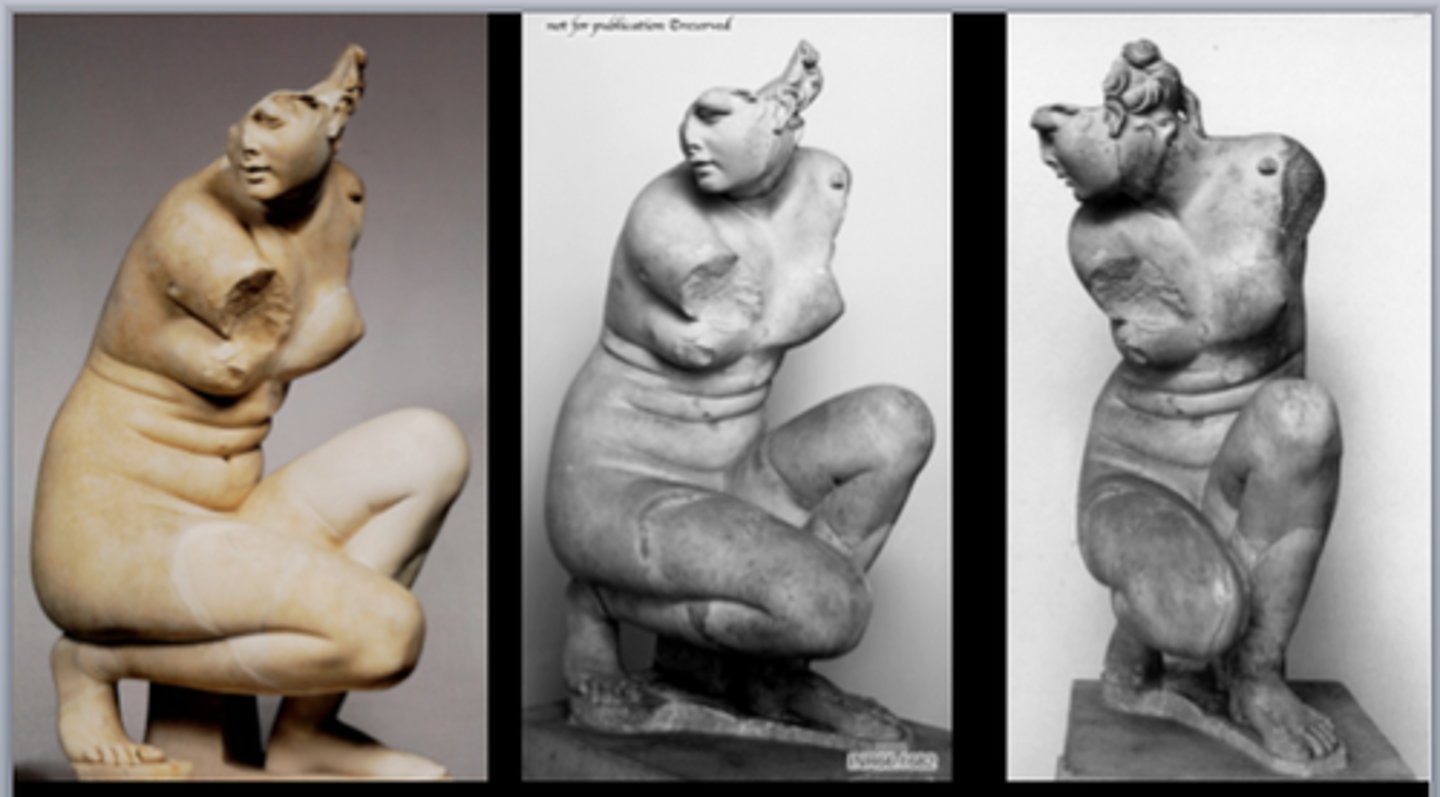
Aphrodite by Doidalsas
- 200-150 bce (high hellenistic pd)
- from Anatolia (asia minor)
- by Doidalsas
- roman copy
- new crouching pose
- aphrodite is surprised at her bath, hence why she is crouched and covering herself
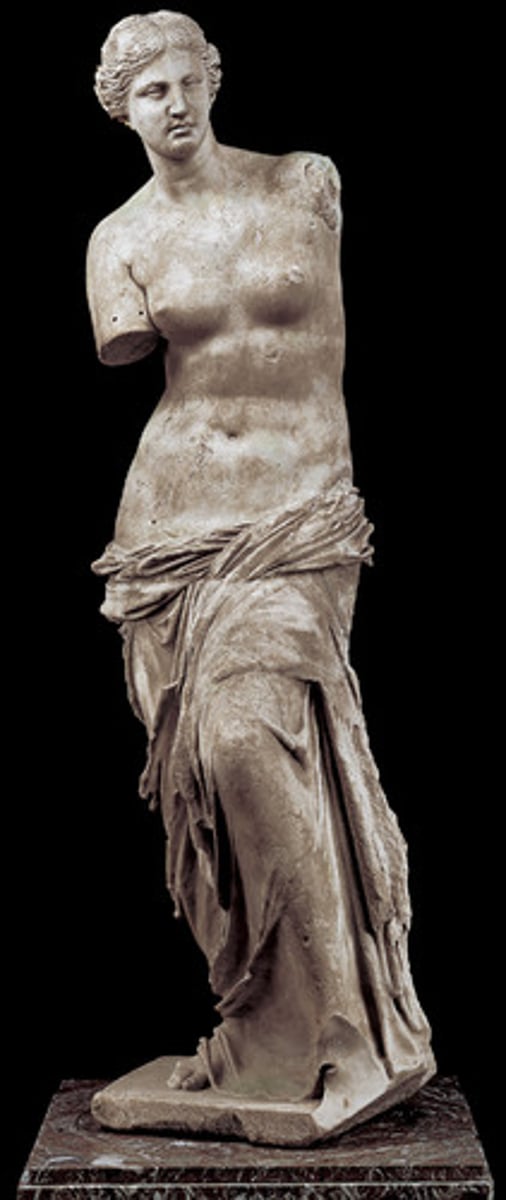
Aphrodite from Melos
- 125-75 bce (late hellenistic pd)
- from Melos (cyclades)
- by Alexandros of Antioch
- depicts praxitelean S-curve; face and anatomy is late classical type
- "venus de milo"
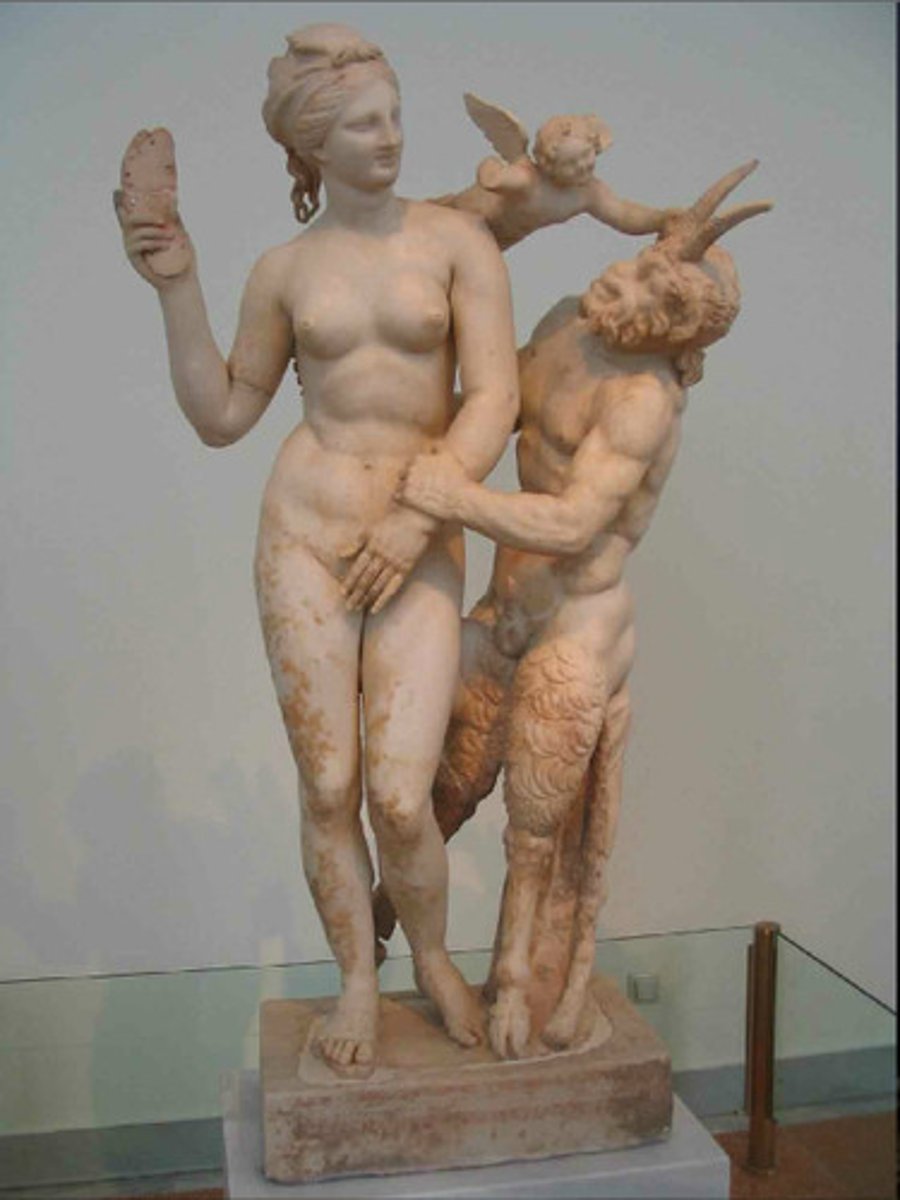
Aphrodite with Slipper from Delos
- 100 bce (late hellenistic pd)
- from clubhouse of the Poseidoniasts of Berytos (Delos)
- by Dionysios of Beryttos
- "slipper-slapper group"
- depicts aphrodite, pan, and eros; nude aphrodite rebuffs an importunate Pan, one hand sheilding genitals while another holds a slipper; Eros is seen between the two playfully pushing Pan away
- mood is good humored and gently erotic
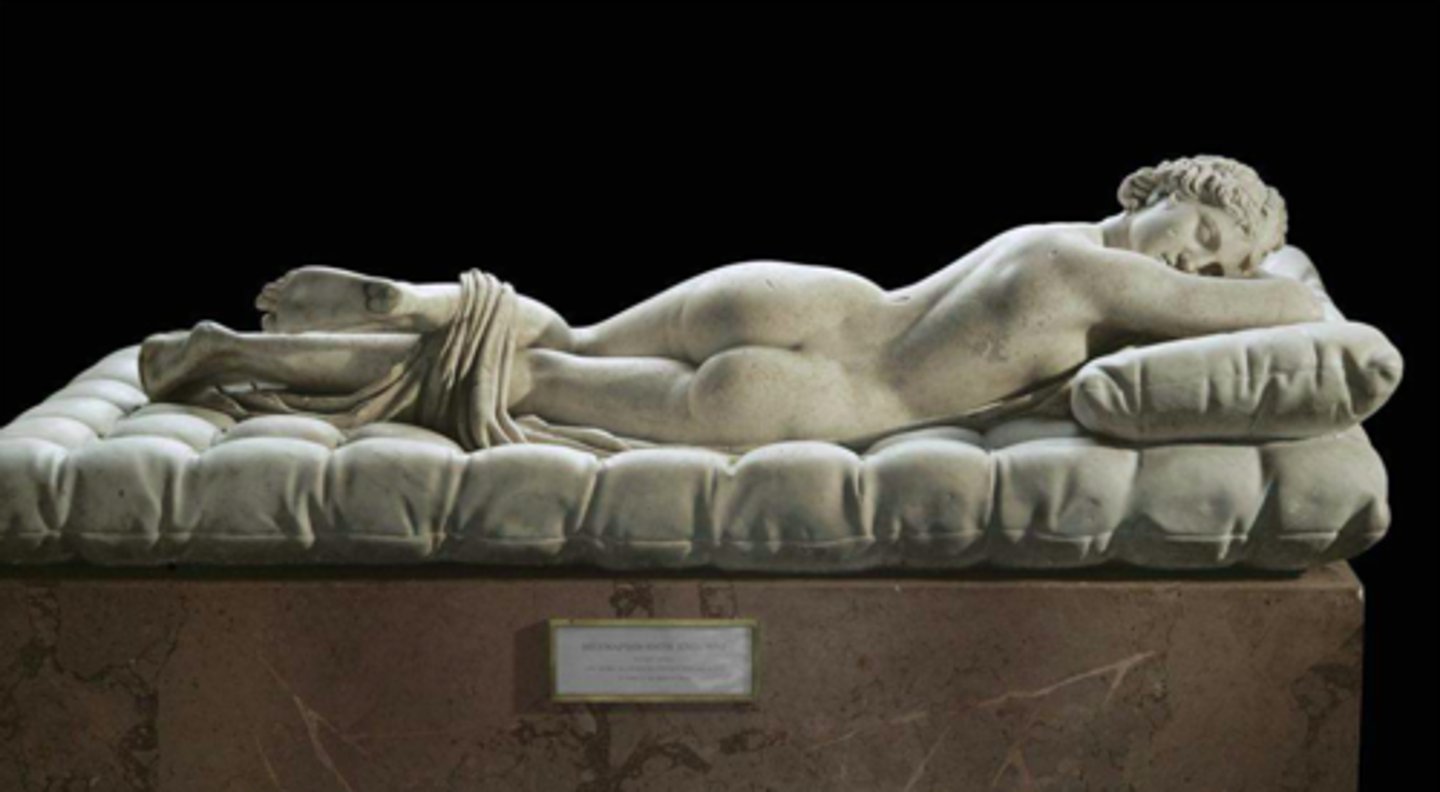
Sleeping Hermaphrodite
- 2nd century BCE (high/late hellenistic pd)
- found in Rome (Italy)
- original sculptor is unknown; Bernini sculpted the mattress the figure lays on in 1600s
- depictions of hermaphrodites was increasingly common in hellenistic period
- you have to look from back side of sculpture to really see that it is a hermaphrodite (common in this period for pieces intended to be viewed from different angles)
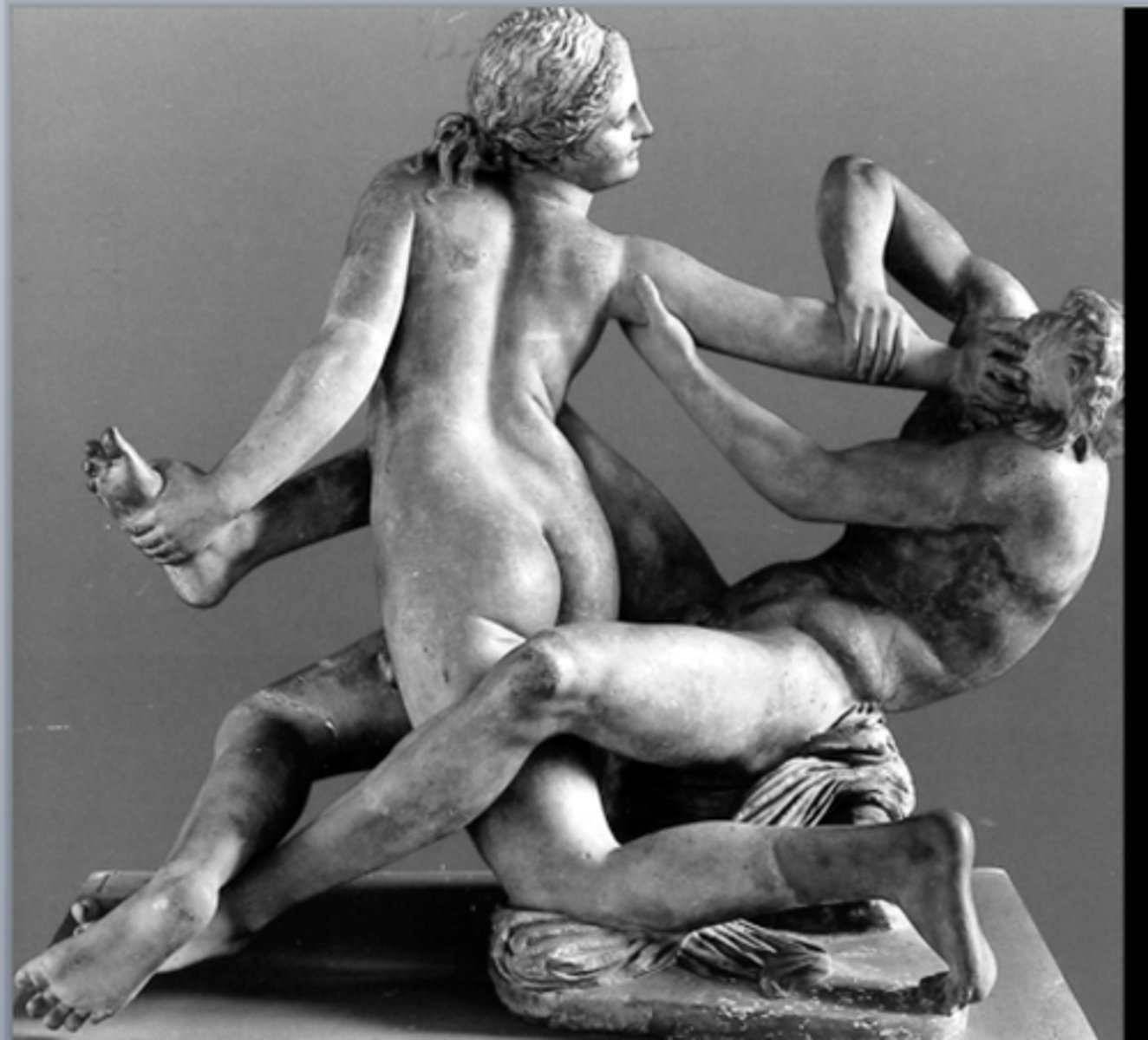
Satyr and Hermaphrodite
- 2nd cent bce (high/late hellenistic pd)
- from rome (italy)
- depicts satyr and hermaphrodite in a shuffle
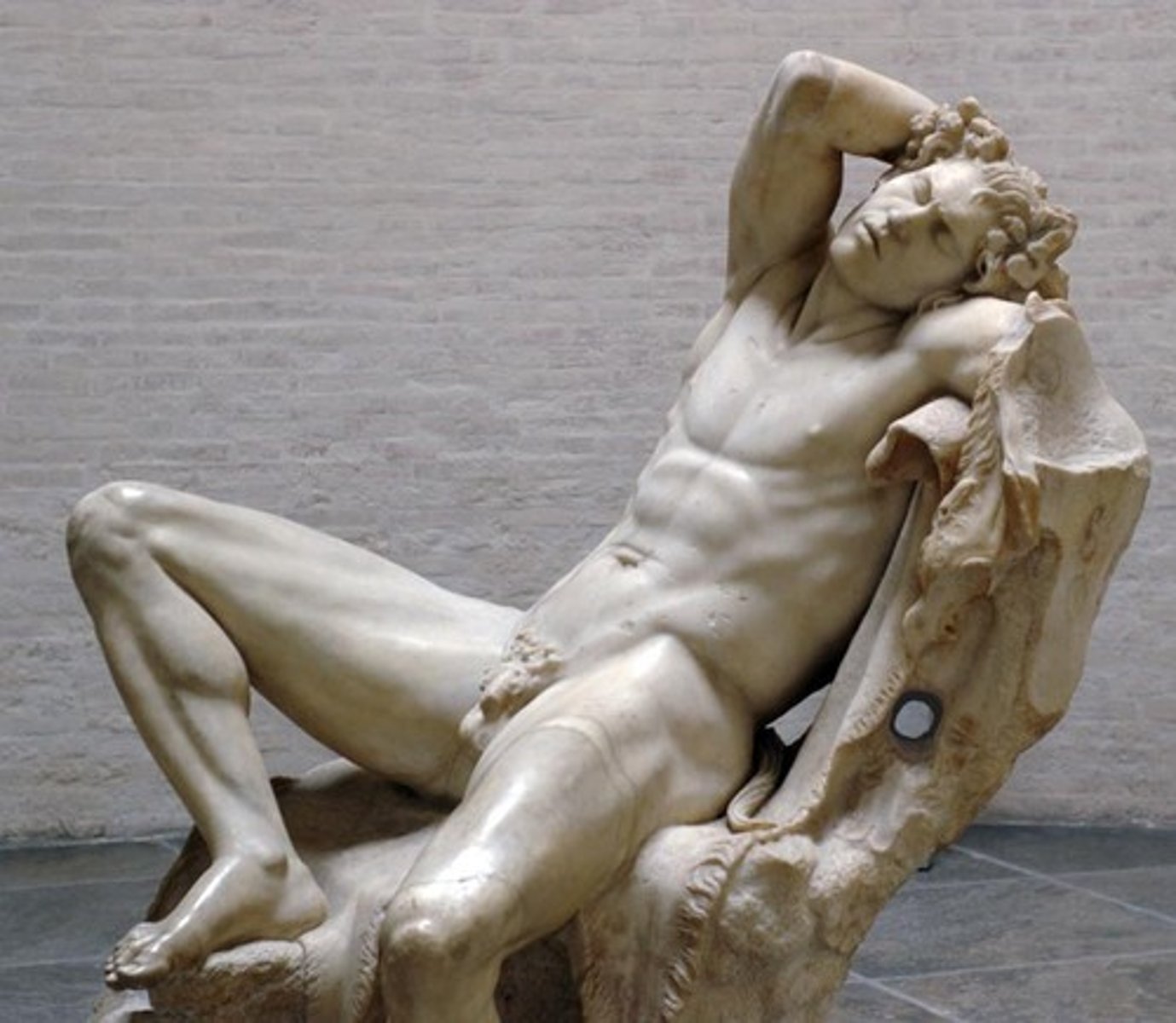
Faun Barberini
- 220 bce (high hellenistic pd)
- from Pergamon ??
- by Giuseppe Giorgetti ??
- depicts a sleeping faun, roman equivalent of the greek satyr
- shows mind at rest & body relaxed
- restored by Bernini in 1600s
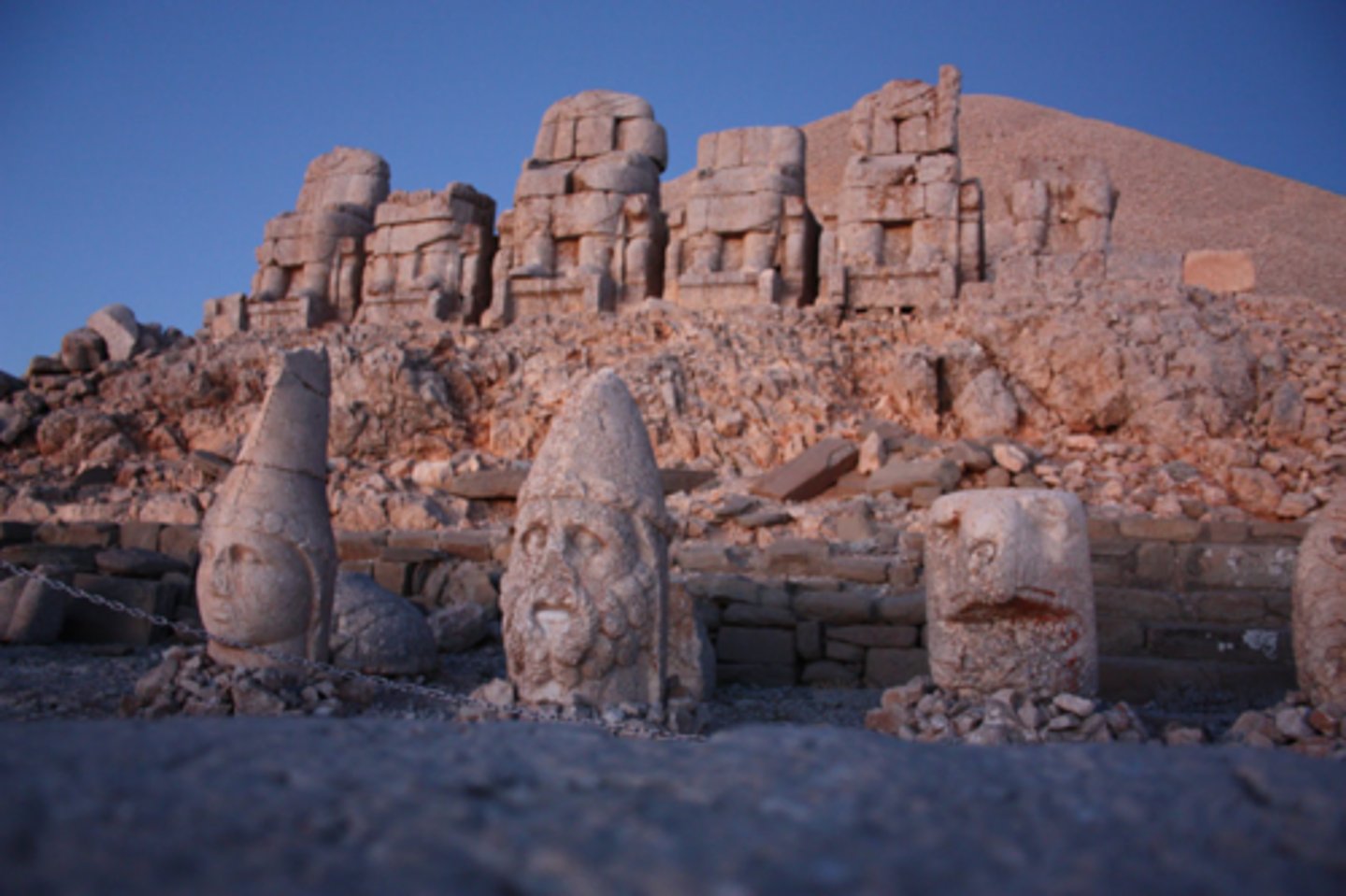
Mount Nemrut
- 50-35 bce (late hellenistic pd)
- in southeastern Turkey (asia minor)
- built by King Antiochus I of Commagene
- summit where a number of large statues are erected around what is assumed to be a royal tomb
- statues include King Antiochus I, two lions, two eagles, and various greek & iranian gods (including herakles, apollo, hermes, and zeus)
- at one point, the heads of the statues were removed and are now placed variously all over the site
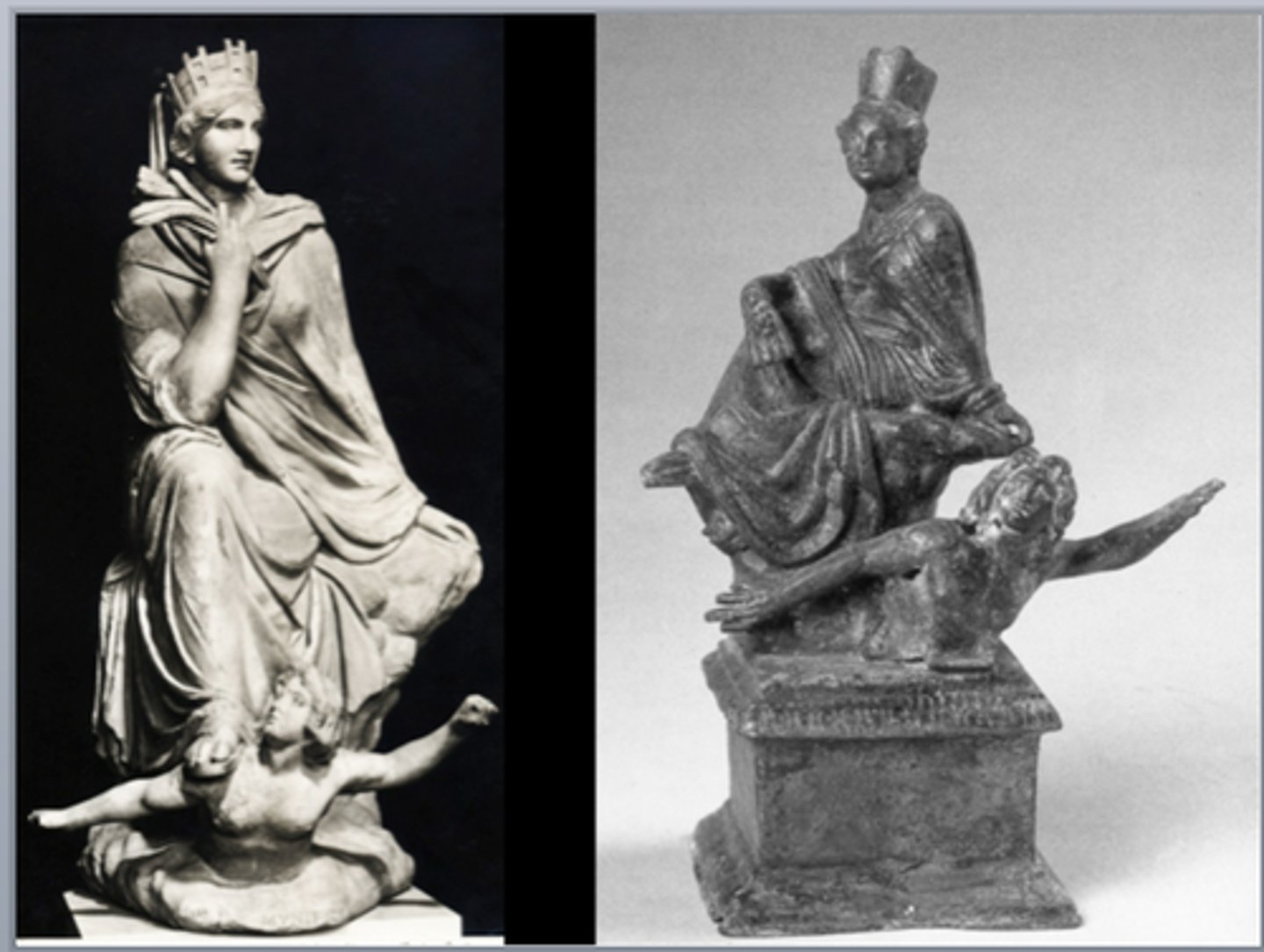
Tyche of Antiocheia
- 290-280 bce (early hellenistic pd)
- by Eutychides (pupil of Lysippos)
- from rome (italy)
- roman copy of bronze original
- full of symbols; female figure represents the wealth and good fortune of Antioch, a city in modern day turkey
- the man beneath her feet represents the Orontes river